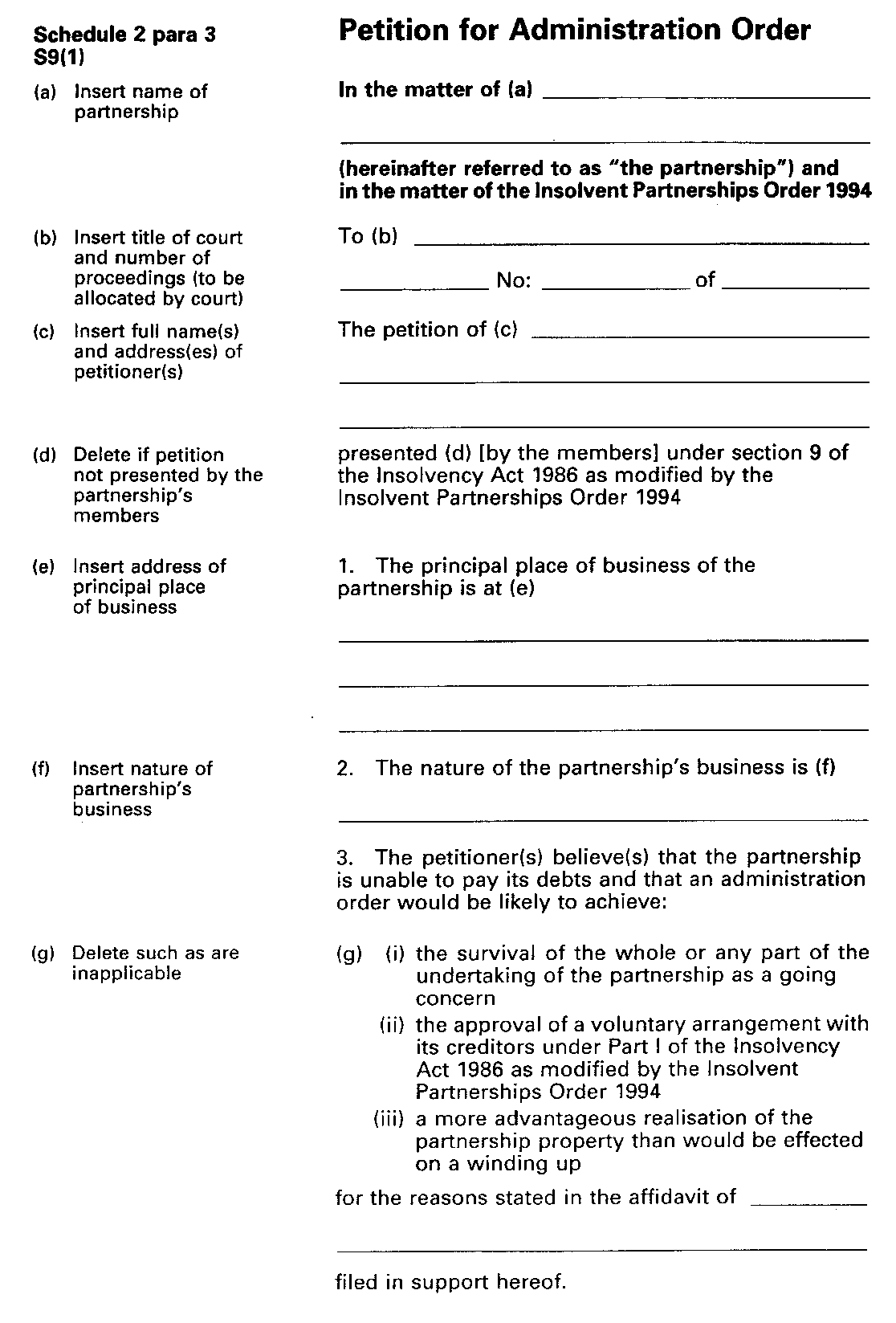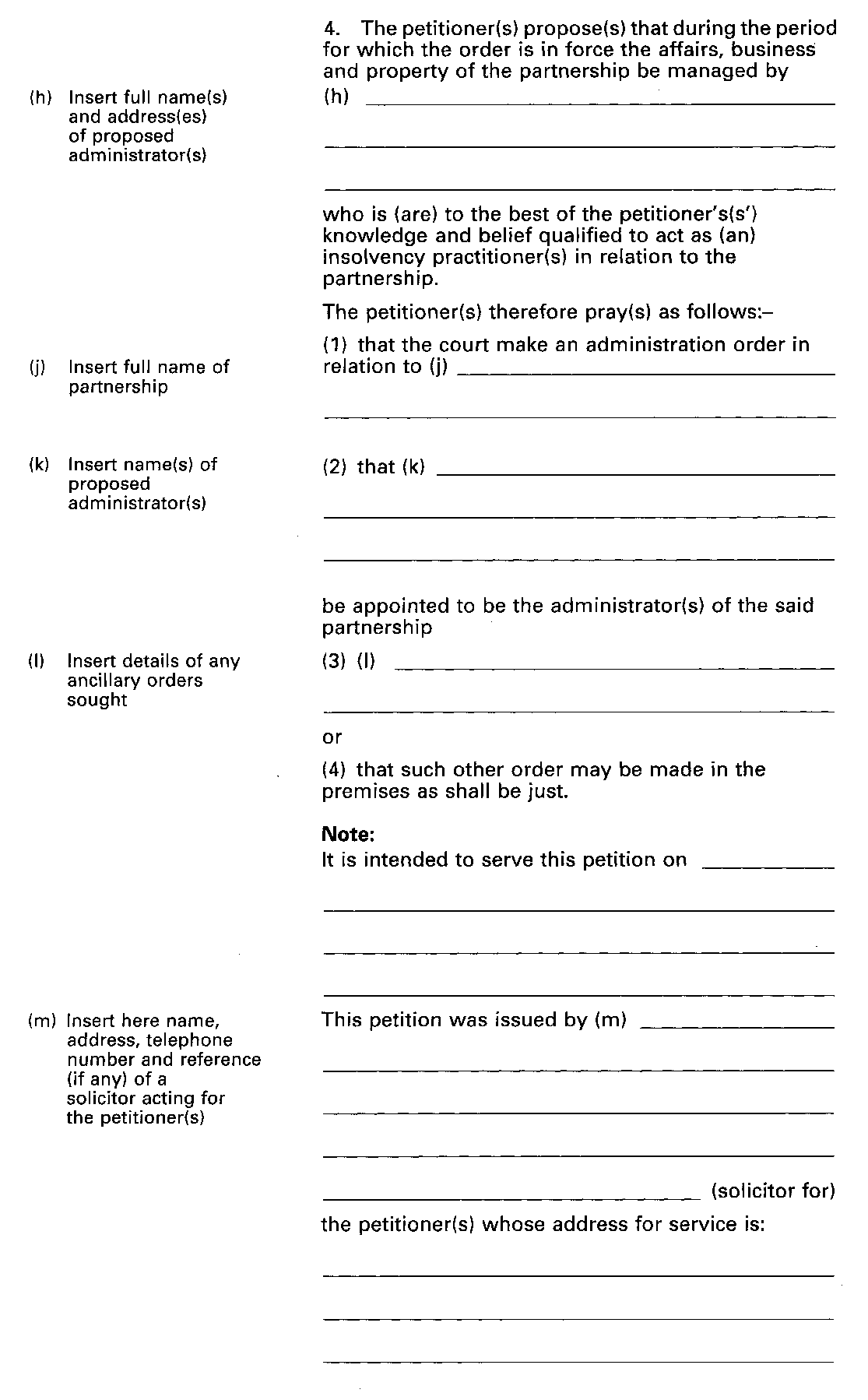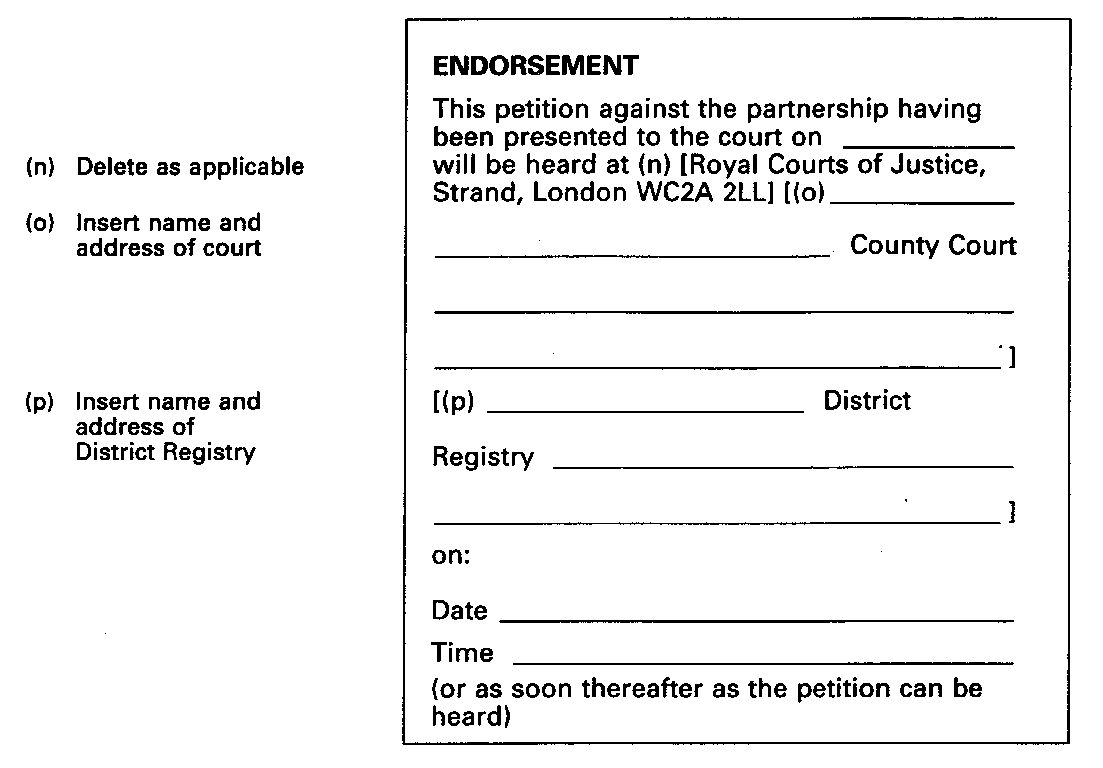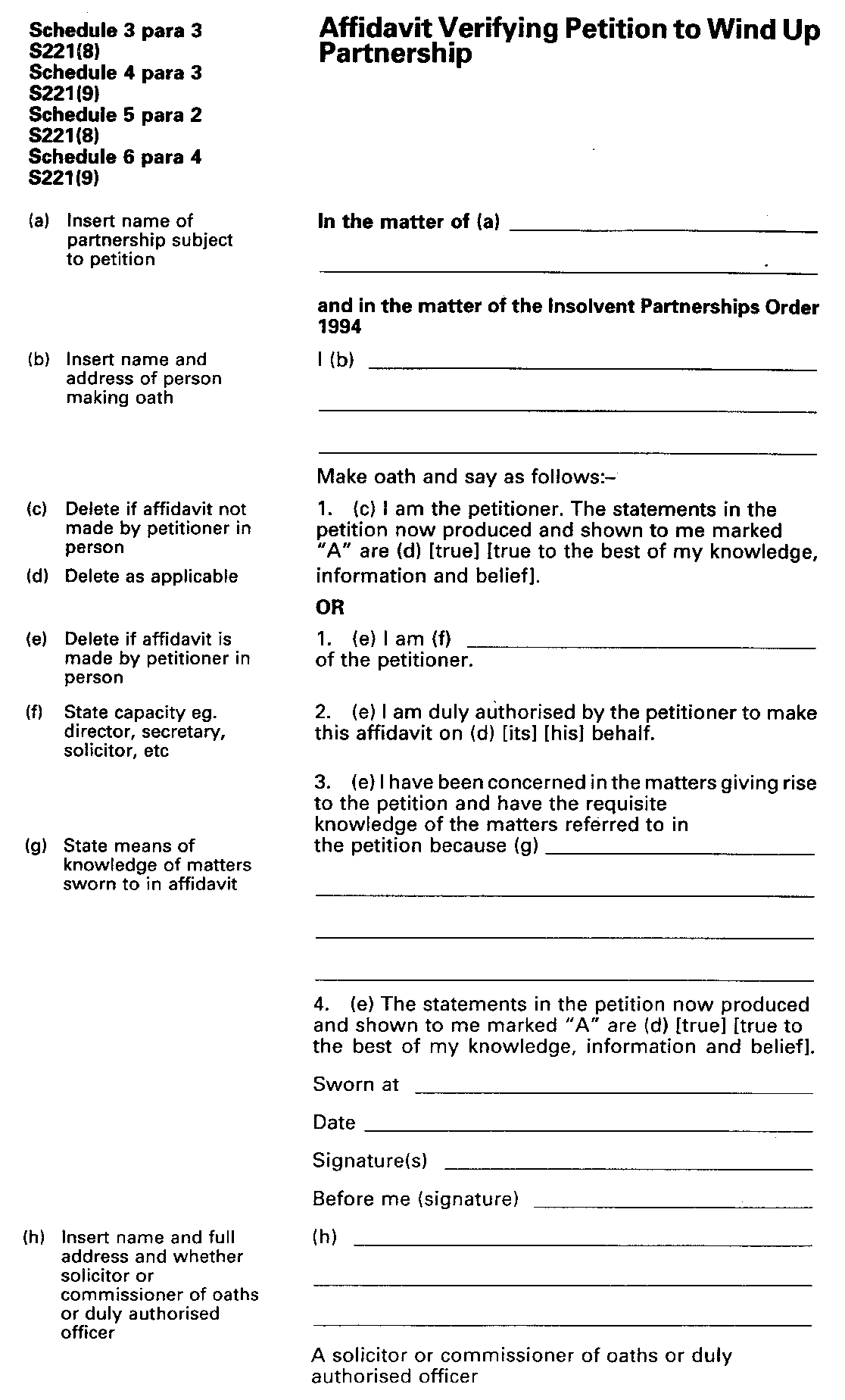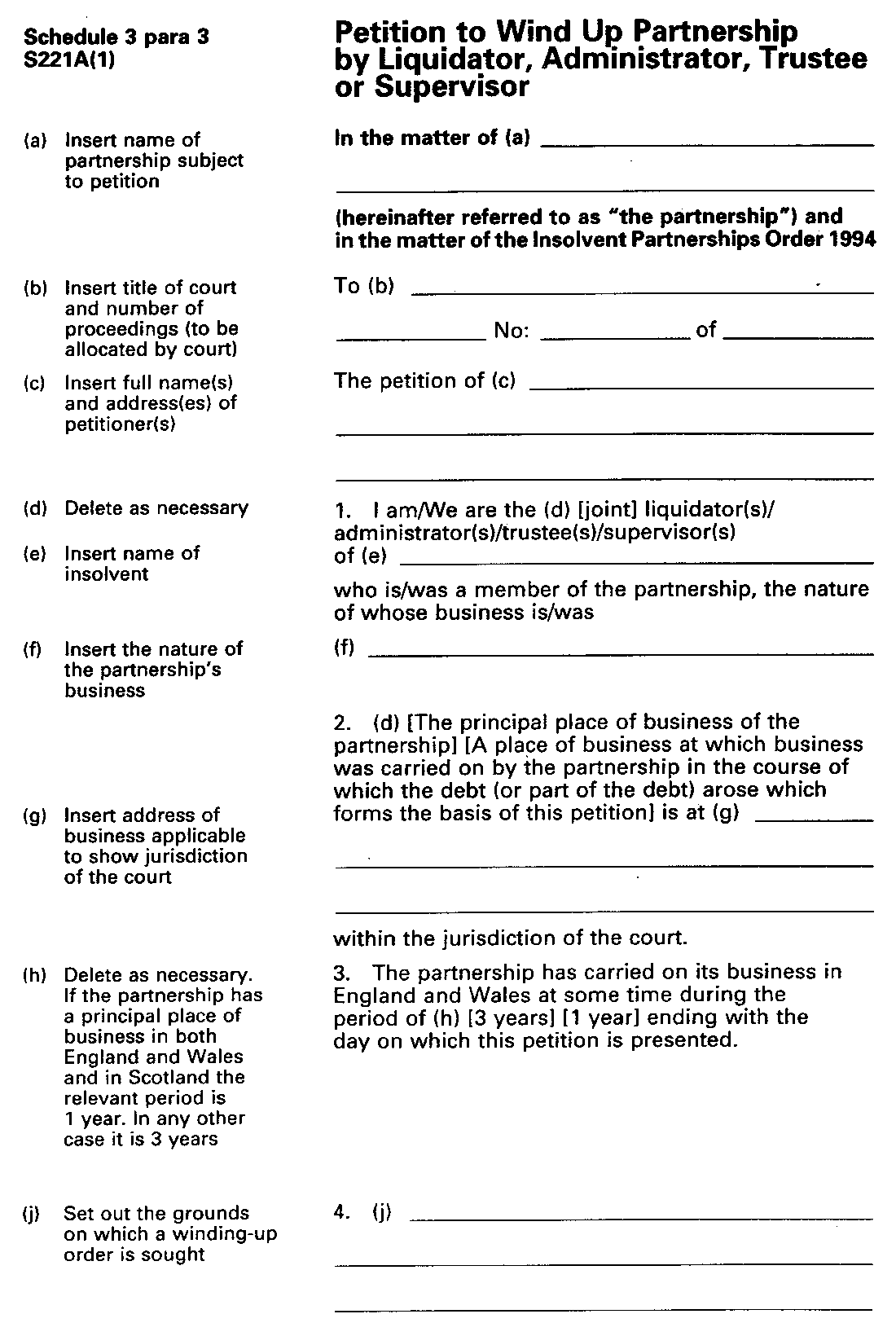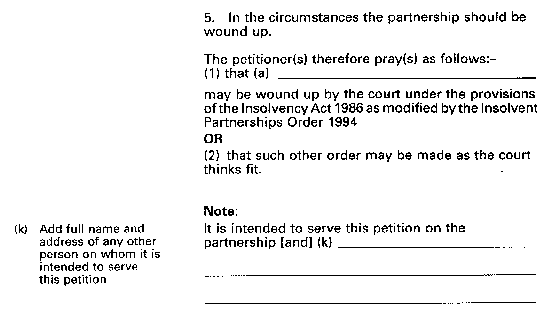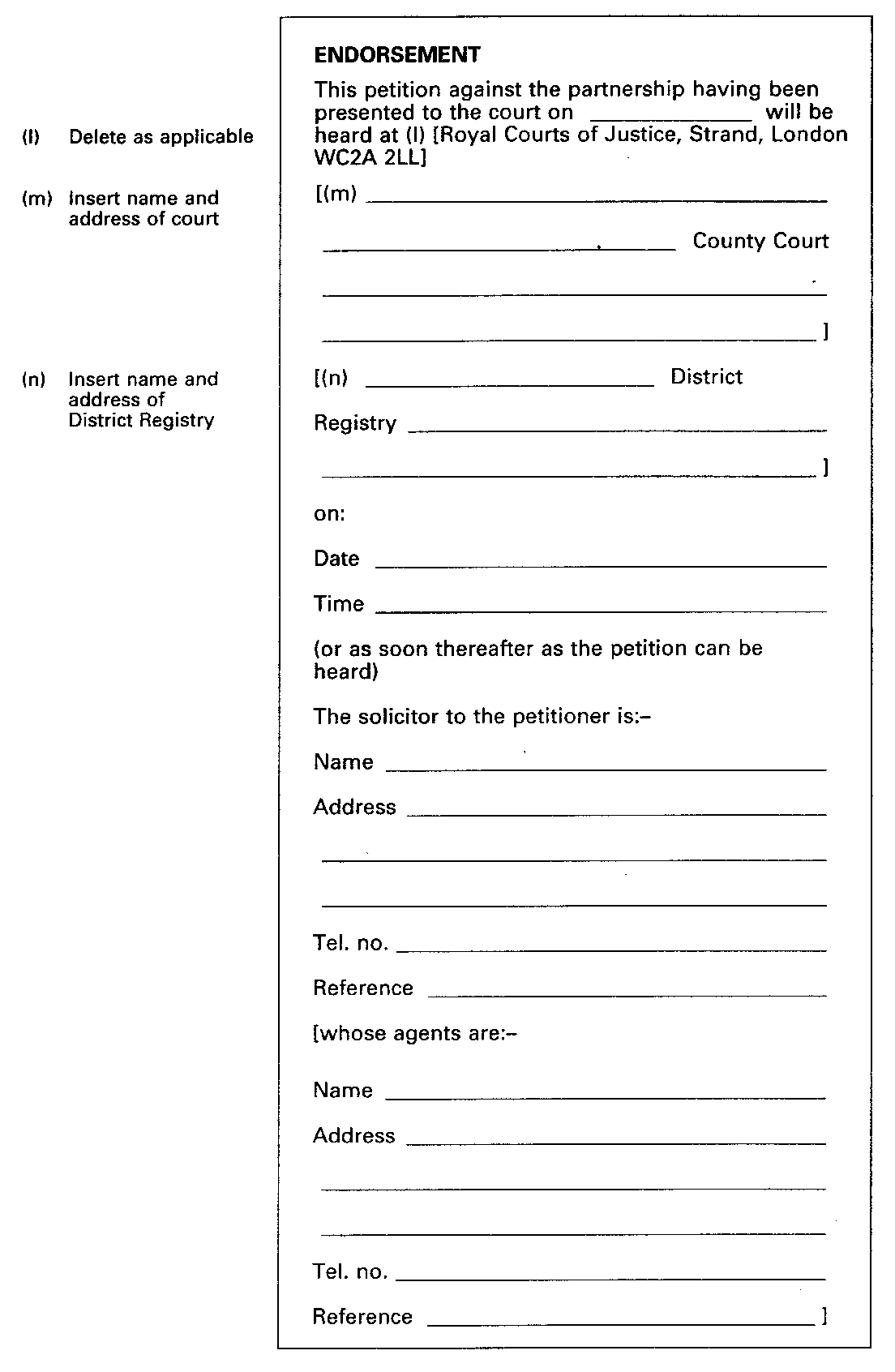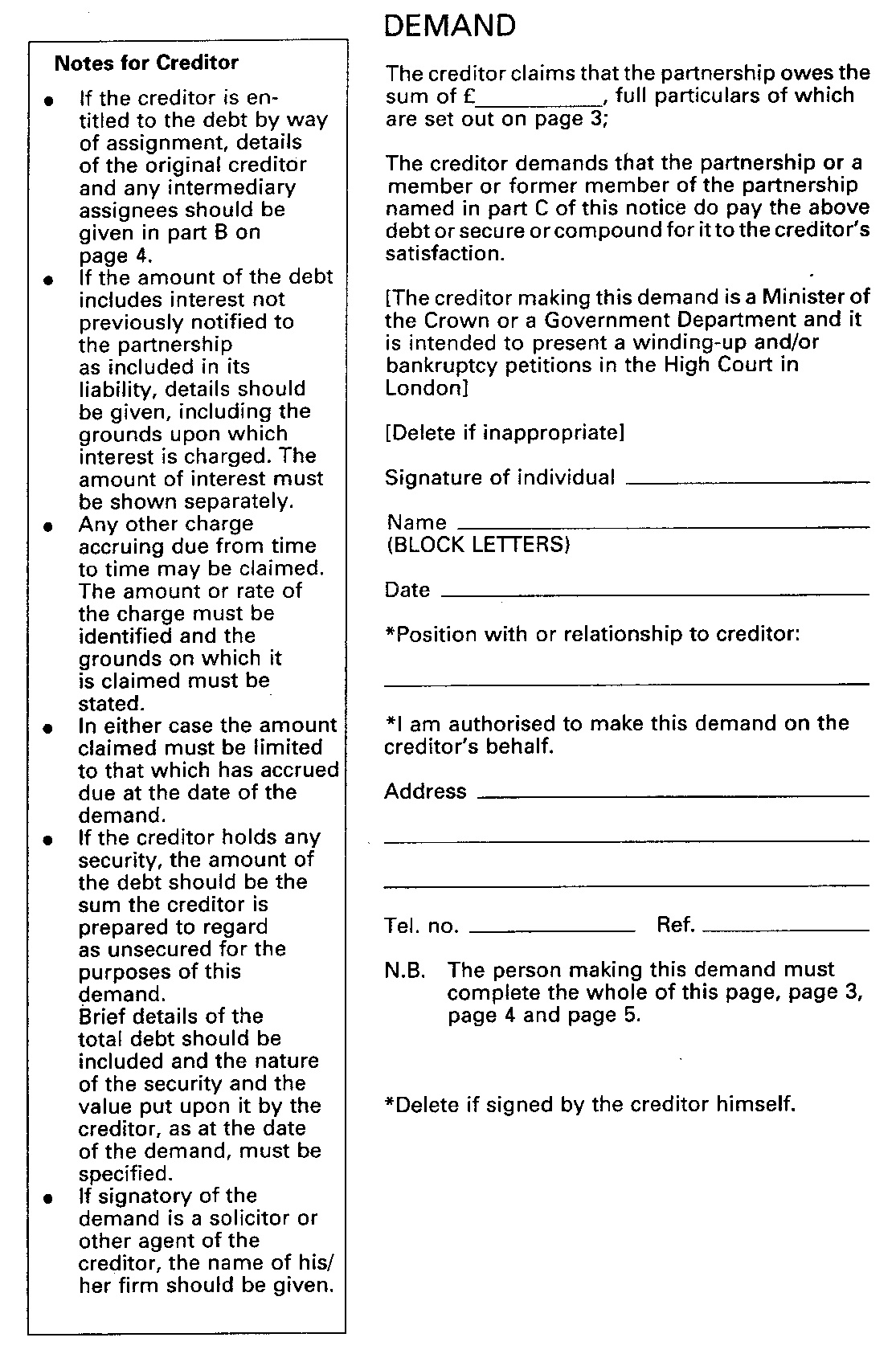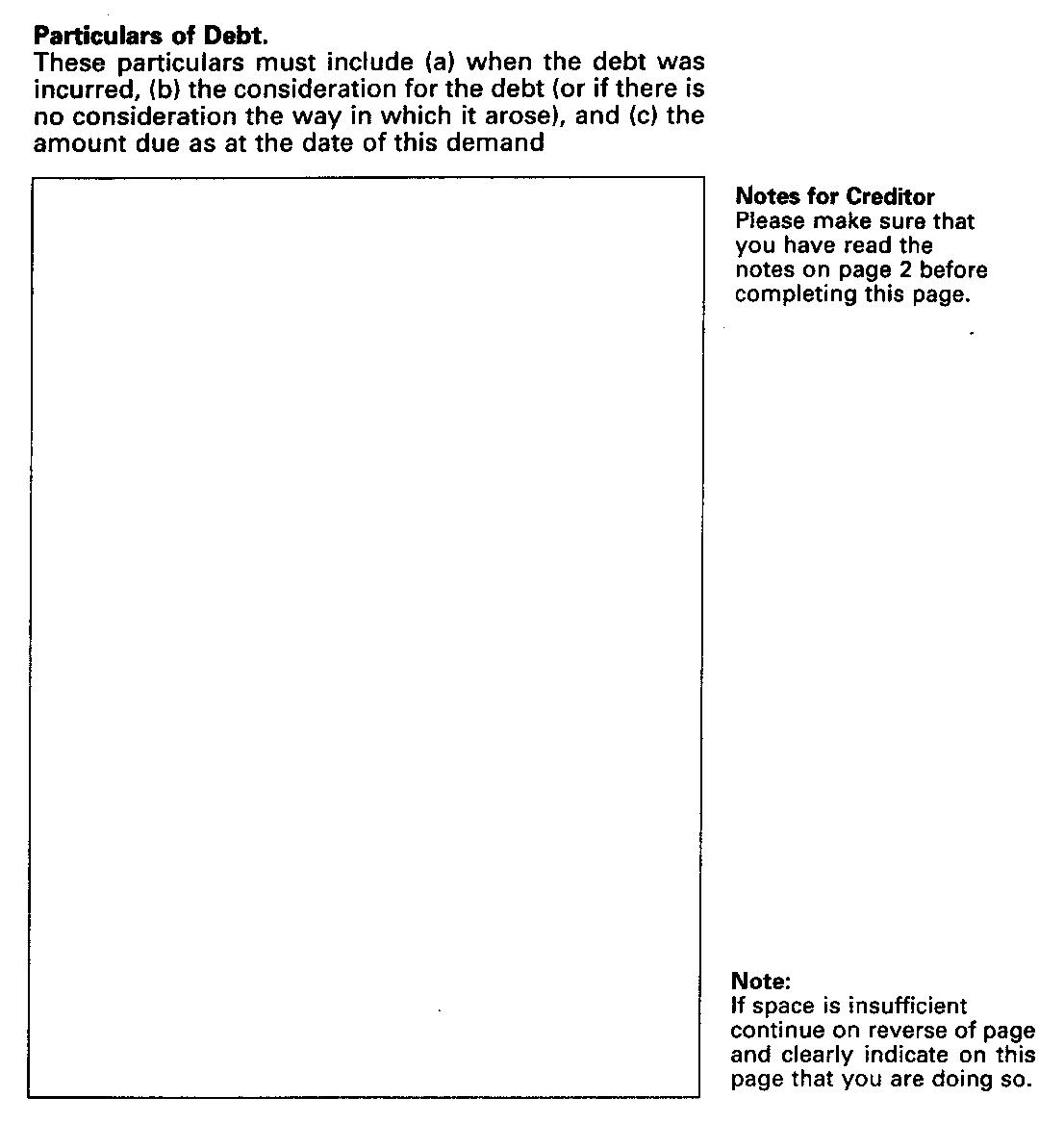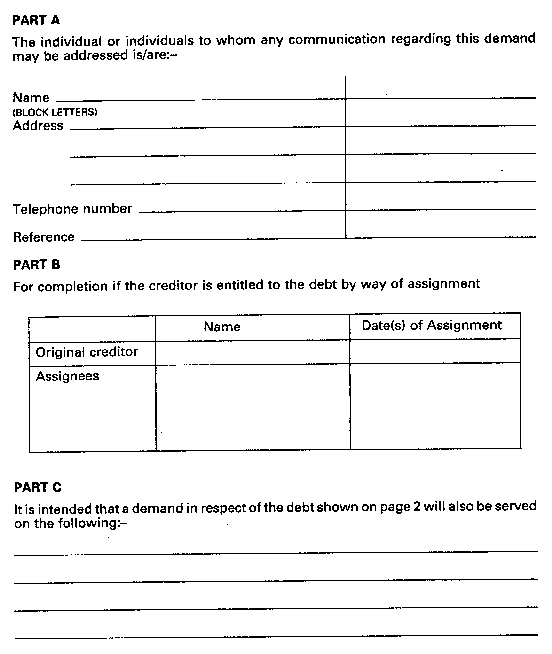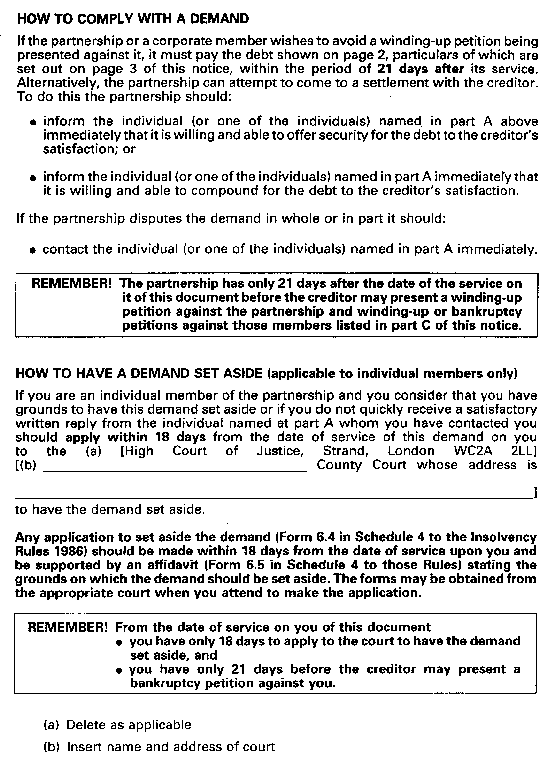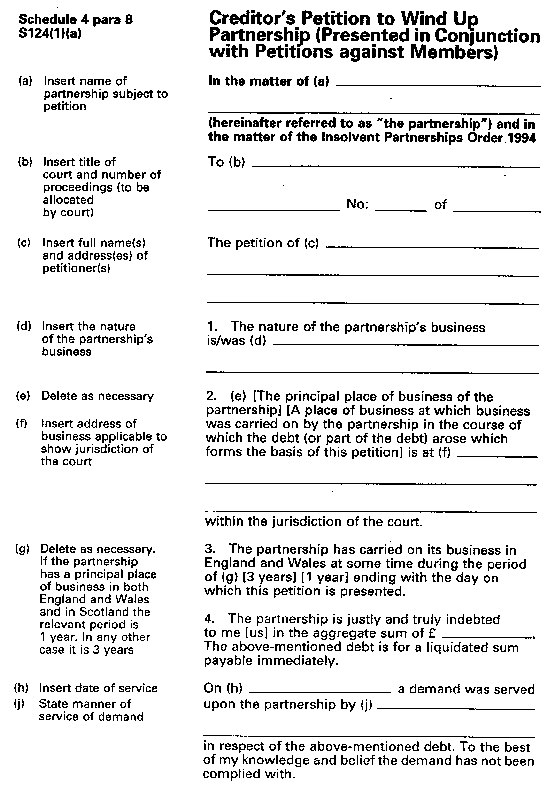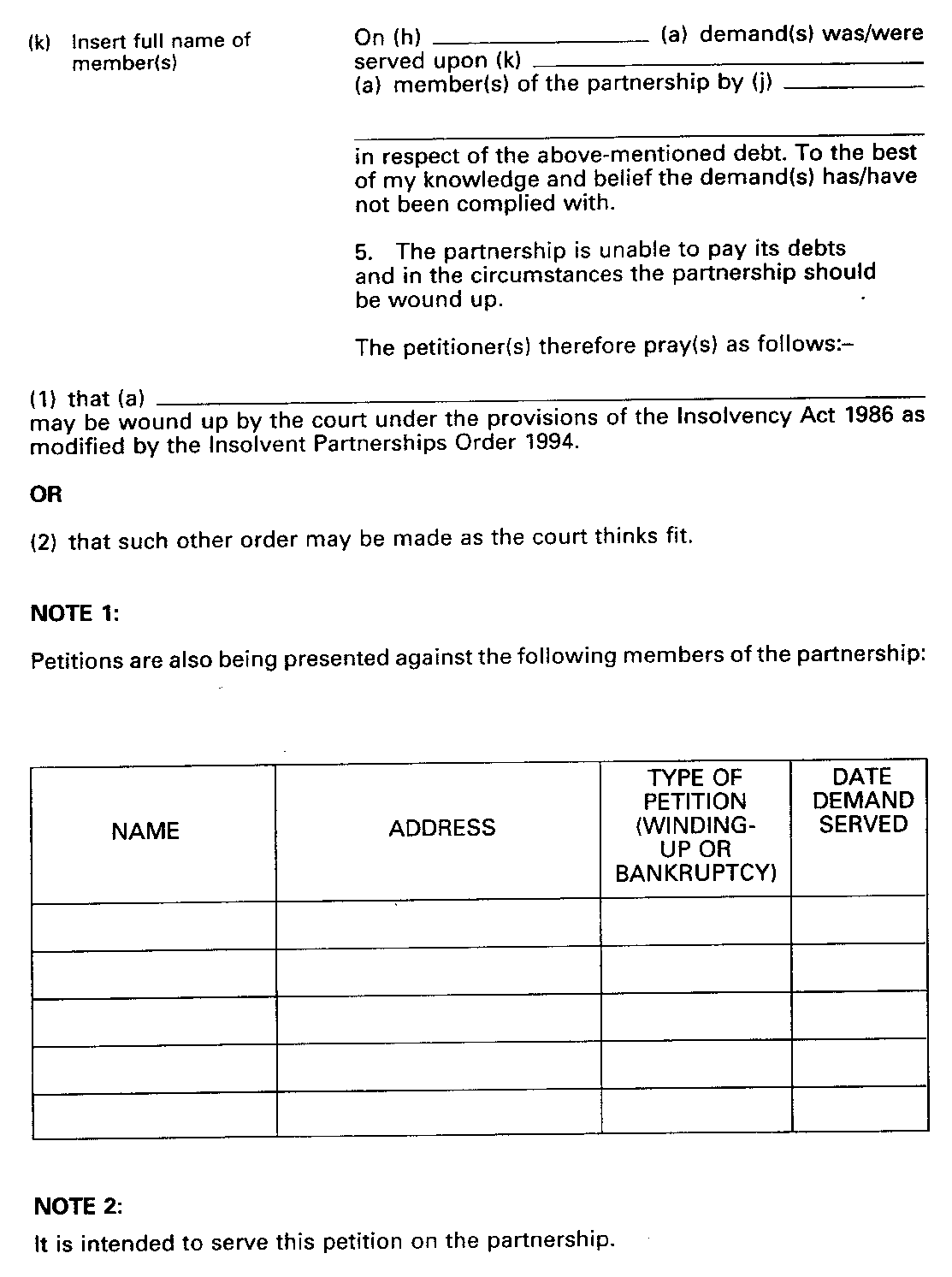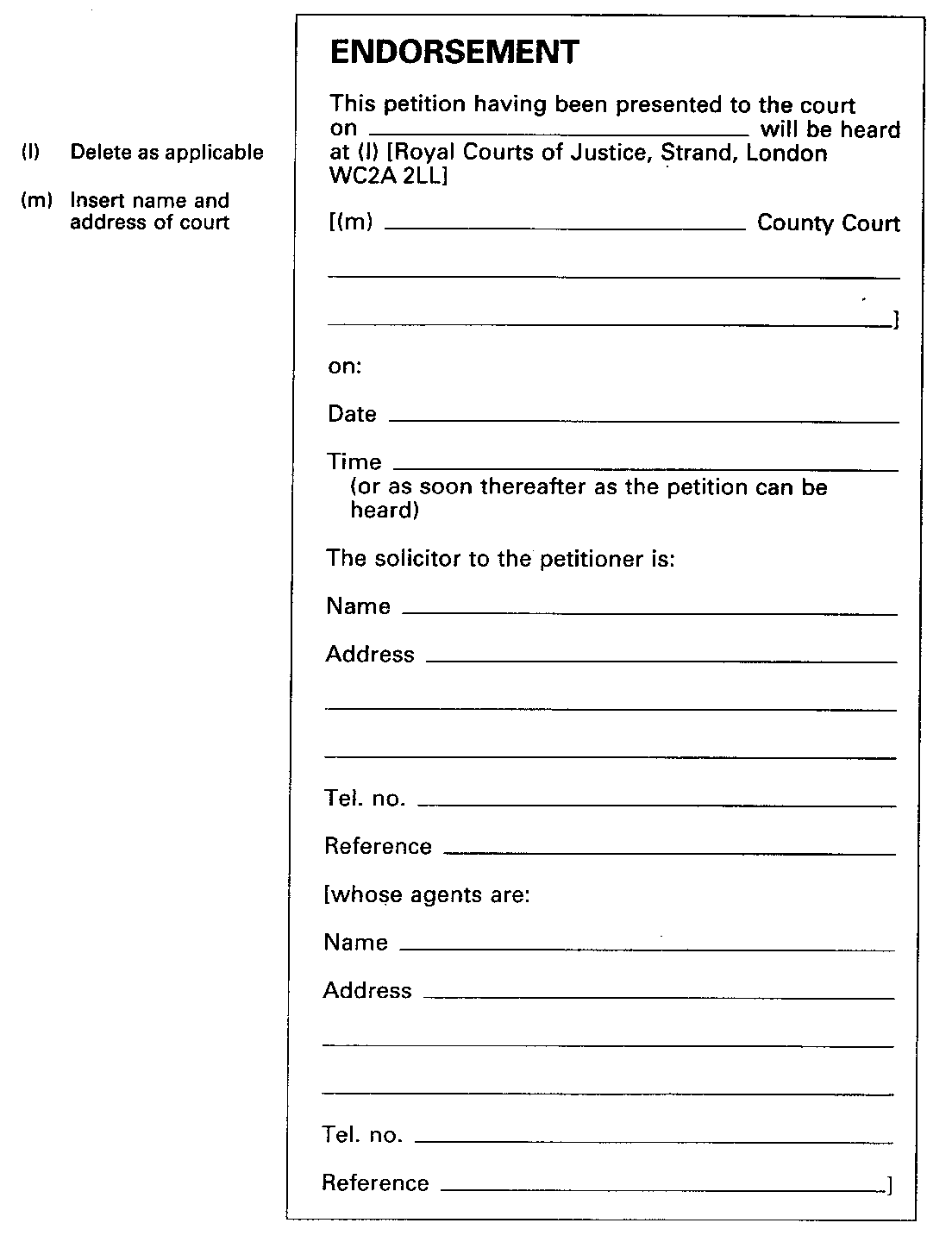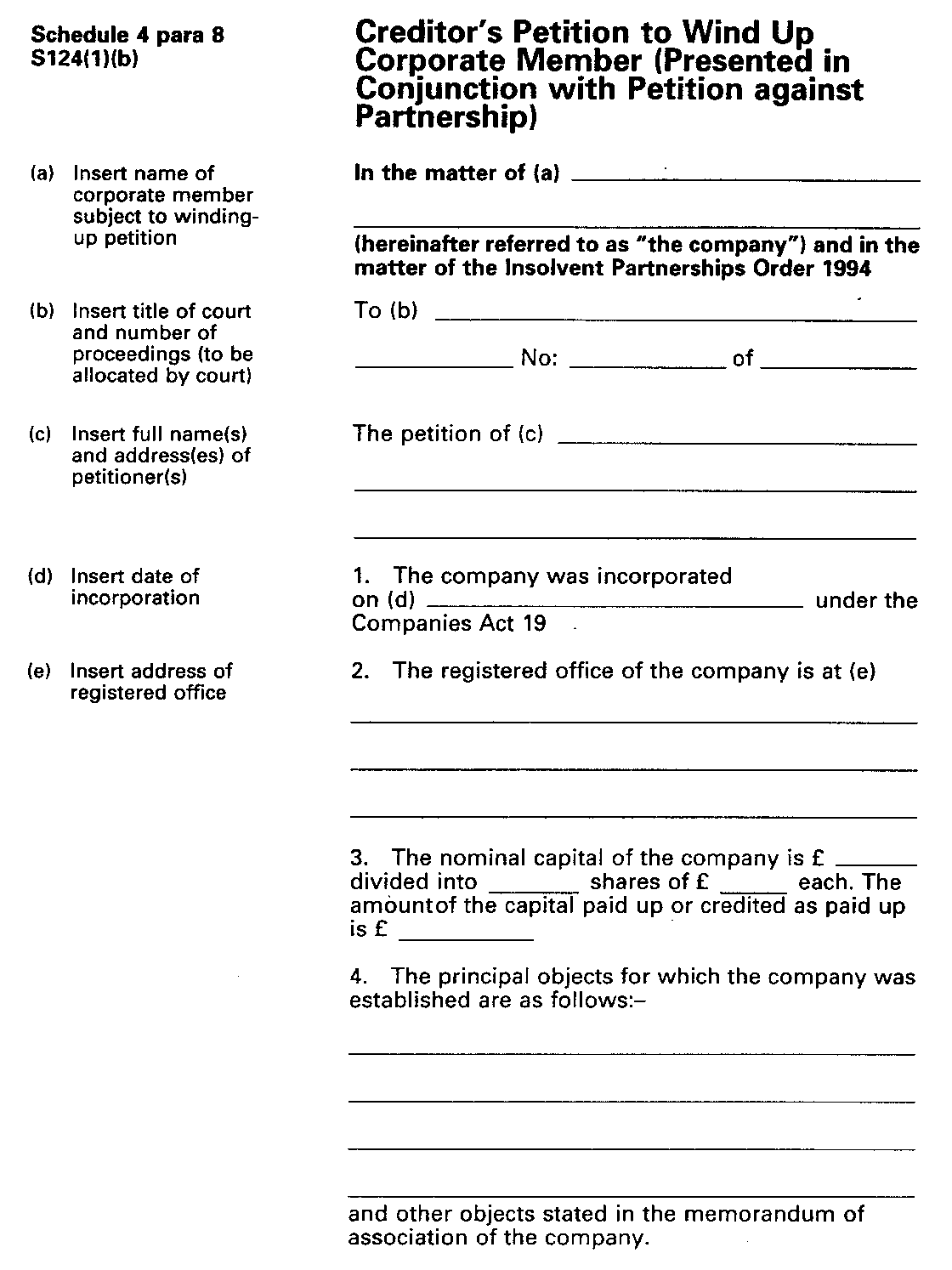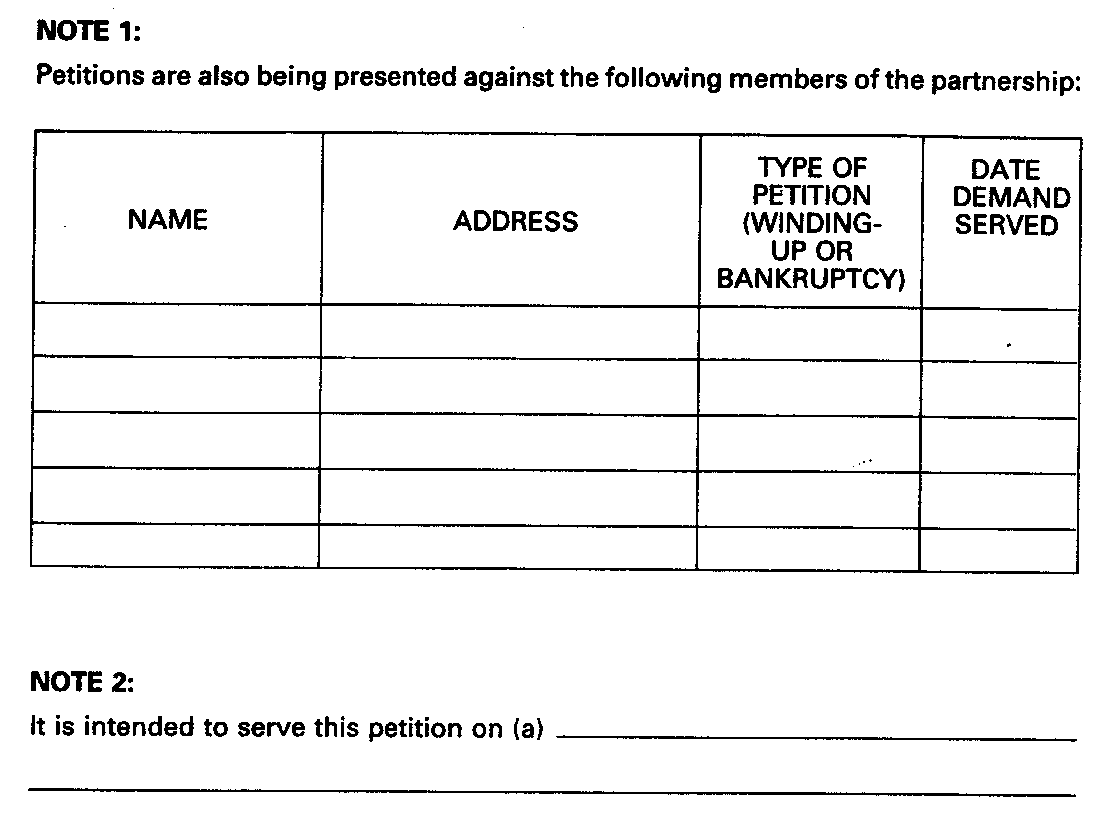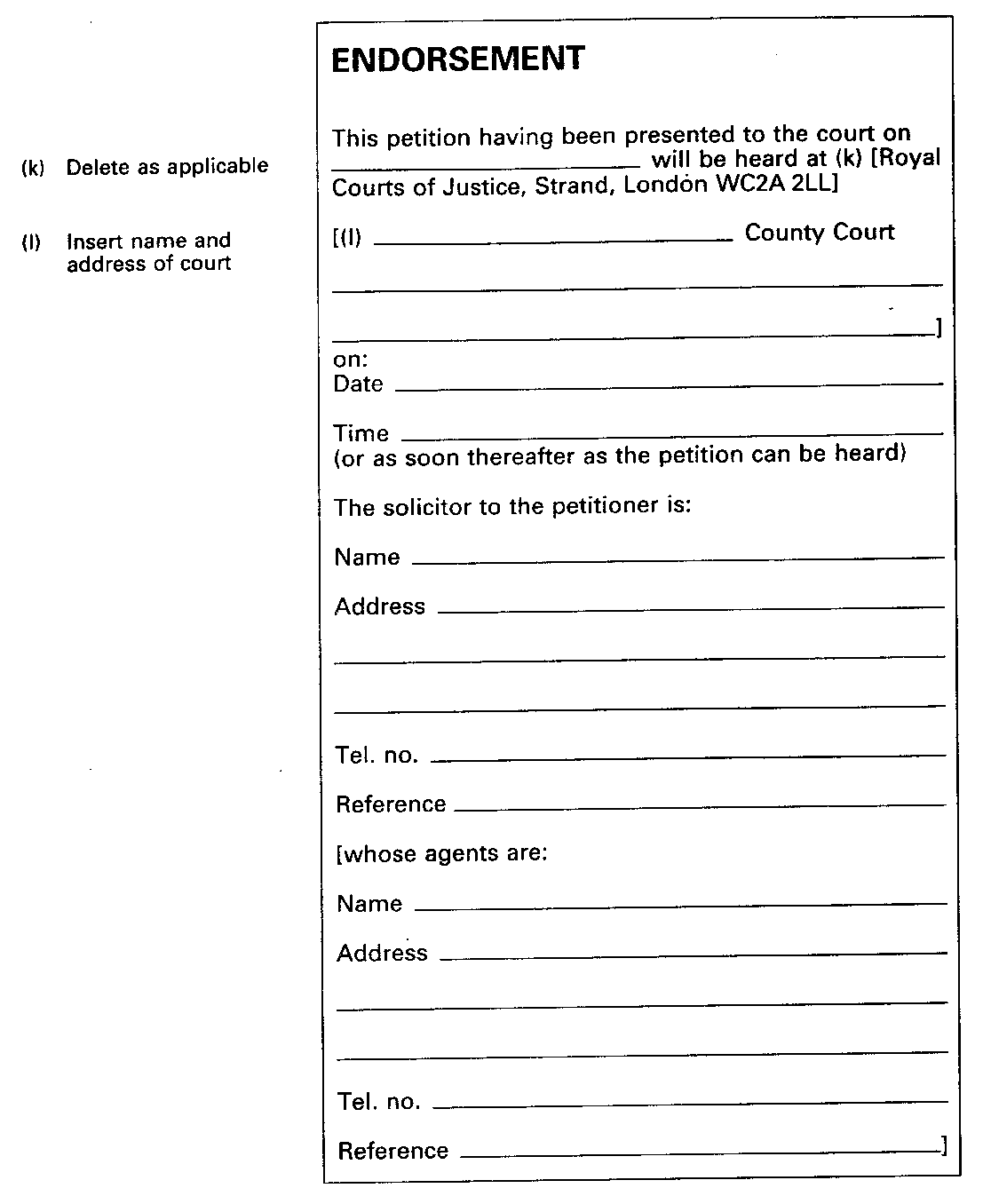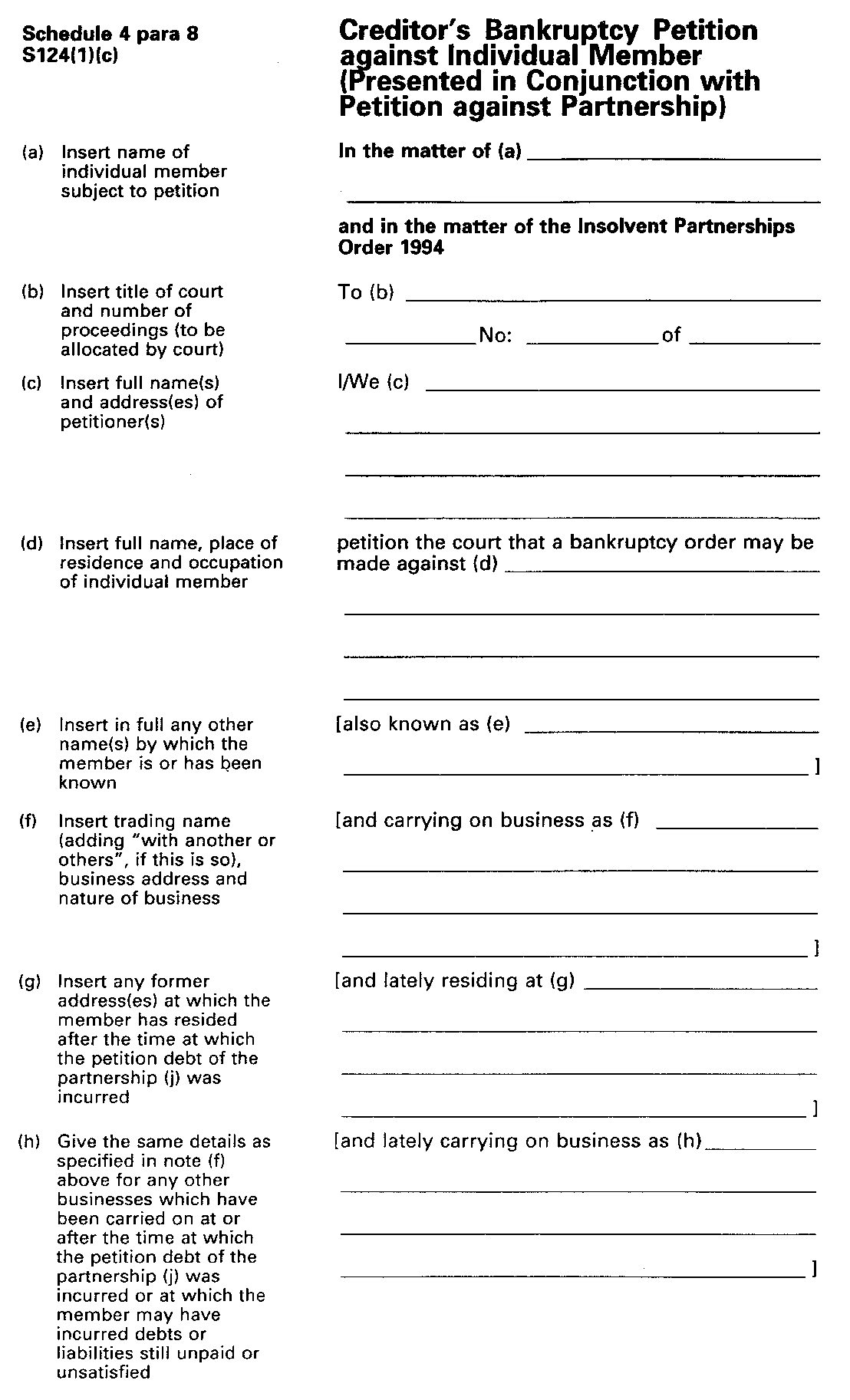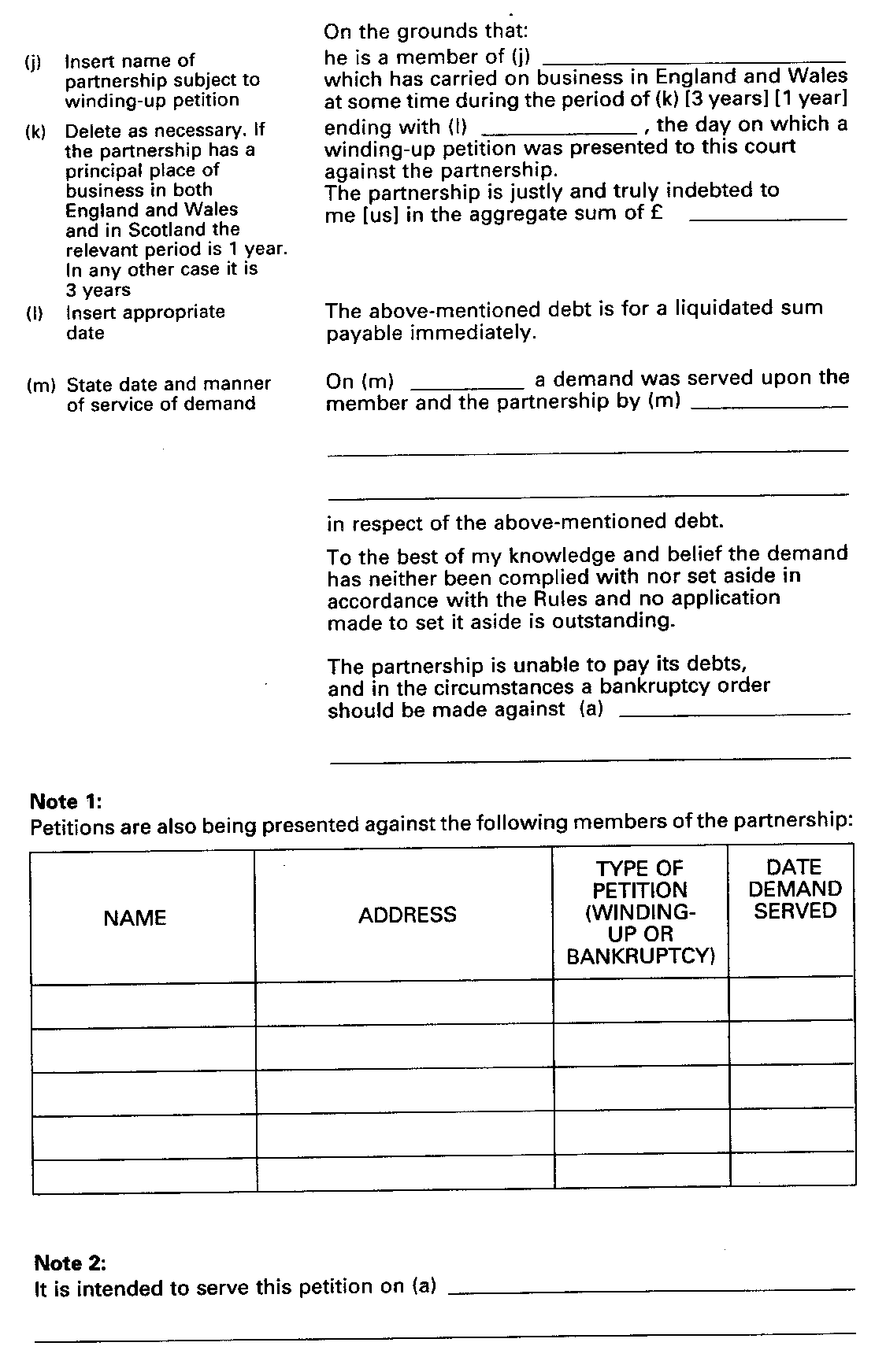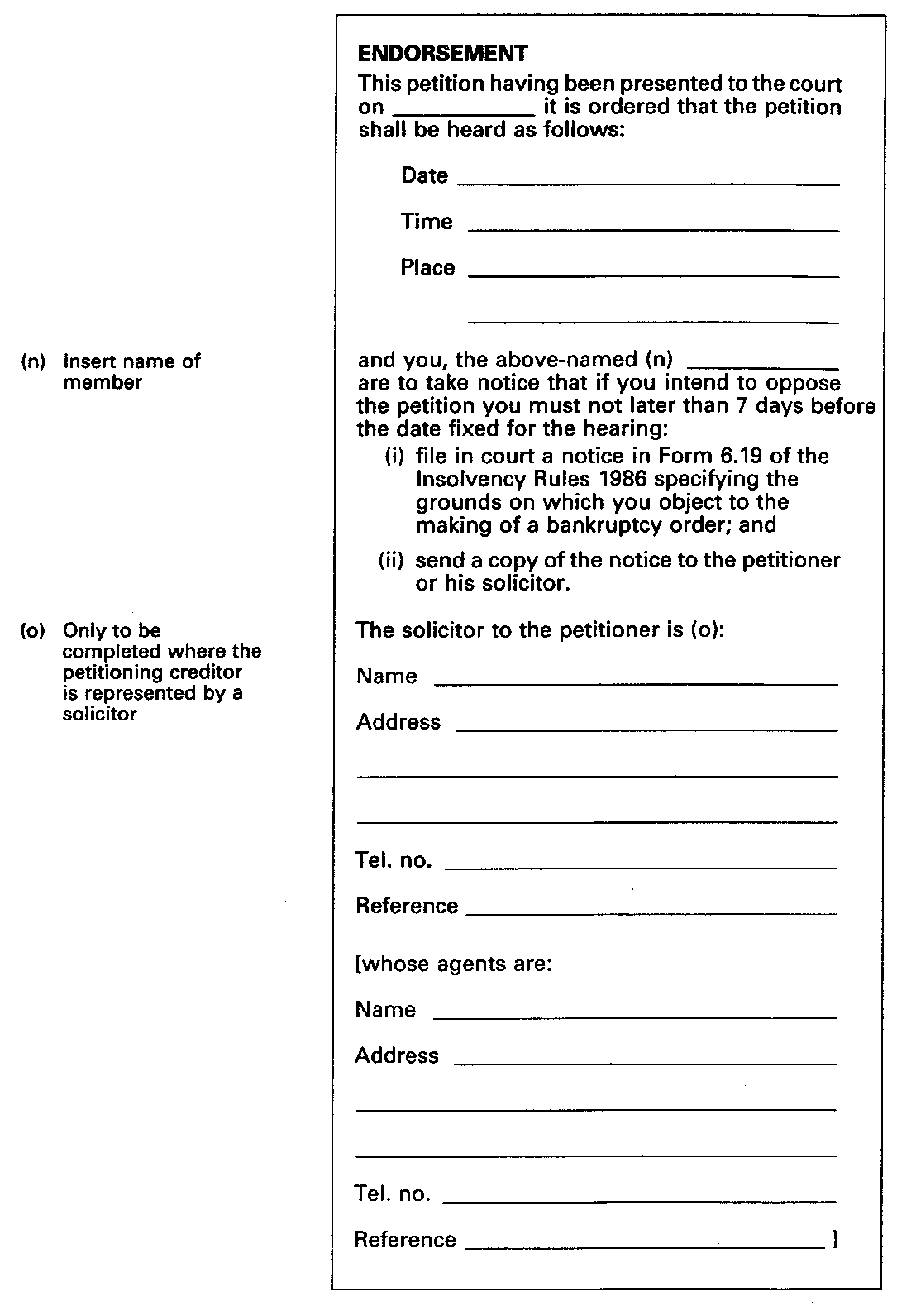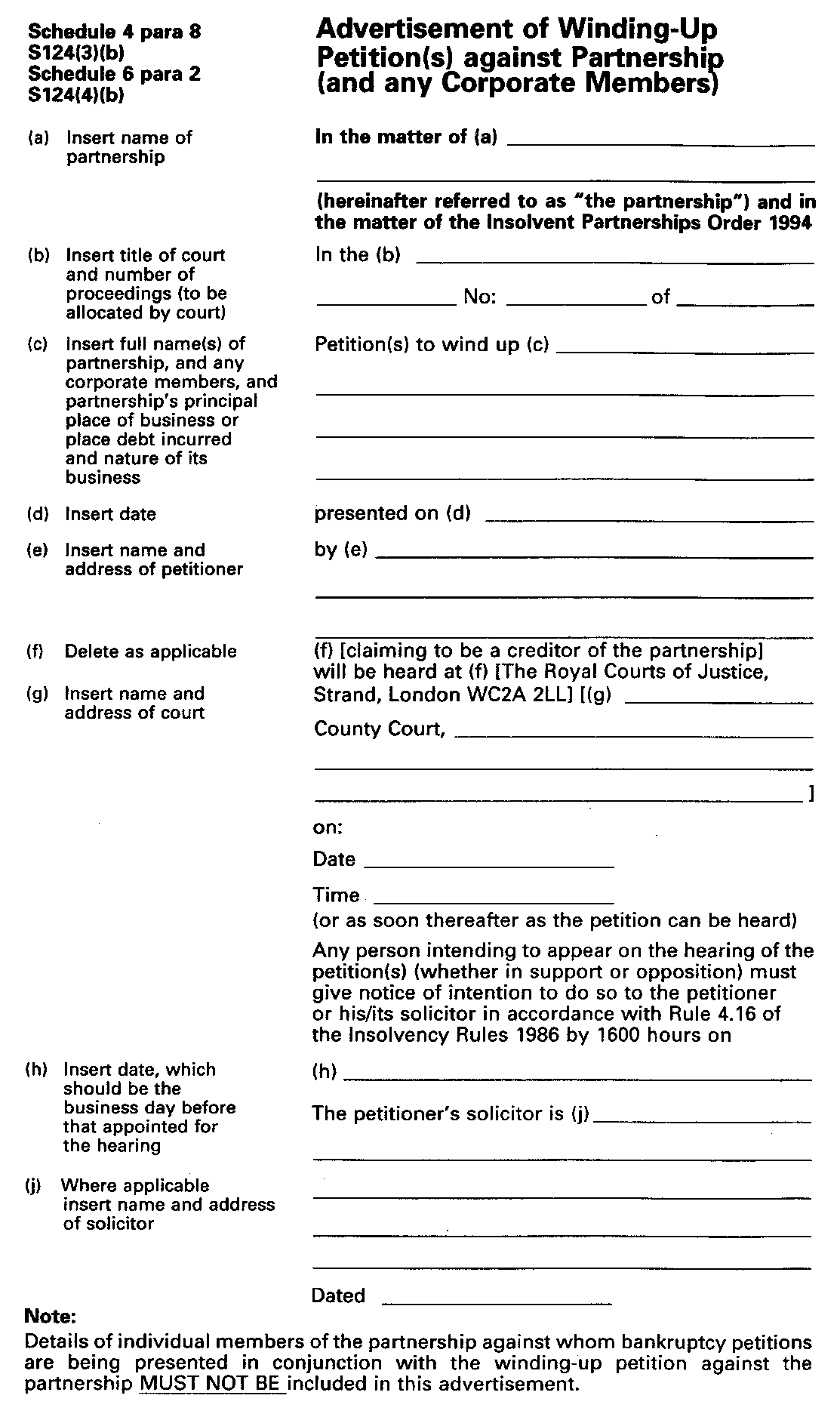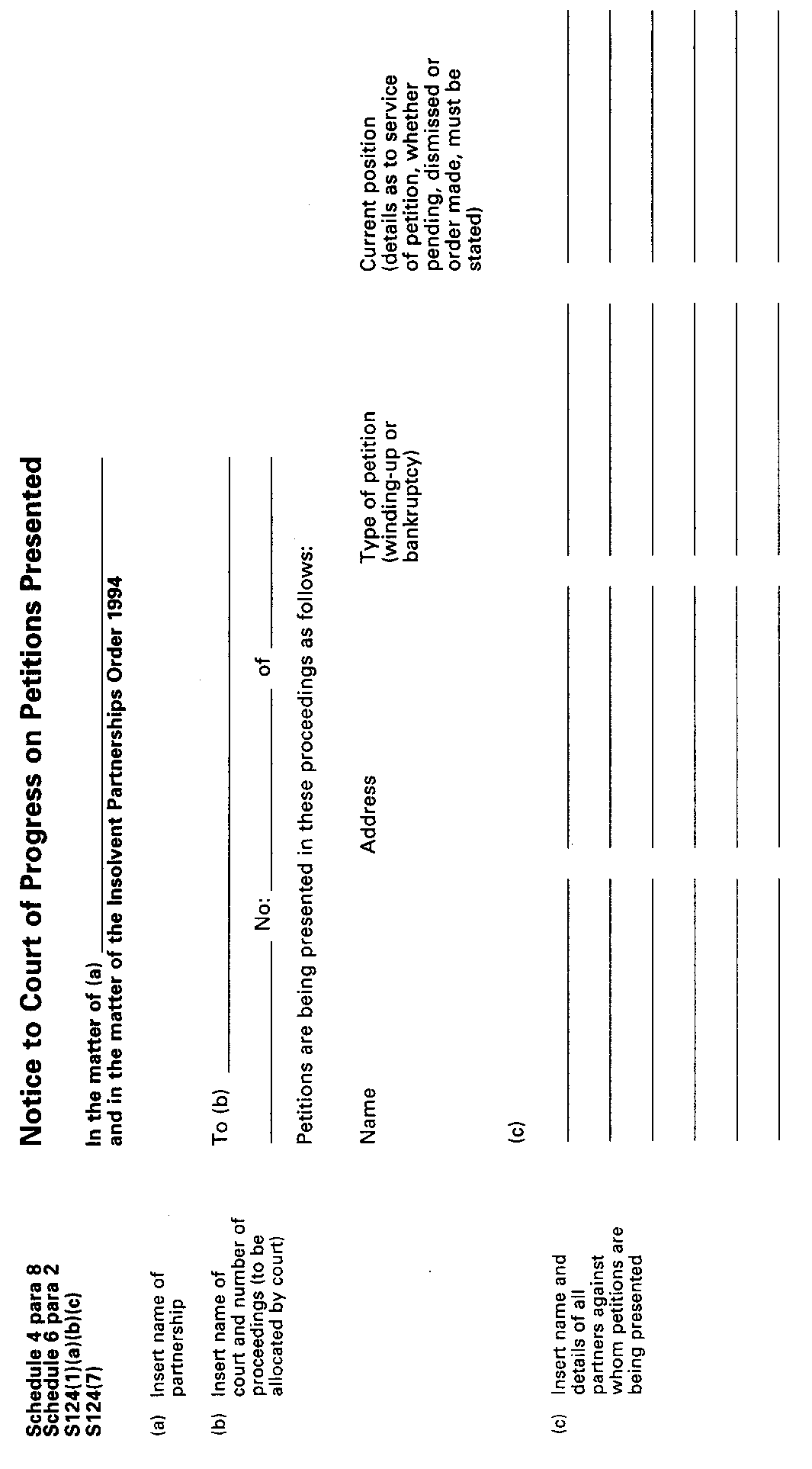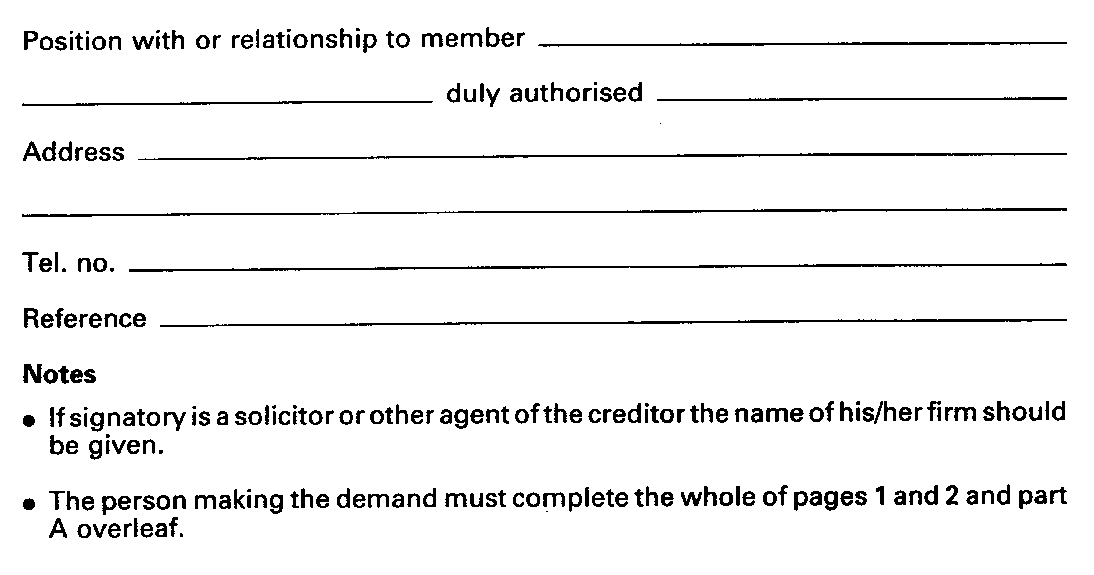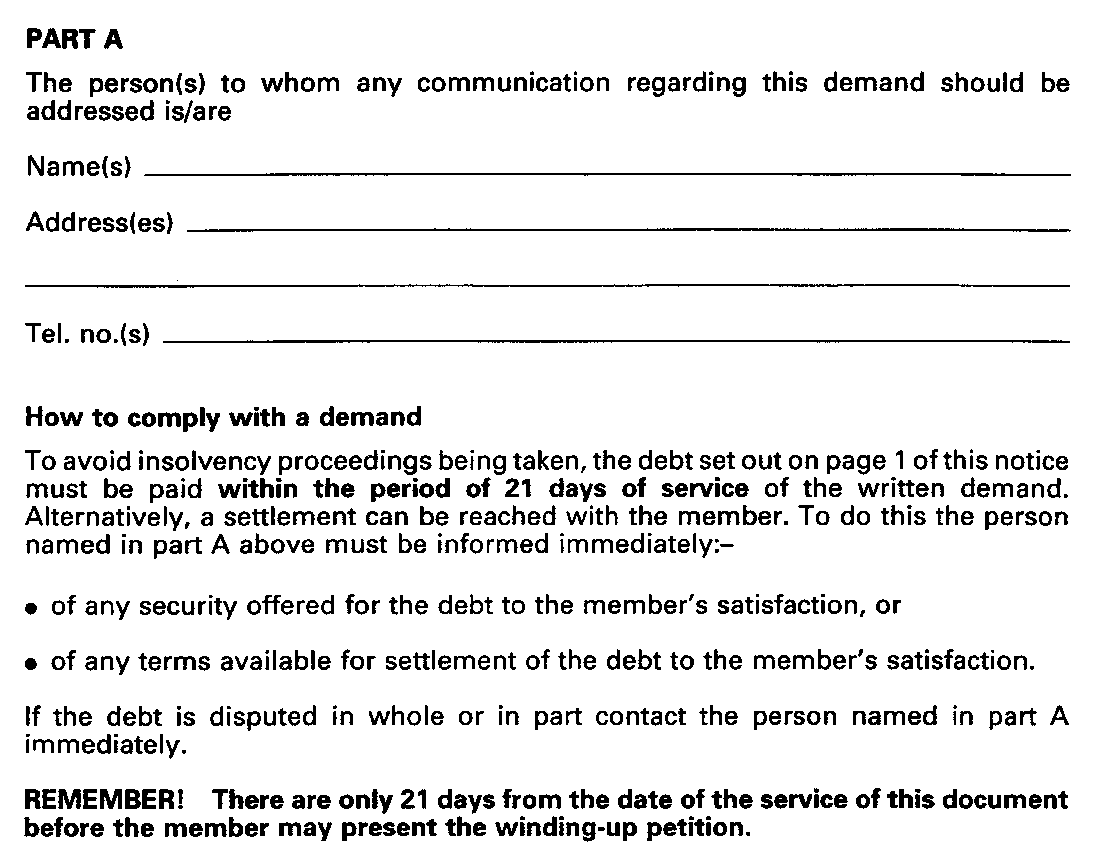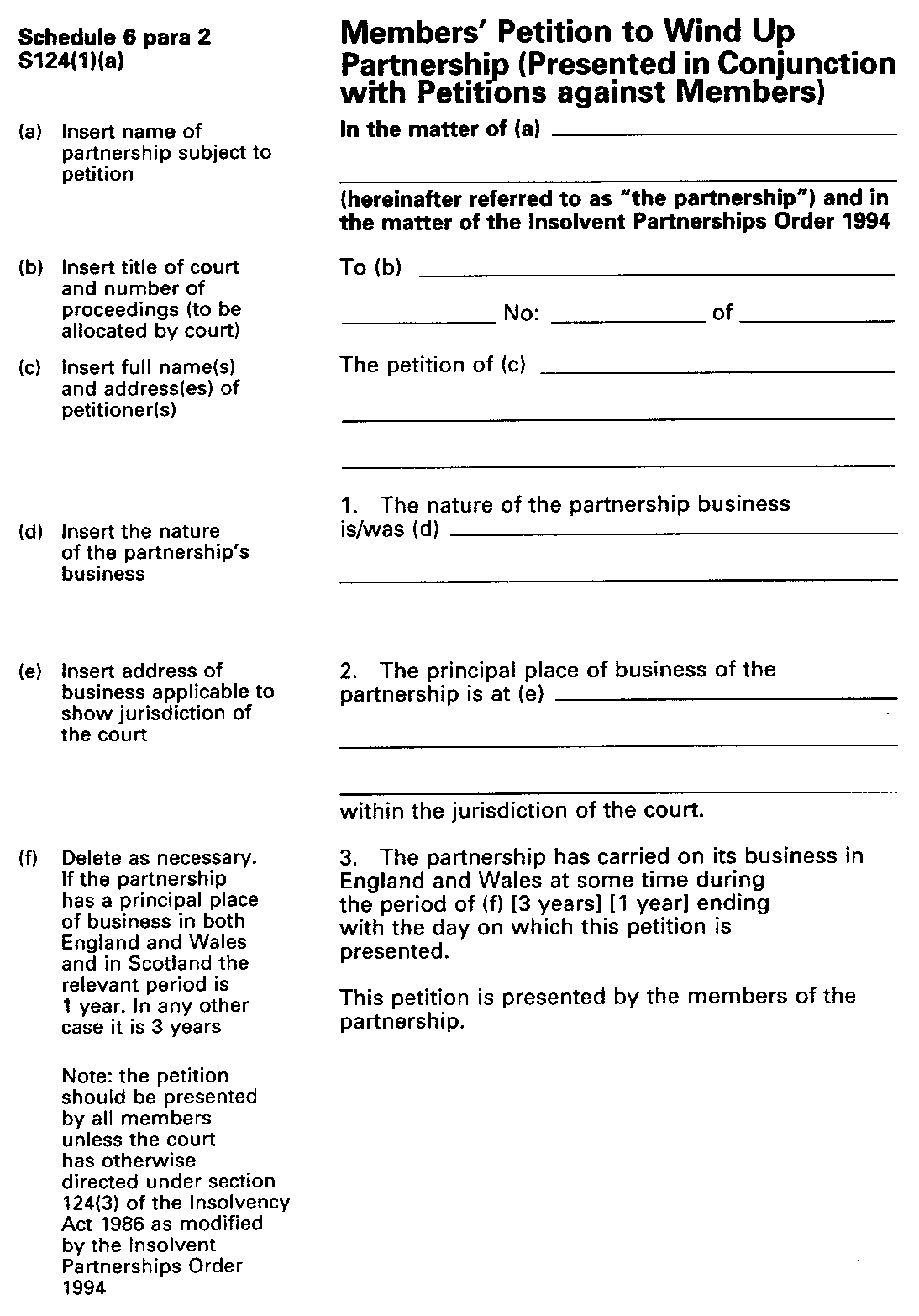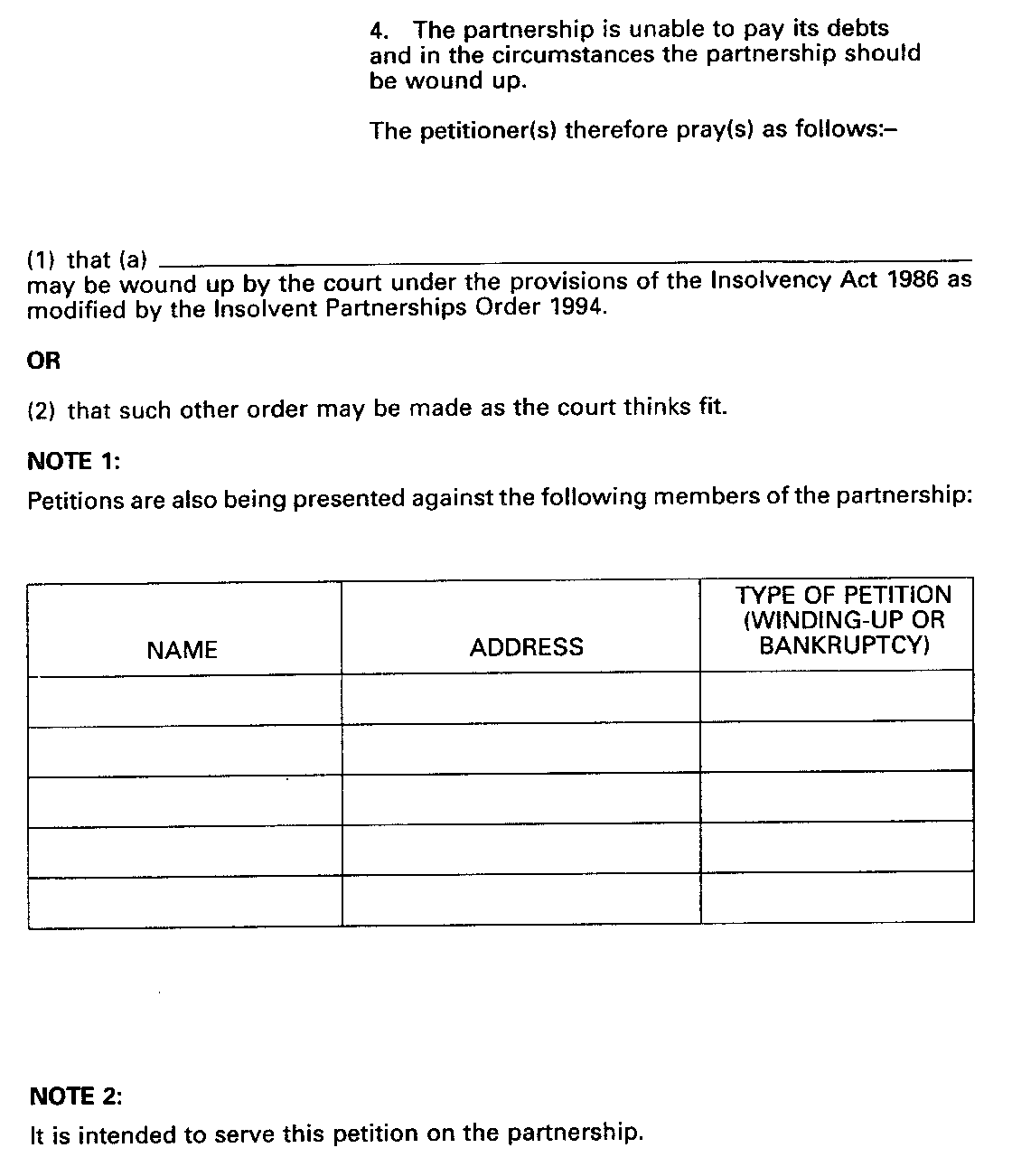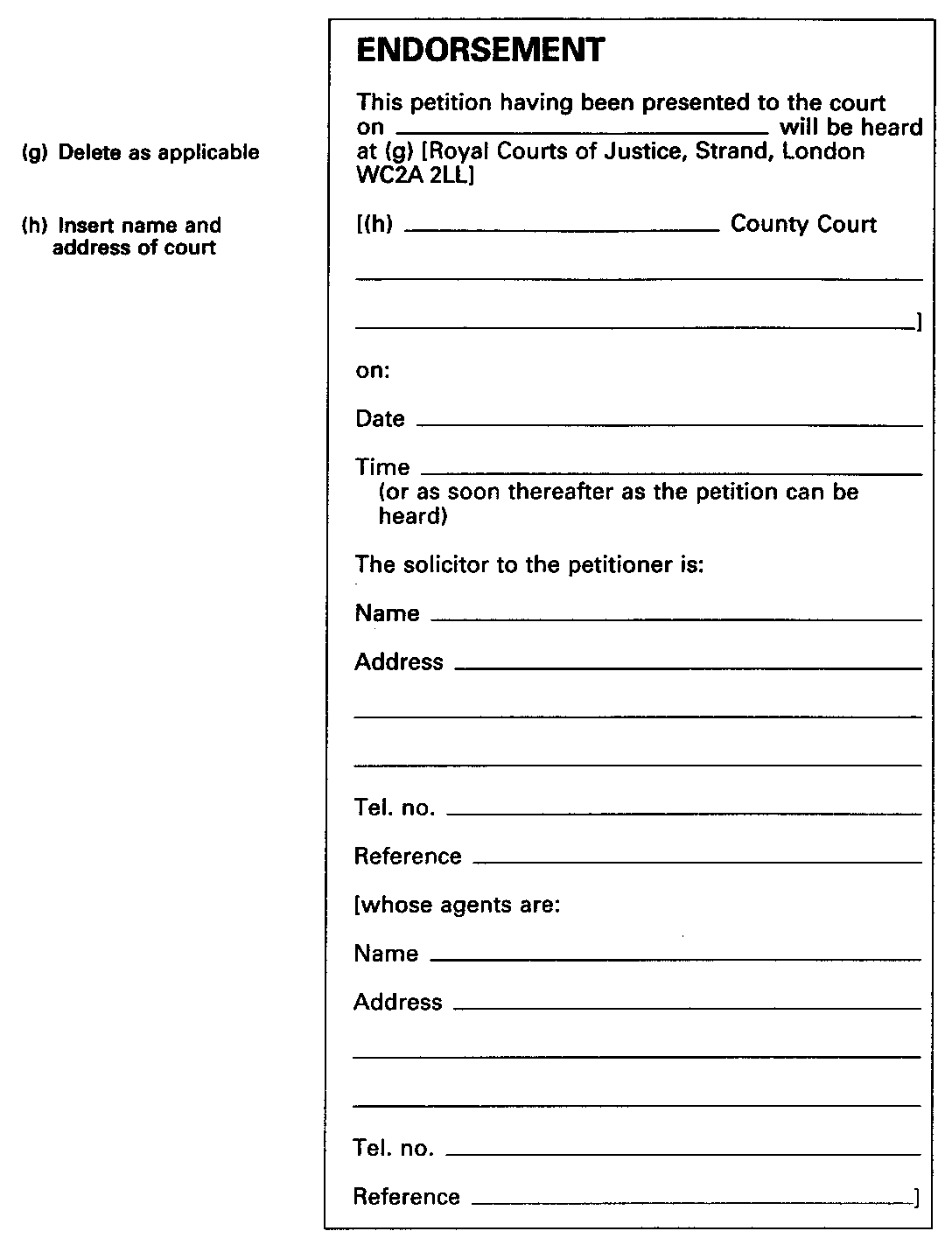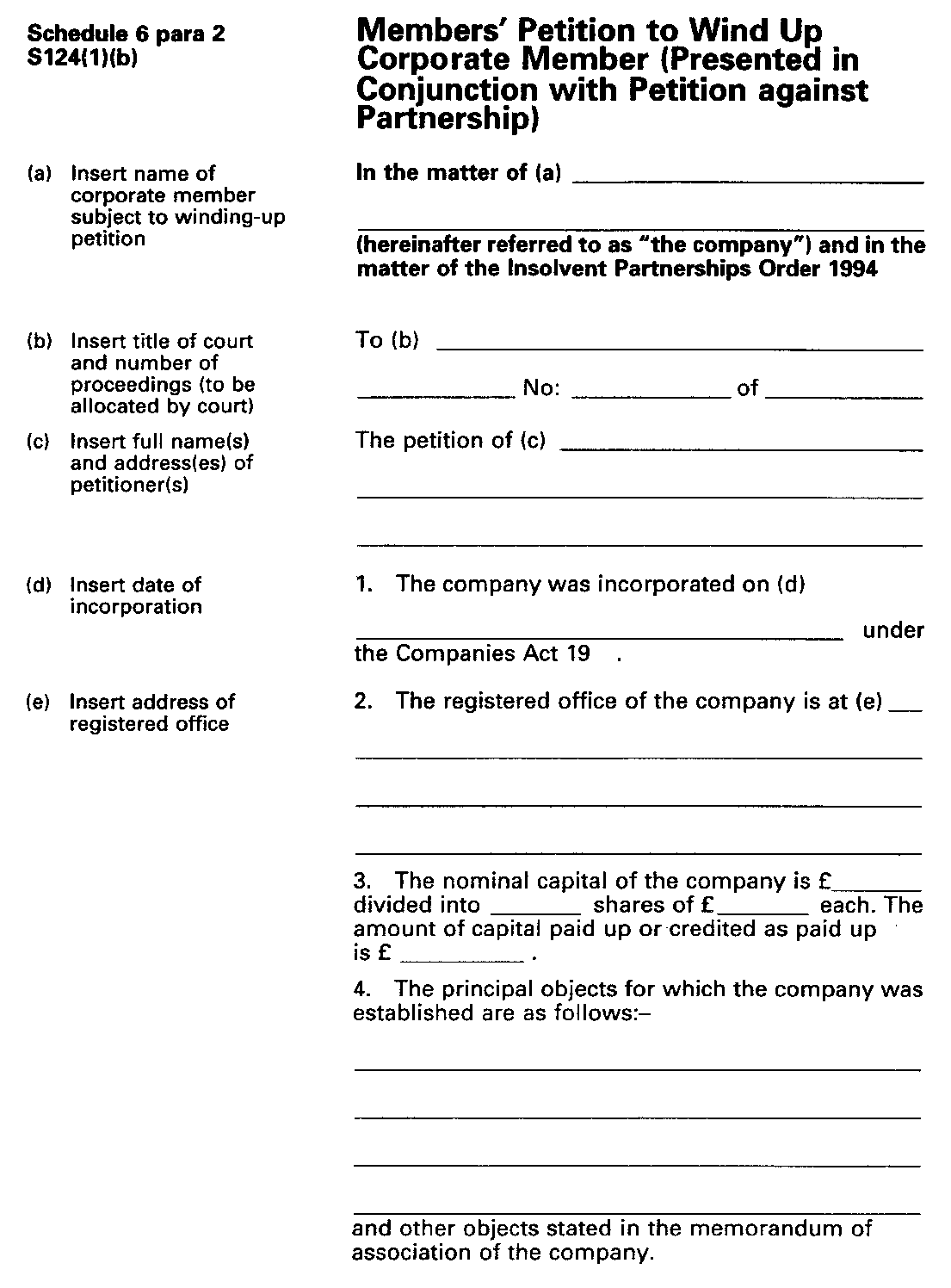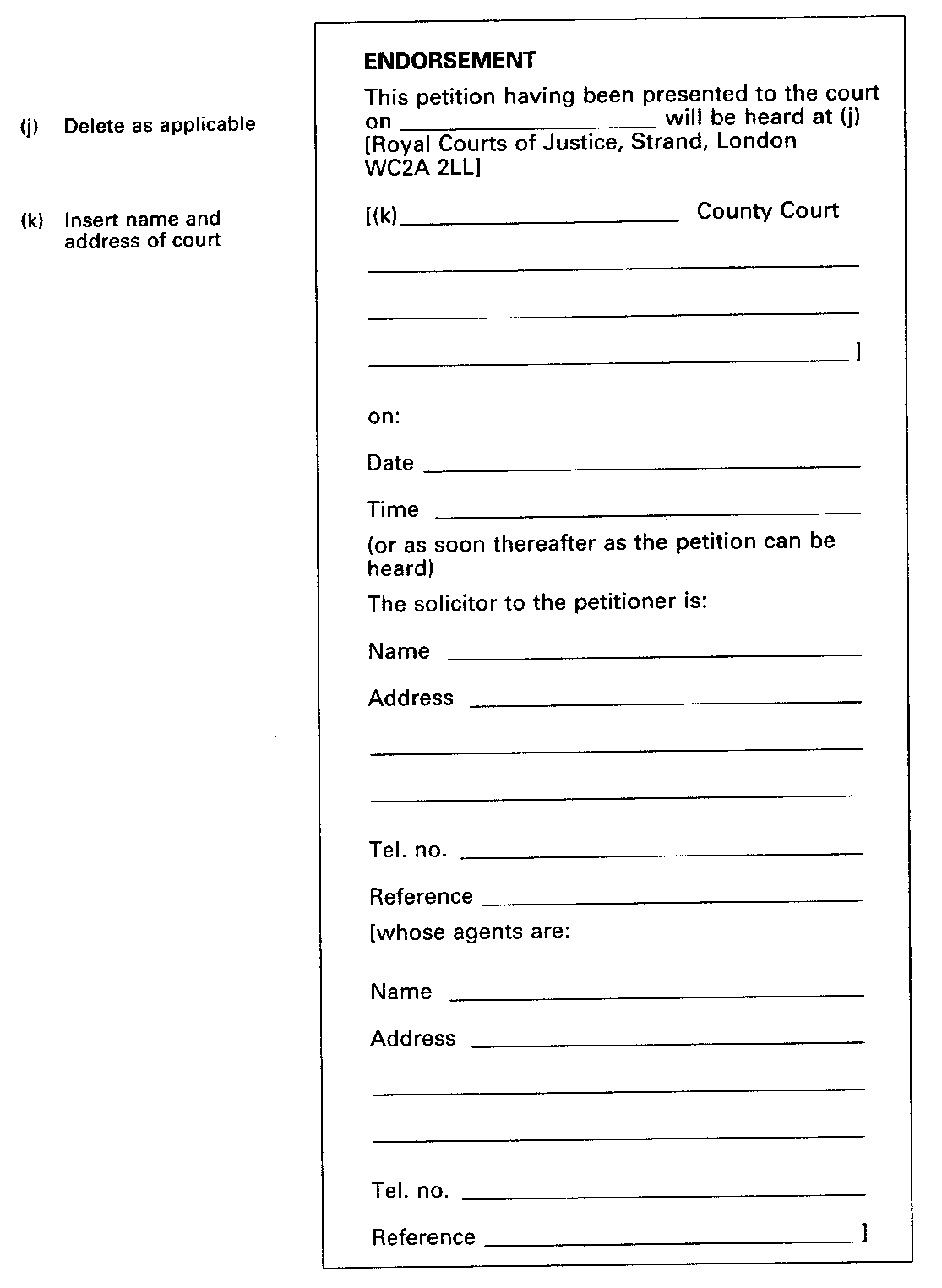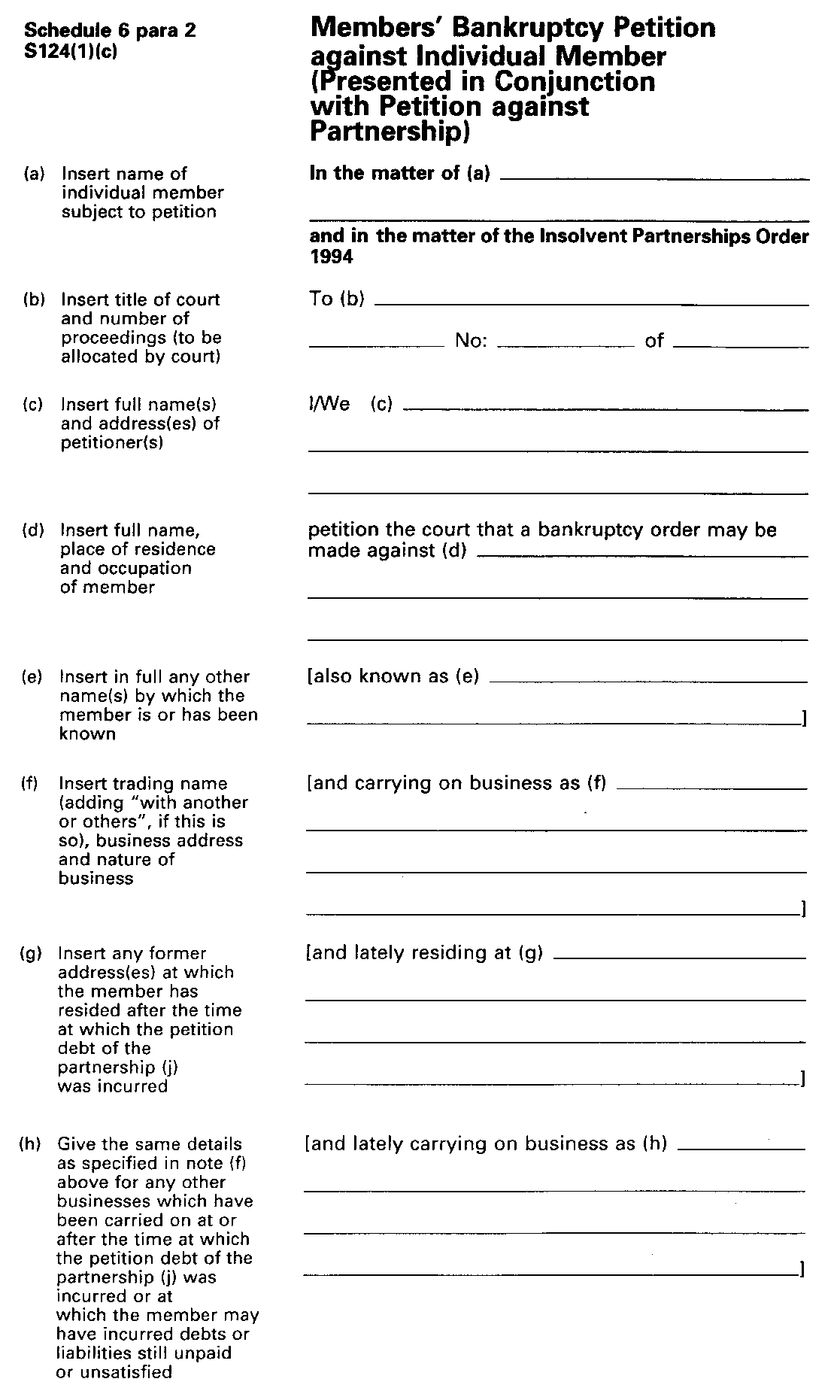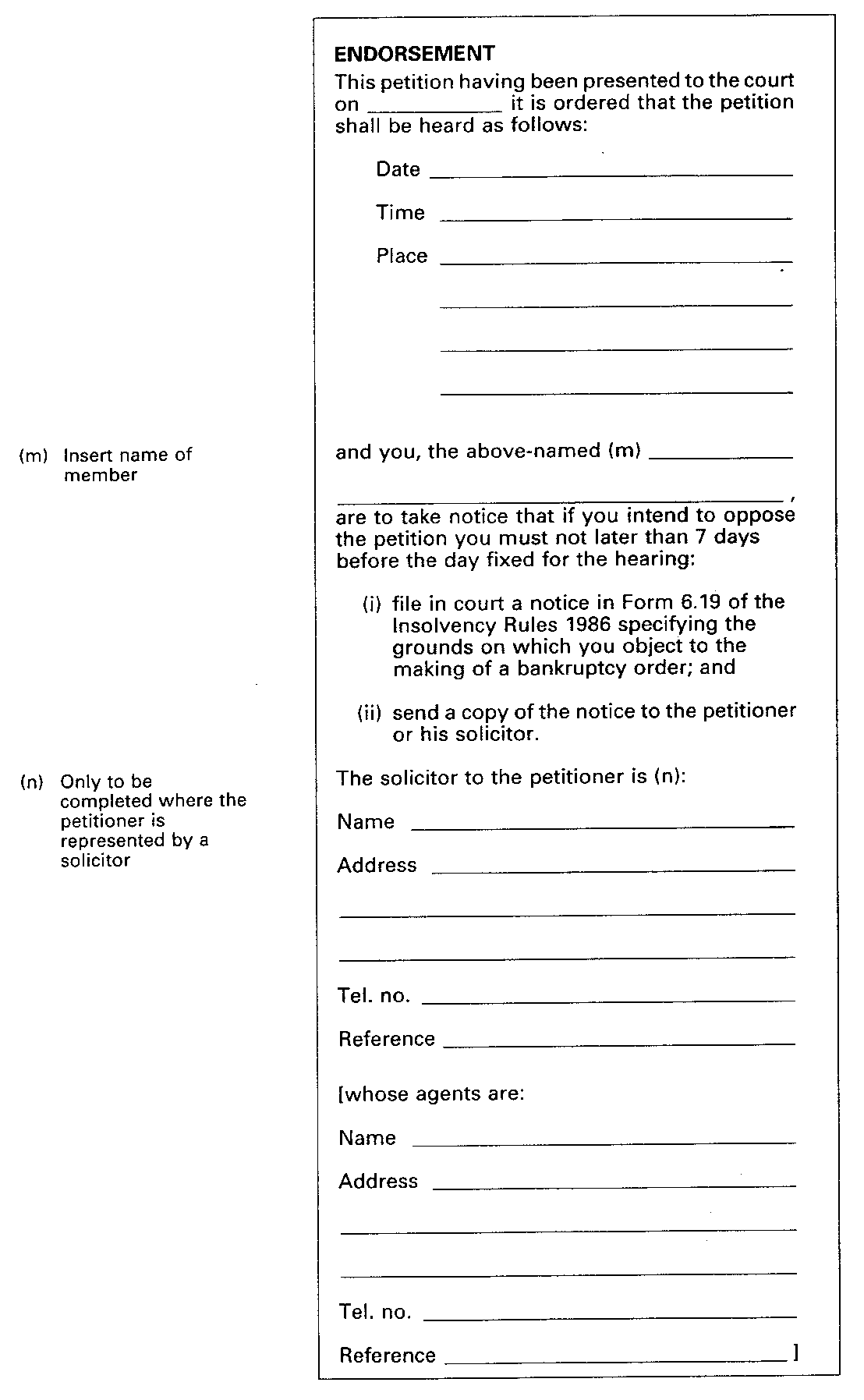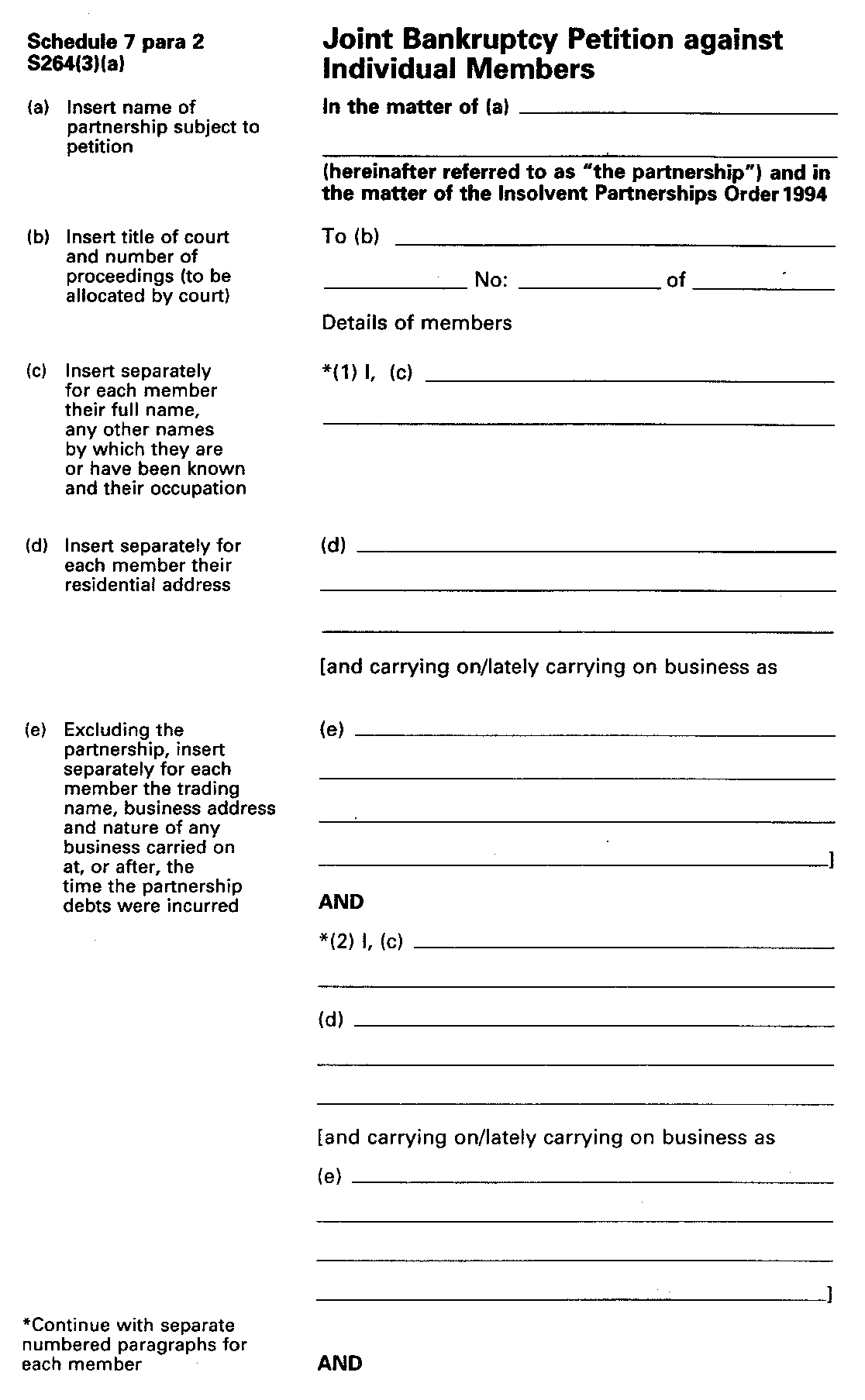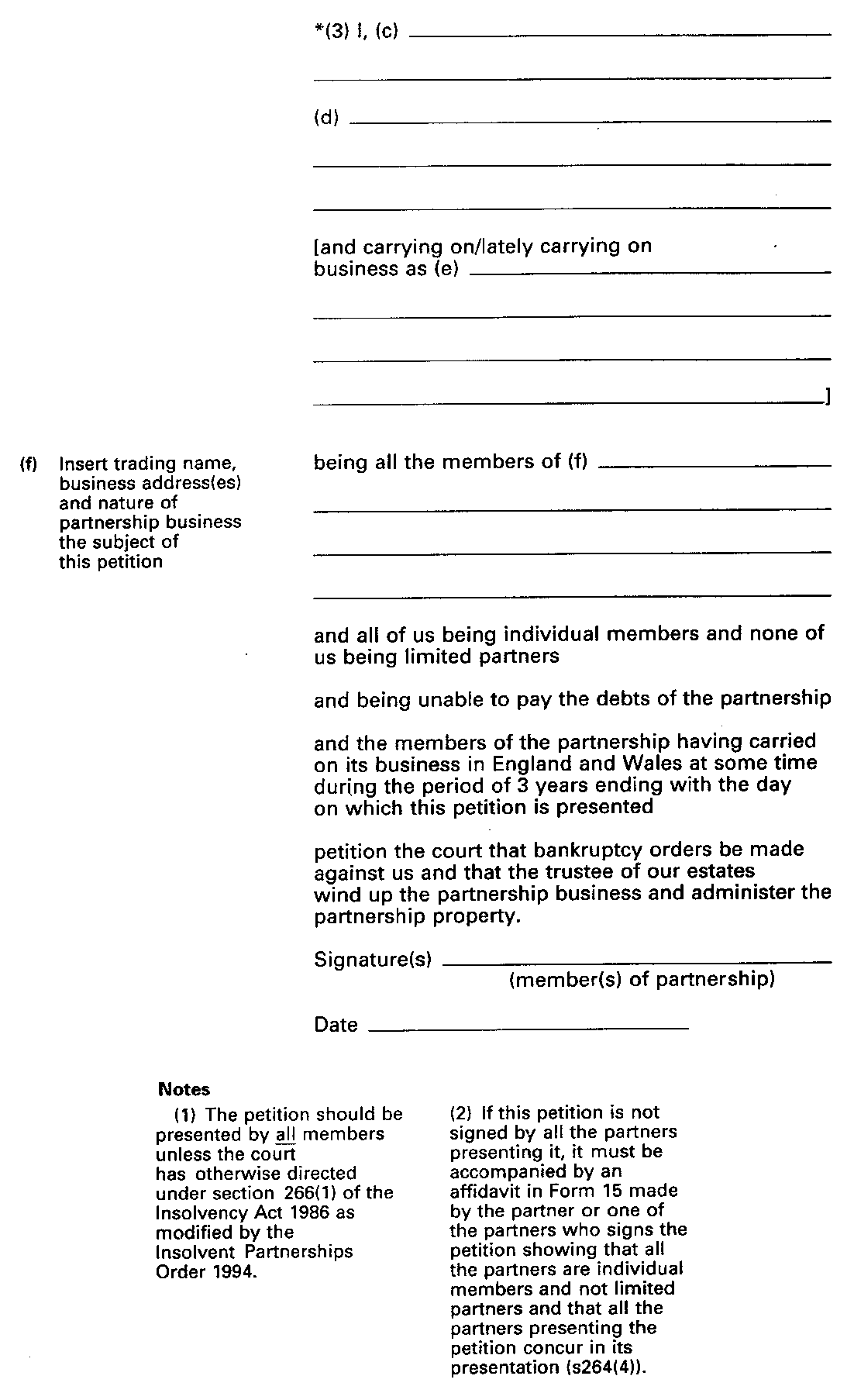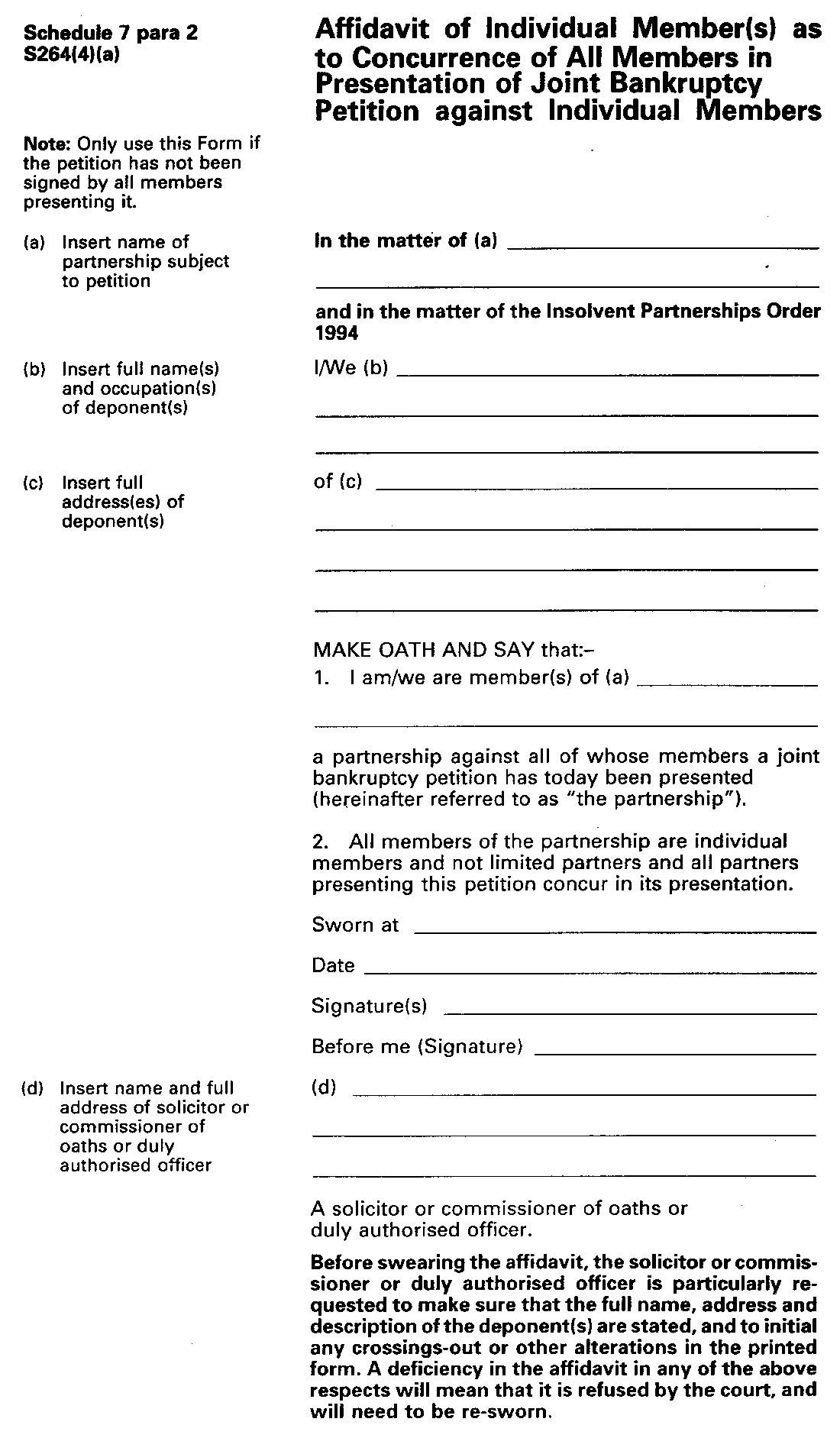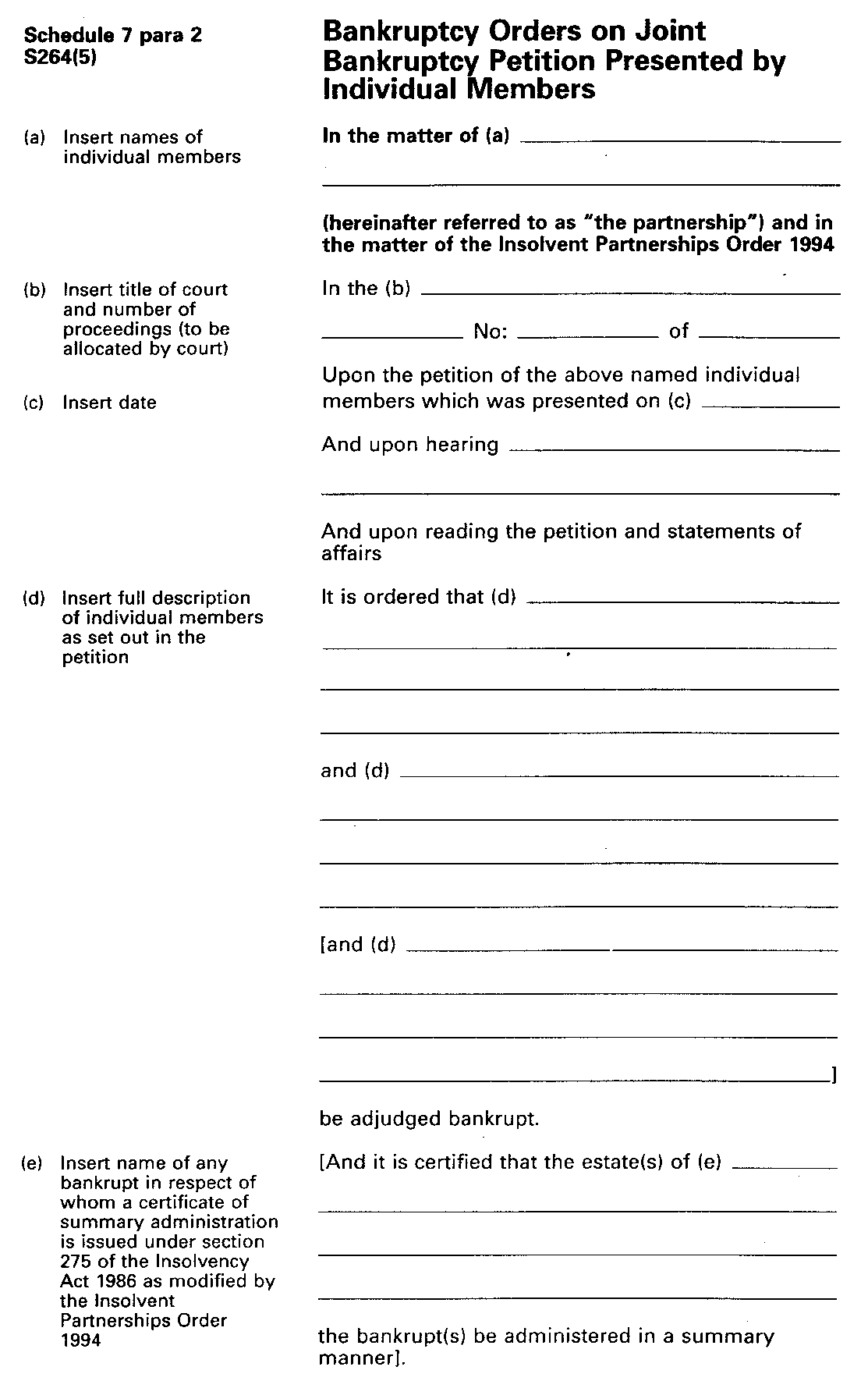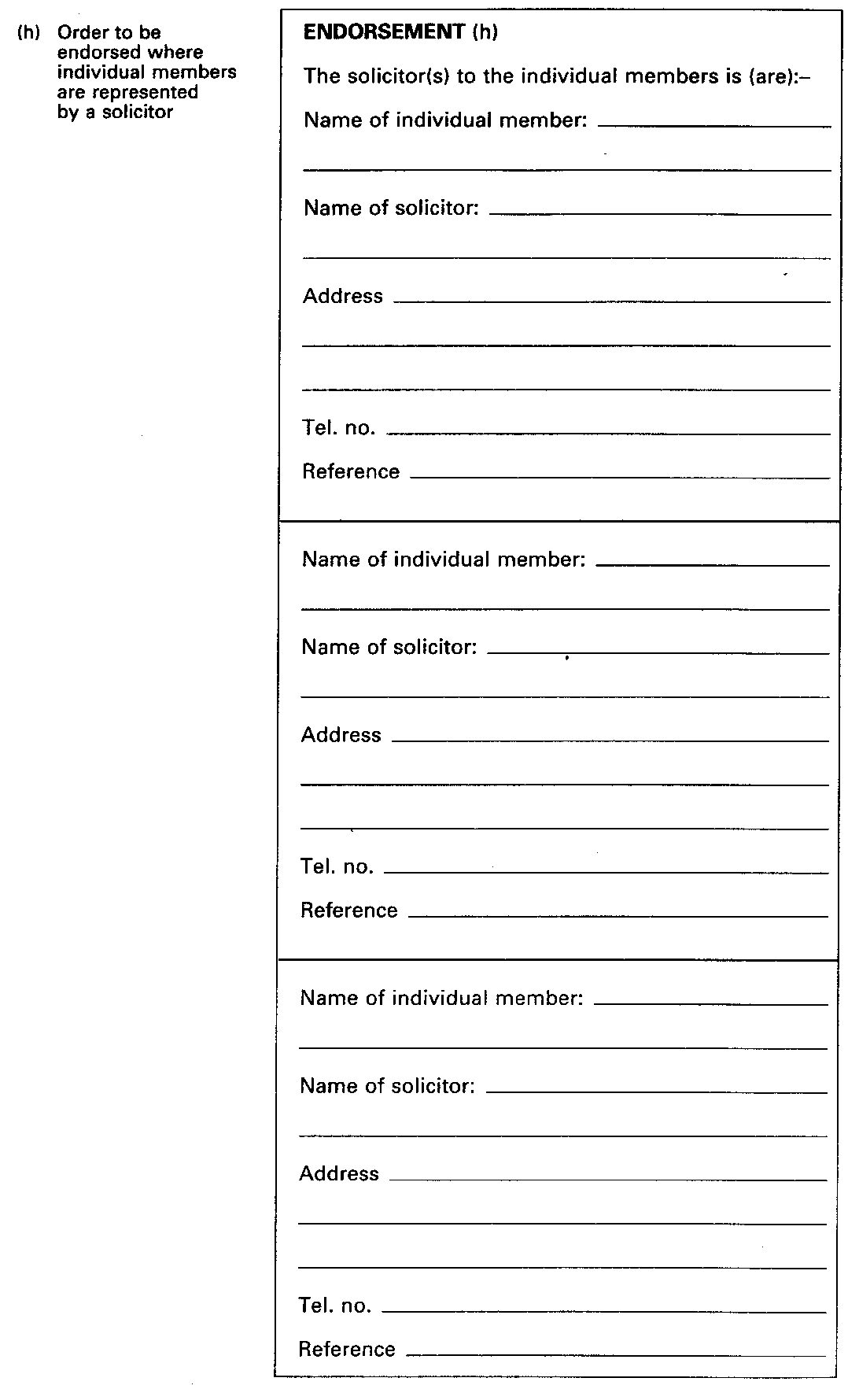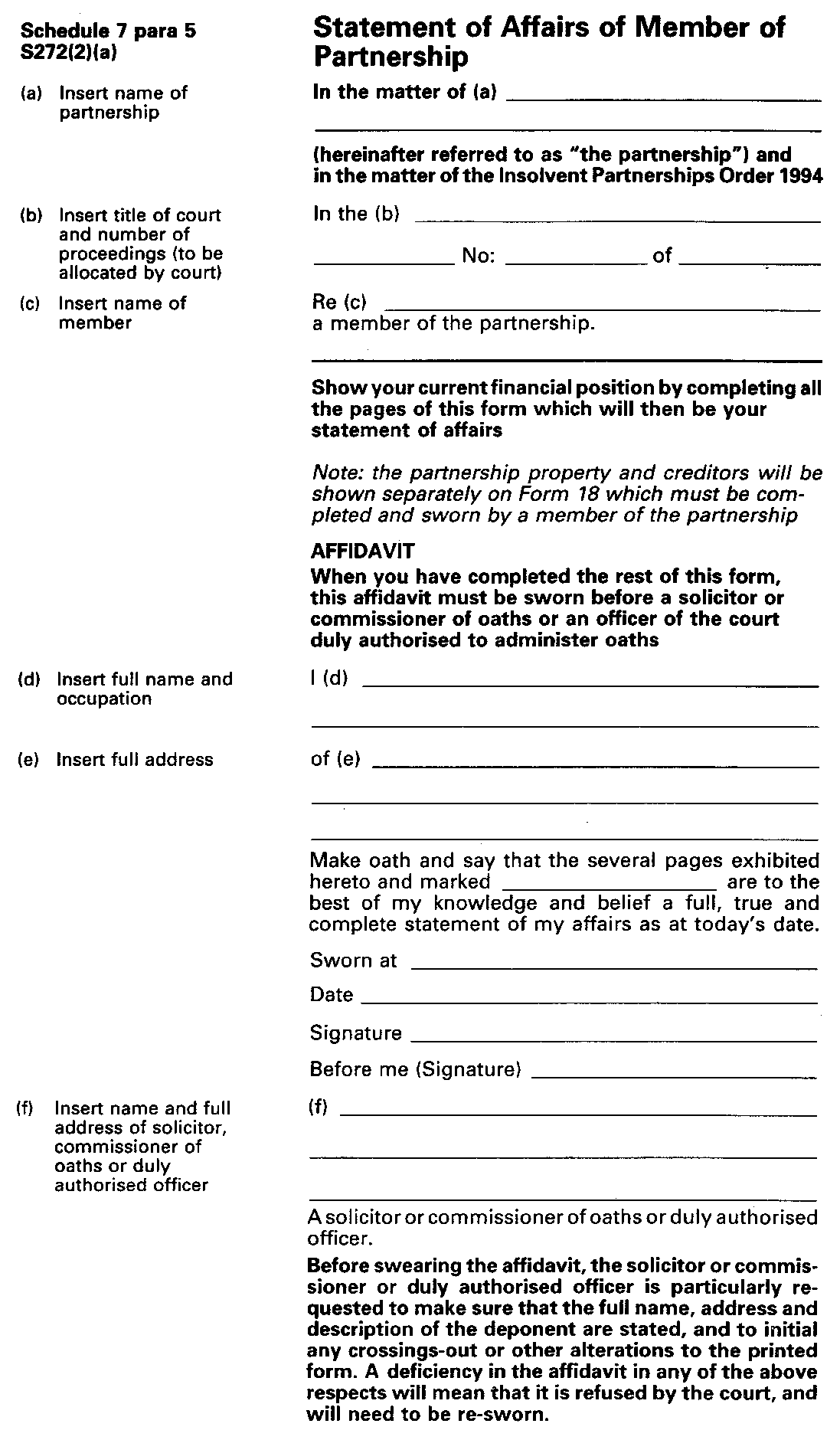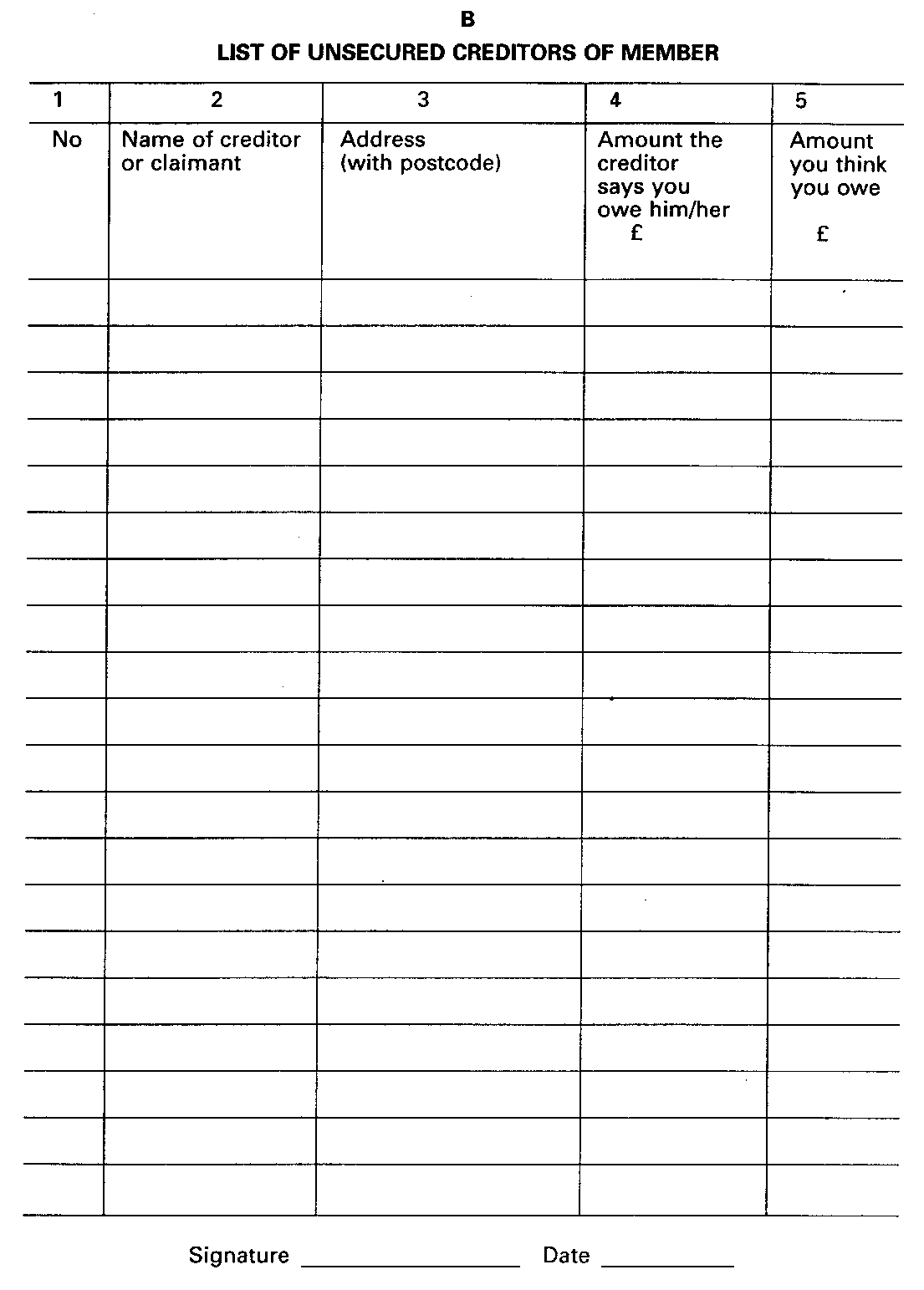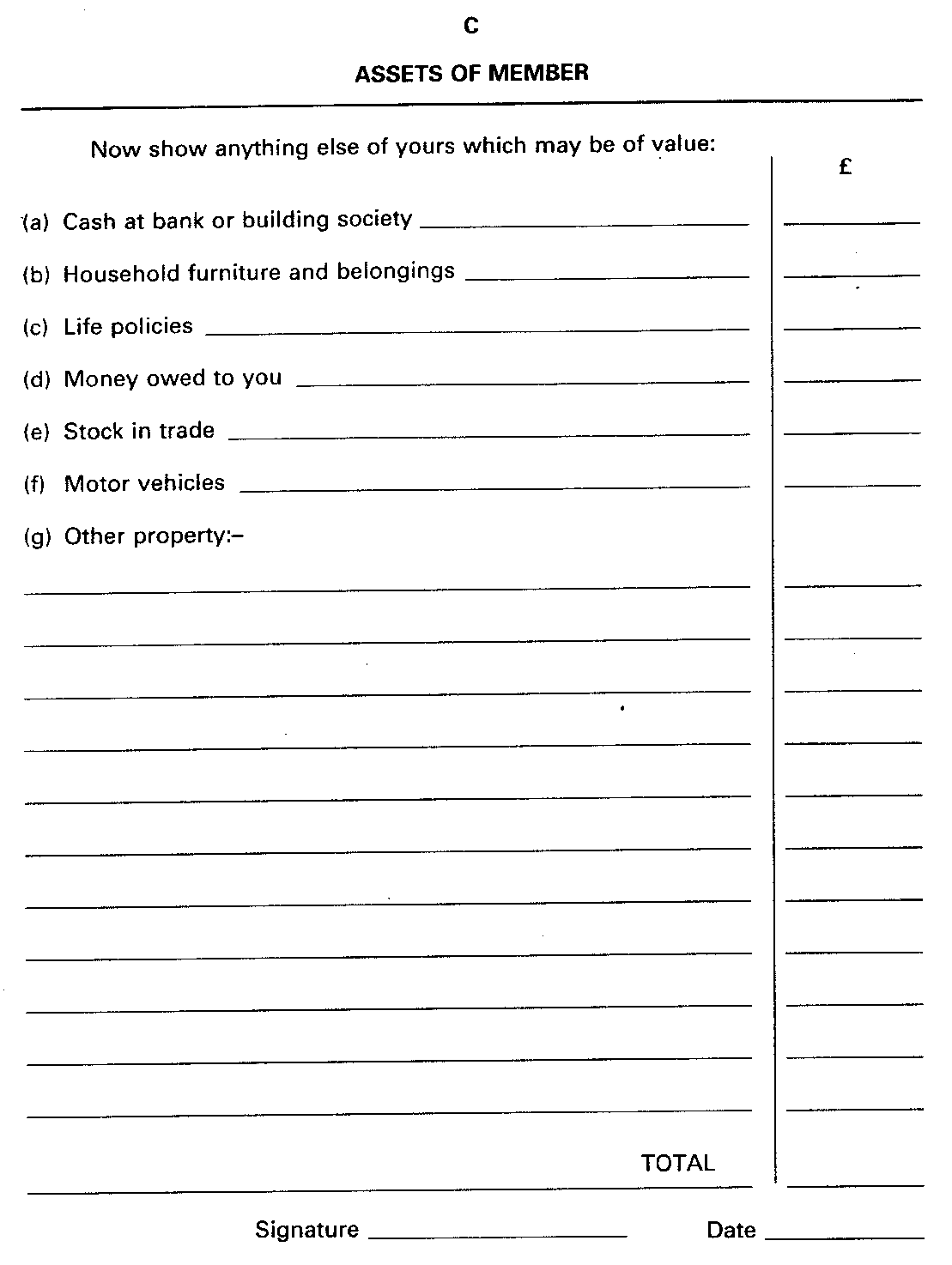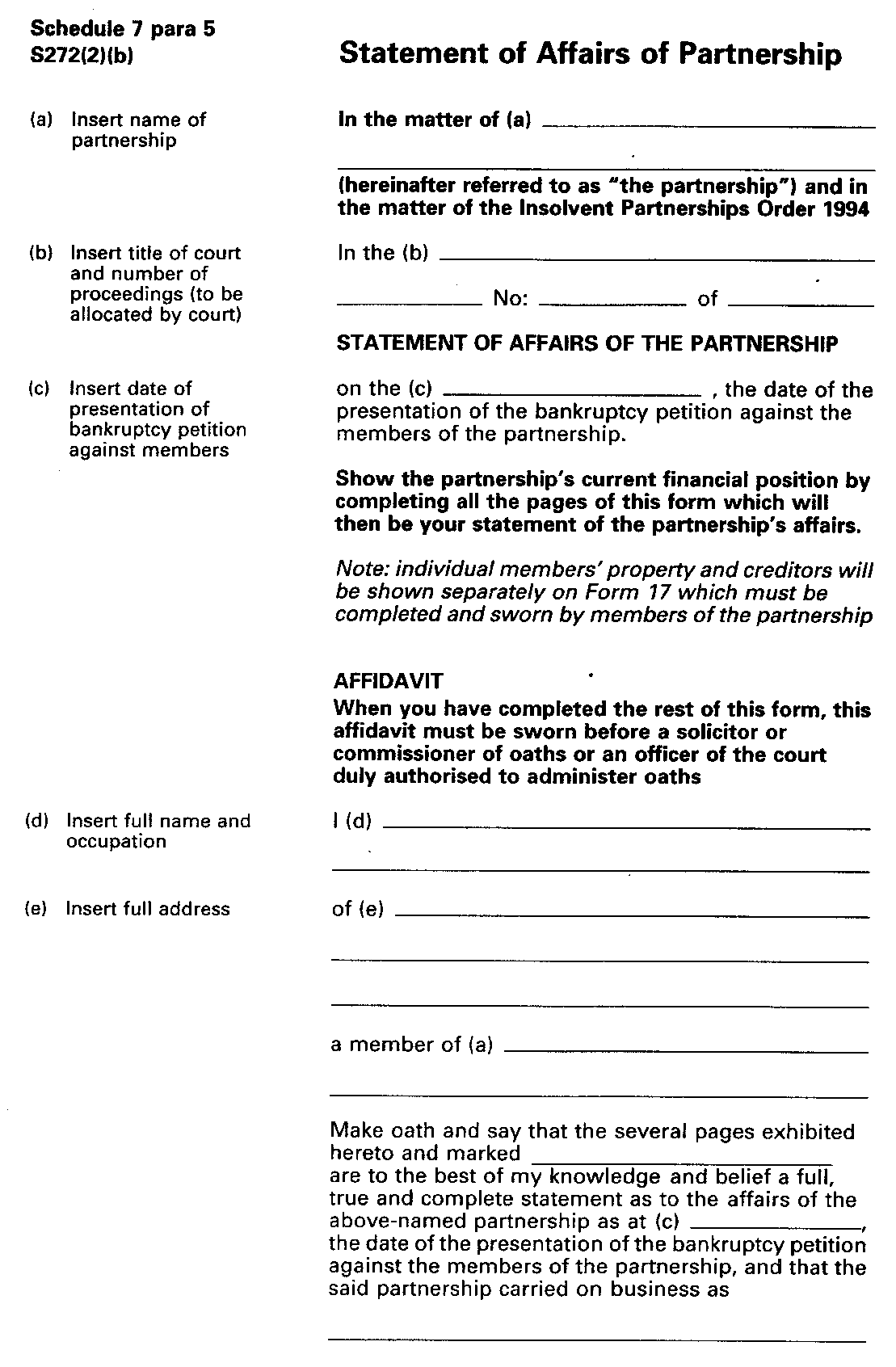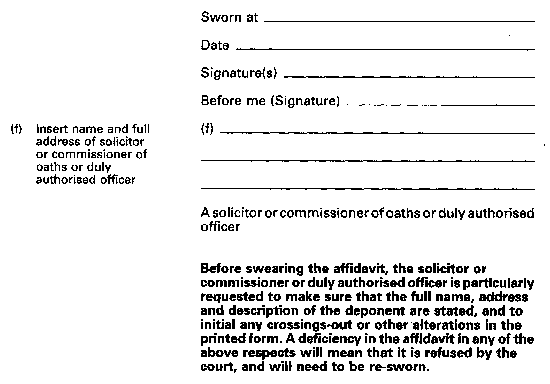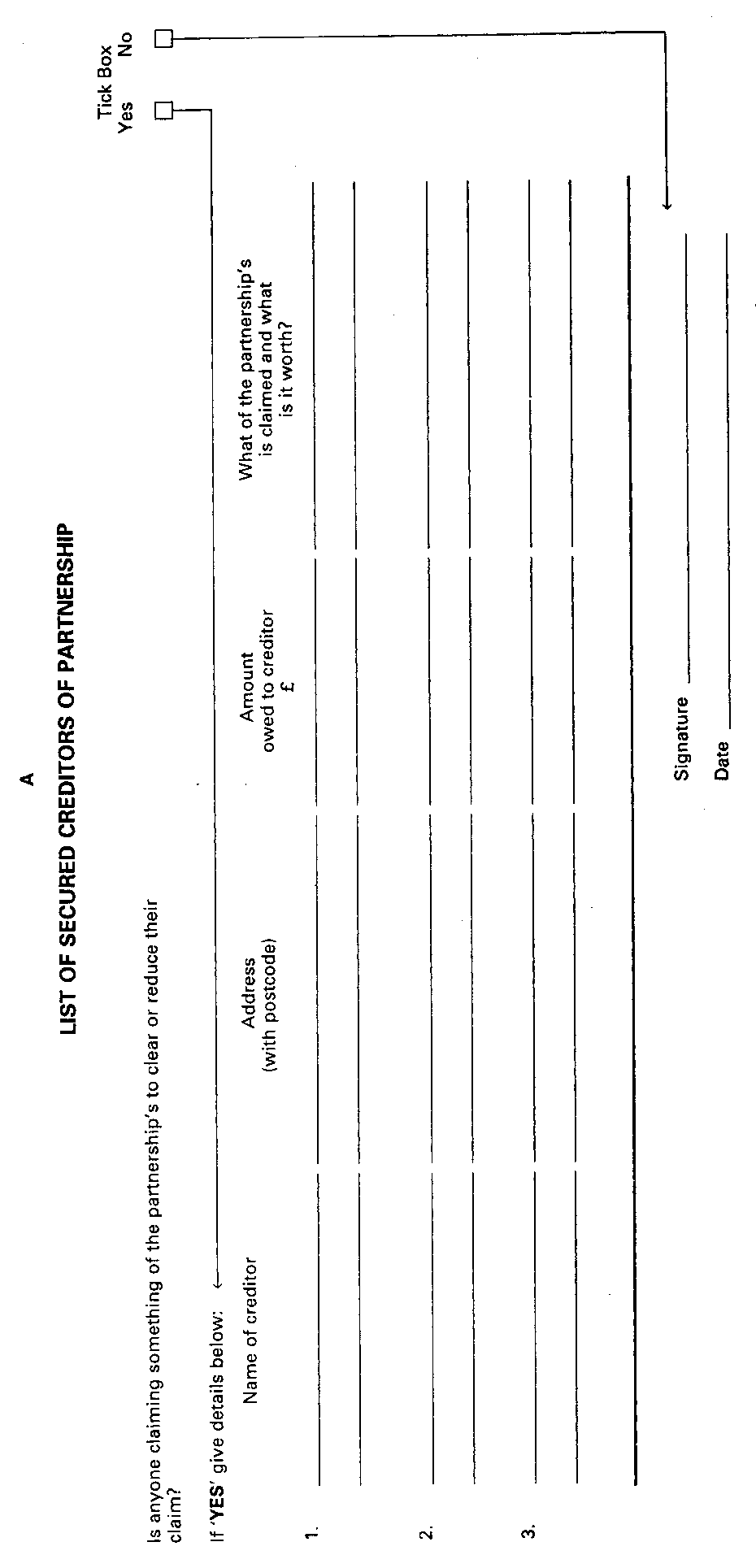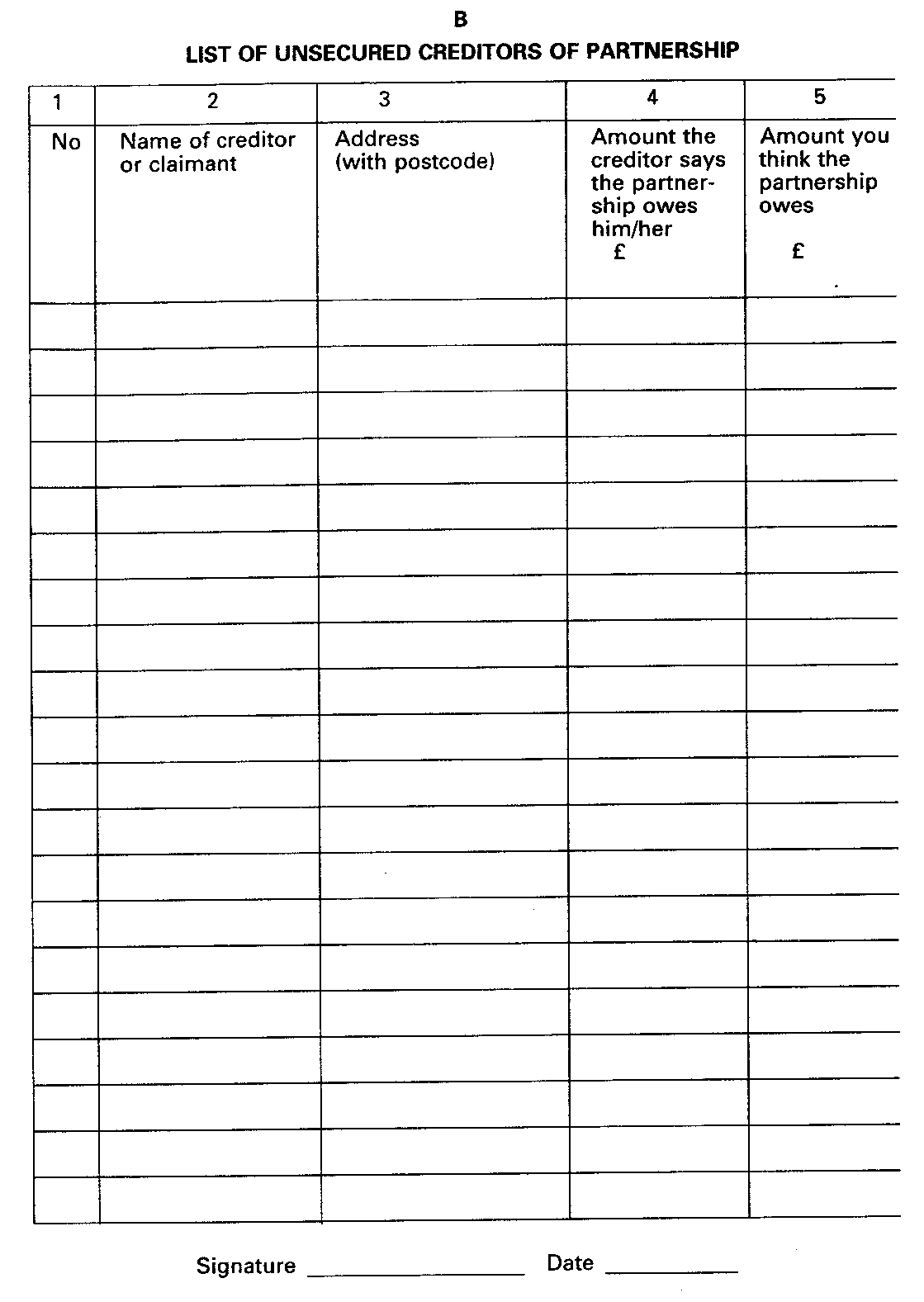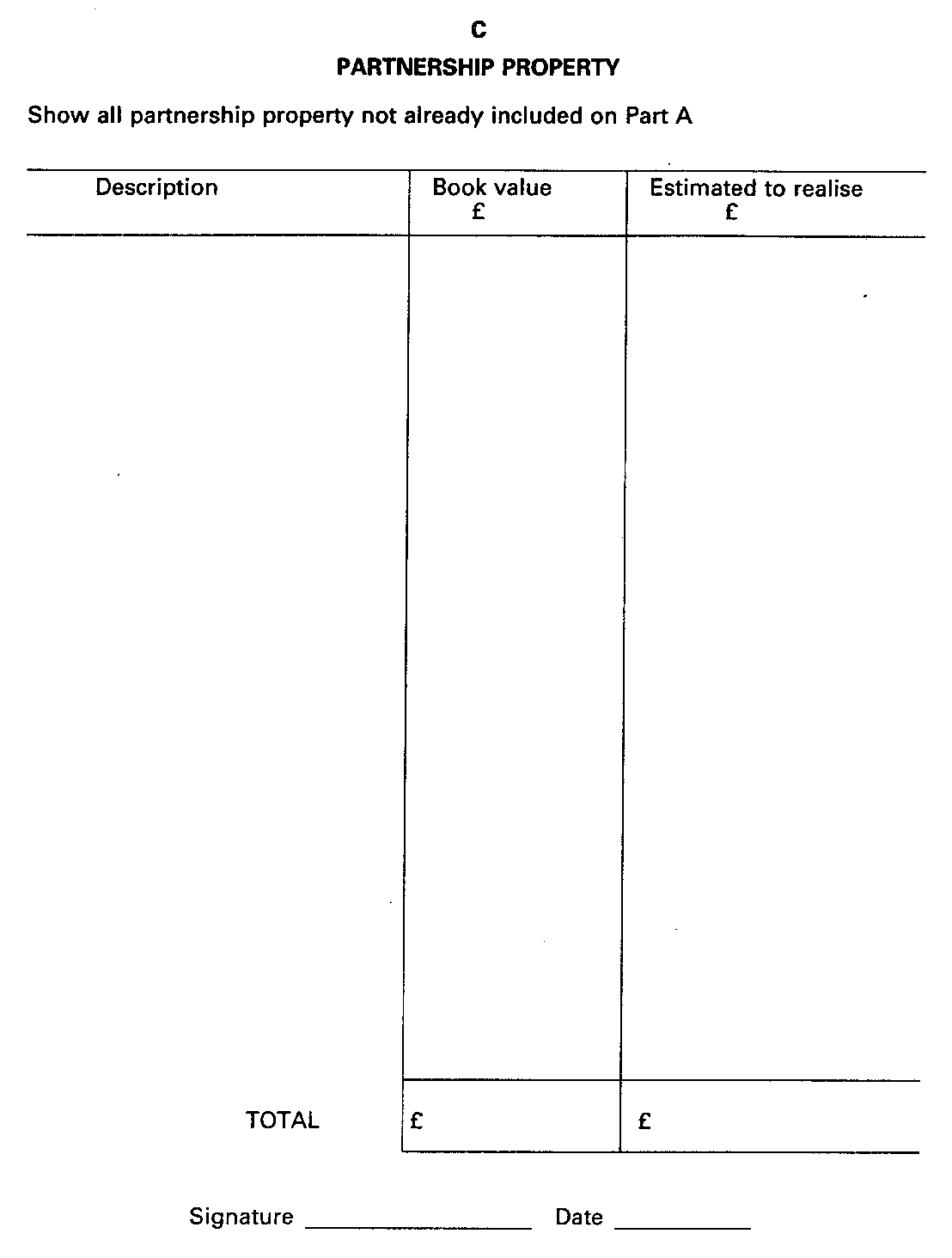- Latest available (Revised)
- Original (As made)
The Insolvent Partnerships Order 1994
You are here:
- UK Statutory Instruments
- 1994 No. 2421
- Whole Instrument
- Previous
- Next
More Resources
Status:
This is the original version (as it was originally made). This item of legislation is currently only available in its original format.
Statutory Instruments
1994 No. 2421
INSOLVENCY
The Insolvent Partnerships Order 1994
Made
13th September 1994
Laid before Parliament
16th September 1994
Coming into force
1st December 1994
The Lord Chancellor, in exercise of the powers conferred on him by section 420(1) and (2) of the Insolvency Act 1986(1) and section 21(2) of the Company Directors Disqualification Act 1986(2) and of all other powers enabling him in that behalf, with the concurrence of the Secretary of State, hereby makes the following Order:—
PART IGENERAL
Citation, commencement and extent
1.—(1) This Order may be cited as the Insolvent Partnerships Order 1994 and shall come into force on 1st December 1994.
(2) This Order—
(a)in the case of insolvency proceedings in relation to companies and partnerships, relates to companies and partnerships which the courts in England and Wales have jurisdiction to wind up; and
(b)in the case of insolvency proceedings in relation to individuals, extends to England and Wales only.
(3) In paragraph (2) the term “insolvency proceedings” has the meaning ascribed to it by article 2 below.
Interpretation: definitions
2.—(1) In this Order, except in so far as the context otherwise requires—
“the Act” means the Insolvency Act 1986;
“agricultural charge” has the same meaning as in the Agricultural Credits Act 1928(3);
“agricultural receiver” means a receiver appointed under an agricultural charge;
“corporate member” means an insolvent member which is a company;
“the court”, in relation to an insolvent partnership, means the court which has jurisdiction to wind up the partnership;
“individual member” means an insolvent member who is an individual;
“insolvency order” means—
in the case of an insolvent partnership or a corporate member, a winding-up order; and
in the case of an individual member, a bankruptcy order;
“insolvency petition” means, in the case of a petition presented to the court—
against a corporate member, a petition for its winding up by the court;
against an individual member, a petition for a bankruptcy order to be made against that individual,
where the petition is presented in conjunction with a petition for the winding up of the partnership by the court as an unregistered company under the Act;
“insolvency proceedings” means any proceedings under the Act, this Order or the Insolvency Rules 1986(4)
“insolvent member” means a member of an insolvent partnership, against whom an insolvency petition is being or has been presented;
“joint bankruptcy petition” means a petition by virtue of article 11 of this Order;
“joint debt” means a debt of an insolvent partnership in respect of which an order is made by virtue of Part IV or V of this Order;
“joint estate” means the partnership property of an insolvent partnership in respect of which an order is made by virtue of Part IV or V of this Order;
“joint expenses” means expenses incurred in the winding up of an insolvent partnership or in the winding up of the business of an insolvent partnership and the administration of its property;
“limited partner” has the same meaning as in the Limited Partnerships Act 1907(5);
“member” means a member of a partnership and any person who is liable as a partner within the meaning of section 14 of the Partnership Act 1890(6);
“officer”, in relation to an insolvent partnership, means—
a member; or
a person who has management or control of the partnership business;
“partnership property” has the same meaning as in the Partnership Act 1890;
“postponed debt” means a debt the payment of which is postponed by or under any provision of the Act or of any other enactment;
“responsible insolvency practitioner” means—
in winding up, the liquidator of an insolvent partnership or corporate member; and
in bankruptcy, the trustee of the estate of an individual member,
and in either case includes the official receiver when so acting;
“separate debt” means a debt for which a member of a partnership is liable, other than a joint debt;
“separate estate” means the property of an insolvent member against whom an insolvency order has been made;
“separate expenses” means expenses incurred in the winding up of a corporate member, or in the bankruptcy of an individual member; and
“trustee of the partnership” means a person authorised by order made by virtue of article 11 of this Order to wind up the business of an insolvent partnership and to administer its property.
(2) The definitions in paragraph (1), other than the first definition, shall be added to those in section 436 of the Act.
(3) References in provisions of the Act applied by this Order to any provision of the Act so applied shall, unless the context otherwise requires, be construed as references to the provision as so applied.
(4) Where, in any Schedule to this Order, all or any of the provisions of two or more sections of the Act are expressed to be modified by a single paragraph of the Schedule, the modification includes the combination of the provisions of those sections into the one or more sections set out in that paragraph.
Interpretation: expressions appropriate to companies
3.—(1) This article applies for the interpretation in relation to insolvent partnerships of expressions appropriate to companies in provisions of the Act and of the Company Directors Disqualification Act 1986 applied by this Order, unless the contrary intention appears.
(2) References to companies shall be construed as references to insolvent partnerships and all references to the registrar of companies shall be omitted.
(3) References to shares of a company shall be construed—
(a)in relation to an insolvent partnership with capital, as references to rights to share in that capital; and
(b)in relation to an insolvent partnership without capital, as references to interests—
(i)conferring any right to share in the profits or liability to contribute to the losses of the partnership, or
(ii)giving rise to an obligation to contribute to the debts or expenses of the partnership in the event of a winding up.
(4) Other expressions appropriate to companies shall be construed, in relation to an insolvent partnership, as references to the corresponding persons, officers, documents or organs (as the case may be) appropriate to a partnership.
PART IIVOLUNTARY ARRANGEMENTS
Voluntary arrangement of insolvent partnership
4.—(1) The provisions of Part I of the Act shall apply in relation to an insolvent partnership, those provisions being modified in such manner that, after modification, they are as set out in Schedule 1 to this Order.
(2) For the purposes of the provisions of the Act applied by paragraph (1), the provisions of the Act specified in paragraph (3) below, insofar as they relate to company voluntary arrangements, shall also apply in relation to insolvent partnerships.
(3) The provisions referred to in paragraph (2) are—
(a)section 233 in Part VI,
(b)Part VII, with the exception of section 250,
(c)Part XII,
(d)Part XIII,
(e)sections 411, 413, 414 and 419 in Part XV, and
(f)Parts XVI to XIX.
Voluntary arrangements of members of insolvent partnership
5.—(1) Where insolvency orders are made against an insolvent partnership and an insolvent member of that partnership in his capacity as such, Part I of the Act shall apply to corporate members and Part VIII to individual members of that partnership, with the modification that any reference to the creditors of the company or of the debtor, as the case may be, includes a reference to the creditors of the partnership.
(2) Paragraph (1) is not to be construed as preventing the application of Part I or (as the case may be) Part VIII of the Act to any person who is a member of an insolvent partnership (whether or not a winding-up order has been made against that partnership) and against whom an insolvency order has not been made under this Order or under the Act.
PART IIIADMINISTRATION ORDERS
Administration order in relation to insolvent partnership
6.—(1) The provisions of Part II of the Act shall apply in relation to an insolvent partnership, certain of those provisions being modified in such manner that, after modification, they are as set out in Schedule 2 to this Order.
(2) For the purposes of the provisions of the Act applied by paragraph (1), the provisions of the Act specified in paragraph (3) below, insofar as they relate to administration orders, shall also apply in relation to insolvent partnerships.
(3) The provisions referred to in paragraph (2) are—
(a)section 212 in Part IV,
(b)Part VI,
(c)Part VII, with the exception of section 250,
(d)Part XIII,
(e)sections 411, 413, 414 and 419 in Part XV, and
(f)Parts XVI to XIX.
PART IVCREDITORS' ETC. WINDING-UP PETITIONS
Winding up of insolvent partnership as unregistered company on petition of creditor etc. where no concurrent petition presented against member
7.—(1) Subject to paragraph (2) below, the provisions of Part V of the Act shall apply in relation to the winding up of an insolvent partnership as an unregistered company on the petition of a creditor, of a responsible insolvency practitioner or of the Secretary of State, where no insolvency petition is presented by the petitioner against a member or former member of that partnership in his capacity as such.
(2) Certain of the provisions referred to in paragraph (1) are modified in their application in relation to insolvent partnerships which are being wound up by virtue of that paragraph in such manner that, after modification, they are as set out in Part I of Schedule 3 to this Order.
(3) The provisions of the Act specified in Part II of Schedule 3 to this Order shall apply as set out in that Part for the purposes of section 221(5) of the Act, as modified by Part I of that Schedule.
Winding up of insolvent partnership as unregistered company on creditor’s petition where concurrent petitions presented against one or more members
8.—(1) Subject to paragraph (2) below, the provisions of Part V of the Act (other than sections 223 and 224), shall apply in relation to the winding up of an insolvent partnership as an unregistered company on a creditor’s petition where insolvency petitions are presented by the petitioner against the partnership and against one or more members or former members of the partnership in their capacity as such.
(2) Certain of the provisions referred to in paragraph (1) are modified in their application in relation to insolvent partnerships which are being wound up by virtue of that paragraph in such manner that, after modification, they are as set out in Part I of Schedule 4 to this Order.
(3) The provisions of the Act specified in Part II of Schedule 4 to this Order shall apply as set out in that Part for the purposes of section 221(5) of the Act, as modified by Part I of that Schedule.
(4) The provisions of the Act specified in paragraph (5) below, insofar as they relate to winding up of companies by the court in England and Wales on a creditor’s petition, shall apply in relation to the winding up of a corporate member or former corporate member (in its capacity as such) of an insolvent partnership which is being wound up by virtue of paragraph (1).
(5) The provisions referred to in paragraph (4) are—
(a)Part IV,
(b)Part VI,
(c)Part VII, and
(d)Parts XII to XIX.
(6) The provisions of the Act specified in paragraph (7) below, insofar as they relate to the bankruptcy of individuals in England and Wales on a petition presented by a creditor, shall apply in relation to the bankruptcy of an individual member or former individual member (in his capacity as such) of an insolvent partnership which is being wound up by virtue of paragraph (1).
(7) The provisions referred to in paragraph (6) are—
(a)Part IX (other than sections 269, 270, 287 and 297), and
(b)Parts X to XIX.
(8) Certain of the provisions referred to in paragraphs (4) and (6) are modified in their application in relation to the corporate or individual members or former corporate or individual members of insolvent partnerships in such manner that, after modification, they are as set out in Part II of Schedule 4 to this Order.
(9) The provisions of the Act applied by this Article shall further be modified so that references to a corporate or individual member include any former such member against whom an insolvency petition is being or has been presented by virtue of this Article.
PART VMEMBERS' PETITIONS
Winding up of insolvent partnership as unregistered company on member’s petition where no concurrent petition presented against member
9. The following provisions of the Act shall apply in relation to the winding up of an insolvent partnership as an unregistered company on the petition of a member where no insolvency petition is presented by the petitioner against a member of that partnership in his capacity as such—
(a)sections 117 and 221, modified in such manner that, after modification, they are as set out in Schedule 5 to this Order; and
(b)the other provisions of Part V of the Act, certain of those provisions being modified in such manner that, after modification, they are as set out in Part I of Schedule 3 to this Order.
Winding up of insolvent partnership as unregistered company on member’s petition where concurrent petitions presented against all members
10.—(1) The following provisions of the Act shall apply in relation to the winding up of an insolvent partnership as an unregistered company on a member’s petition where insolvency petitions are presented by the petitioner against the partnership and against all its members in their capacity as such—
(a)sections 117, 124, 125, 221, 264, 265, 271 and 272 of the Act, modified in such manner that, after modification, they are as set out in Schedule 6 to this Order; and
(b)sections 220, 225 and 227 to 229 in Part V of the Act, section 220 being modified in such manner that, after modification, it is as set out in Part I of Schedule 4 to this Order.
(2) The provisions of the Act specified in paragraph (3) below, insofar as they relate to winding up of companies by the court in England and Wales on a member’s petition, shall apply in relation to the winding up of a corporate member (in its capacity as such) of an insolvent partnership which is wound up by virtue of paragraph (1).
(3) The provisions referred to in paragraph (2) are—
(a)Part IV,
(b)Part VI,
(c)Part VII, and
(d)Parts XII to XIX.
(4) The provisions of the Act specified in paragraph (5) below, insofar as they relate to the bankruptcy of individuals in England and Wales where a bankruptcy petition is presented by a debtor, shall apply in relation to the bankruptcy of an individual member (in his capacity as such) of an insolvent partnership which is being wound up by virtue of paragraph (1).
(5) The provisions referred to in paragraph (4) are—
(a)Part IX (other than sections 273, 274, 287 and 297), and
(b)Parts X to XIX.
(6) Certain of the provisions referred to in paragraphs (2) and (4) are modified in their application in relation to the corporate or individual members of insolvent partnerships in such manner that, after modification, they are as set out in Part II of Schedule 4 to this Order, save that the provisions on summary administration of a debtor’s estate shall apply in relation to the individual members of insolvent partnerships in such manner that, after modification, those provisions are as set out in Schedule 7 to this Order.
Insolvency proceedings not involving winding up of insolvent partnership as unregistered company where individual members present joint bankruptcy petition
11.—(1) The provisions of the Act specified in paragraph (2) below shall apply in relation to the bankruptcy of the individual members of an insolvent partnership where those members jointly present a petition to the court for orders to be made for the bankruptcy of each of them in his capacity as a member of the partnership, and the winding up of the partnership business and administration of its property, without the partnership being wound up as an unregistered company under Part V of the Act.
(2) The provisions referred to in paragraph (1) are—
(a)Part IX (other than sections 273, 274 and 287), and
(b)Parts X to XIX,
insofar as they relate to the insolvency of individuals in England and Wales where a bankruptcy petition is presented by a debtor.
(3) Certain of the provisions referred to in paragraph (1) are modified in their application in relation to the individual members of insolvent partnerships in such manner that, after modification, they are as set out in Schedule 7 to this Order.
PART VIPROVISIONS APPLYING IN INSOLVENCY PROCEEDINGS IN RELATION TO INSOLVENT PARTNERSHIPS
Winding up of unregistered company which is a member of insolvent partnership being wound up by virtue of this Order
12. Where an insolvent partnership or other body which may be wound up under Part V of the Act as an unregistered company is itself a member of an insolvent partnership being so wound up, articles 8 and 10 above shall apply in relation to the latter insolvent partnership as though the former body were a corporate member of that partnership.
Deposit on petitions
13.—(1) Where an order under section 414(4) or 415(3) of the Act (security for fees) provides for any sum to be deposited on presentation of a winding-up or bankruptcy petition, that sum shall, in the case of petitions presented by virtue of articles 8 and 10 above, only be required to be deposited in respect of the petition for winding up the partnership, but shall be treated as a deposit in respect of all those petitions.
(2) Production of evidence as to the sum deposited on presentation of the petition for winding up the partnership shall suffice for the filing in court of an insolvency petition against an insolvent member.
Supplemental powers of court
14.—(1) At the end of section 168 of the Act there shall be inserted the following subsections:—
“(5A) Where at any time after a winding-up petition has been presented to the court against any person (including an insolvent partnership or other body which may be wound up under Part V of the Act as an unregistered company), whether by virtue of the provisions of the Insolvent Partnerships Order 1994(7) or not, the attention of the court is drawn to the fact that the person in question is a member of an insolvent partnership, the court may make an order as to the future conduct of the insolvency proceedings and any such order may apply any provisions of that Order with any necessary modifications.
(5B) Any order or directions under subsection (5A) may be made or given on the application of the official receiver, any responsible insolvency practitioner, the trustee of the partnership or any other interested person and may include provisions as to the administration of the joint estate of the partnership, and in particular how it and the separate estate of any member are to be administered.
(5C) Where the court makes an order under section 72(1)(a) of the Financial Services Act 1986(8) or section 92(1)(a) of the Banking Act 1987(9) for the winding up of an insolvent partnership, the court may make an order as to the future conduct of the winding-up proceedings, and any such order may apply any provisions of the Insolvent Partnerships Order 1994 with any necessary modifications.”.
(2) At the end of section 303 of the Act there shall be inserted the following subsections:—
“(2A) Where at any time after a bankruptcy petition has been presented to the court against any person, whether under the provisions of the Insolvent Partnerships Order 1994 or not, the attention of the court is drawn to the fact that the person in question is a member of an insolvent partnership, the court may make an order as to the future conduct of the insolvency proceedings and any such order may apply any provisions of that Order with any necessary modifications.
(2B) Where a bankruptcy petition has been presented against more than one individual in the circumstances mentioned in subsection (2A) above, the court may give such directions for consolidating the proceedings, or any of them, as it thinks just.
(2C) Any order or directions under subsection (2A) or (2B) may be made or given on the application of the official receiver, any responsible insolvency practitioner, the trustee of the partnership or any other interested person and may include provisions as to the administration of the joint estate of the partnership, and in particular how it and the separate estate of any member are to be administered.”.
Meaning of “act as insolvency practitioner”
15.—(1) After section 388(2) of the Act there shall be inserted the following—
“(2A) A person acts as an insolvency practitioner in relation to an insolvent partnership by acting—
(a)as its liquidator, provisional liquidator or administrator, or
(b)as trustee of the partnership under article 11 of the Insolvent Partnerships Order 1994, or
(c)as supervisor of a voluntary arrangement approved in relation to it under Part I of this Act.”.
(2) In section 388(3) the words “to a partnership and” shall be omitted.
PART VIIDISQUALIFICATION
Application of Company Directors Disqualification Act 1986
16. Where an insolvent partnership is wound up as an unregistered company under Part V of the Act, the provisions of sections 6 to 10(10), 15, 19(c) and 20 of, and Schedule 1(11) to, the Company Directors Disqualification Act 1986 shall apply, certain of those provisions being modified in such manner that, after modification, they are as set out in Schedule 8 to this Order.
PART VIIIMISCELLANEOUS
Forms
17.—(1) The forms contained in Schedule 9 to this Order shall be used in and in connection with proceedings by virtue of this Order, whether in the High Court or a county court.
(2) The forms shall be used with such variations, if any, as the circumstances may require.
Application of subordinate legislation
18.—(1) The subordinate legislation specified in Schedule 10 to this Order shall apply as from time to time in force and with such modifications as the context requires for the purpose of giving effect to the provisions of the Act and of the Company Directors Disqualification Act 1986 which are applied by this Order.
(2) In the case of any conflict between any provision of the subordinate legislation applied by paragraph (1) and any provision of this Order, the latter provision shall prevail.
Supplemental and transitional provisions
19.—(1) This Order does not apply in relation to any case in which a winding-up or a bankruptcy order was made under the Insolvent Partnerships Order 1986(12) in relation to a partnership or an insolvent member of a partnership, and where this Order does not apply the law in force immediately before this Order came into force continues to have effect.
(2) Where winding-up or bankruptcy proceedings commenced under the provisions of the Insolvent Partnerships Order 1986 were pending in relation to a partnership or an insolvent member of a partnership immediately before this Order came into force, either—
(a)those proceedings shall be continued, after the coming into force of this Order, in accordance with the provisions of this Order, or
(b)if the court so directs, they shall be continued under the provisions of the 1986 Order, in which case the law in force immediately before this Order came into force continues to have effect.
(3) For the purpose of paragraph (2) above, winding-up or bankruptcy proceedings are pending if a statutory or written demand has been served or a winding-up or bankruptcy petition has been presented.
(4) Nothing in this Order is to be taken as preventing a petition being presented against an insolvent partnership under—
(a)section 53 or 54 of the Insurance Companies Act 1982(13) (winding up: insurance companies),
(b)section 72(2)(d) of the Financial Services Act 1986 (winding up: investment business),
(c)section 92 of the Banking Act 1987 (winding up: authorised institutions), or
(d)any other enactment.
(5) Nothing in this Order is to be taken as preventing any creditor or creditors owed one or more debts by an insolvent partnership from presenting a petition under the Act against one or more members of the partnership liable for that debt or those debts (as the case may be) without including the others and without presenting a petition for the winding up of the partnership as an unregistered company.
(6) Bankruptcy proceedings may be consolidated by virtue of article 14(2) above irrespective of whether they were commenced under the Bankruptcy Act 1914(14) or the Insolvency Act 1986 or by virtue of the Insolvent Partnerships Order 1986 or this Order, and the court shall, in the case of proceedings commenced under or by virtue of different enactments, make provision for the manner in which the consolidated proceedings are to be conducted.
Revocation
20. The Insolvent Partnerships Order 1986 is hereby revoked.
Mackay of Clashfern, C.
Dated 8th September 1994
I concur, on behalf of the Secretary of State
Neil Hamilton
Parliamentary Under-Secretary of State for Corporate Affairs,
Department of Trade and Industry
Dated 13th September 1994
Article 4
SCHEDULE 1MODIFIED PROVISIONS OF PART I OF THE ACT (COMPANY VOLUNTARY ARRANGEMENTS) AS APPLIED BY ARTICLE 4
For Part I of the Act there shall be substituted:—
“PART IPARTNERSHIP VOLUNTARY ARRANGEMENTS
The proposal
Those who may propose an arrangement
1.—(1) The members of an insolvent partnership (other than one for which an administration order is in force, or which is being wound up as an unregistered company, or in respect of which an order has been made by virtue of article 11 of the Insolvent Partnerships Order 1994) may make a proposal under this Part to the partnership’s creditors for a composition in satisfaction of the debts of the partnership or a scheme of arrangement of its affairs (from here on referred to, in either case, as a “voluntary arrangement”).
(2) A proposal under this Part is one which provides for some person (“the nominee”) to act in relation to the voluntary arrangement either as trustee or otherwise for the purpose of supervising its implementation; and the nominee must be a person who is qualified to act as an insolvency practitioner in relation to the insolvent partnership.
(3) Such a proposal may also be made—
(a)where an administration order is in force in relation to the partnership, by the administrator,
(b)where the partnership is being wound up as an unregistered company, by the liquidator, and
(c)where an order has been made by virtue of article 11 of the Insolvent Partnerships Order 1994, by the trustee of the partnership.
Procedure where nominee is not the liquidator, administrator or trustee
2.—(1) This section applies where the nominee under section 1 is not the liquidator, administrator or trustee of the insolvent partnership.
(2) The nominee shall, within 28 days (or such longer period as the court may allow) after he is given notice of the proposal for a voluntary arrangement, submit a report to the court stating—
(a)whether, in his opinion, meetings of the members of the partnership and of the partnership’s creditors should be summoned to consider the proposal, and
(b)if in his opinion such meetings should be summoned, the date on which, and time and place at which, he proposes the meetings should be held.
(3) The nominee shall also state in his report whether there are in existence any insolvency proceedings in respect of the insolvent partnership or any of its members.
(4) For the purposes of enabling the nominee to prepare his report, the person intending to make the proposal shall submit to the nominee—
(a)a document setting out the terms of the proposed voluntary arrangement, and
(b)a statement of the partnership’s affairs containing—
(i)such particulars of the partnership’s creditors and of the partnership’s debts and other liabilities and of the partnership property as may be prescribed, and
(ii)such other information as may be prescribed.
(5) The court may, on an application made by the person intending to make the proposal, in a case where the nominee has failed to submit the report required by this section, direct that the nominee be replaced as such by another person qualified to act as an insolvency practitioner in relation to the insolvent partnership.
Summoning of meetings
3.—(1) Where the nominee under section 1 is not the liquidator, administrator or trustee of the insolvent partnership, and it has been reported to the court that such meetings as are mentioned in section 2(2) should be summoned, the person making the report shall (unless the court otherwise directs) summon those meetings for the time, date and place proposed in the report.
(2) Where the nominee is the liquidator, administrator or trustee of the insolvent partnership, he shall summon meetings of the members of the partnership and of the partnership’s creditors to consider the proposal for such a time, date and place as he thinks fit.
(3) The persons to be summoned to a creditors' meeting under this section are every creditor of the partnership of whose claim and address the person summoning the meeting is aware.
Consideration and implementation of proposal
Decisions of meetings
4.—(1) The meetings summoned under section 3 shall decide whether to approve the proposed voluntary arrangement (with or without modifications).
(2) The modifications may include one conferring the functions proposed to be conferred on the nominee on another person qualified to act as an insolvency practitioner in relation to the insolvent partnership.
But they shall not include any modification by virtue of which the proposal ceases to be a proposal such as is mentioned in section 1.
(3) A meeting so summoned shall not approve any proposal or modification which affects the right of a secured creditor of the partnership to enforce his security, except with the concurrence of the creditor concerned.
(4) Subject as follows, a meeting so summoned shall not approve any proposal or modification under which—
(a)any preferential debt of the partnership is to be paid otherwise than in priority to such of its debts as are not preferential debts, or
(b)a preferential creditor of the partnership is to be paid an amount in respect of a preferential debt that bears to that debt a smaller proportion than is borne to another preferential debt by the amount that is to be paid in respect of that other debt.
However, the meeting may approve such a proposal or modification with the concurrence of the preferential creditor concerned.
(5) Subject as above, each of the meetings shall be conducted in accordance with the rules.
(6) After the conclusion of either meeting in accordance with the rules, the chairman of the meeting shall report the result of the meeting to the court, and, immediately after reporting to the court, shall give notice of the result of the meeting to all those who were sent notice of the meeting in accordance with the rules.
(7) References in this section to preferential debts and preferential creditors are to be read in accordance with section 386 in Part XII of this Act.
Effect of approval
5.—(1) This section has effect where each of the meetings summoned under section 3 approves the proposed voluntary arrangement either with the same modifications or without modifications.
(2) The approved voluntary arrangement—
(a)takes effect as if made by the members of the partnership at the creditors' meeting, and
(b)binds every person who in accordance with the rules had notice of, and was entitled to vote at, that meeting (whether or not he was present or represented at the meeting) as if he were a party to the voluntary arrangement.
(3) Subject as follows, if the partnership is being wound up as an unregistered company, or an administration order or an order by virtue of article 11 of the Insolvent Partnerships Order 1994 is in force, the court may do one or both of the following, namely—
(a)by order—
(i)stay all proceedings in the winding up or in the proceedings under the order made by virtue of the said article 11 (as the case may be), including any related insolvency proceedings of a member of the partnership in his capacity as such, or
(ii)discharge the administration order;
(b)give such directions as it thinks appropriate for facilitating the implementation of the approved voluntary arrangement with respect to—
(i)the conduct of the winding up, of the proceedings by virtue of the said article 11 or of the administration (as the case may be), and
(ii)the conduct of any related insolvency proceedings as referred to in paragraph (a)(i) above.
(4) The court shall not make an order under subsection (3)(a)—
(a)at any time before the end of the period of 28 days beginning with the first day on which each of the reports required by section 4(6) has been made to the court, or
(b)at any time when an application under the next section or an appeal in respect of such an application is pending, or at any time in the period within which such an appeal may be brought.
Challenge of decisions
6.—(1) Subject to this section, an application to the court may be made, by any of the persons specified below, on one or both of the following grounds, namely—
(a)that a voluntary arrangement approved at the meetings summoned under section 3 unfairly prejudices the interests of a creditor, member or contributory of the partnership;
(b)that there has been some material irregularity at or in relation to either of the meetings.
(2) The persons who may apply under this section are—
(a)a person entitled, in accordance with the rules, to vote at either of the meetings;
(b)the nominee or any person who has replaced him under section 2(5) or 4(2); and
(c)if the partnership is being wound up as an unregistered company or an administration order or order by virtue of article 11 of the Insolvent Partnerships Order 1994 is in force, the liquidator, administrator or trustee of the partnership.
(3) An application under this section shall not be made after the end of the period of 28 days beginning with the first day on which each of the reports required by section 4(6) has been made to the court.
(4) Where on such an application the court is satisfied as to either of the grounds mentioned in subsection (1), it may do one or both of the following, namely—
(a)revoke or suspend the approvals given by the meetings or, in a case falling within subsection (1)(b), any approval given by the meeting in question;
(b)give a direction to any person for the summoning of further meetings to consider any revised proposal the person who made the original proposal may make or, in a case falling within subsection (1)(b), a further meeting of the members of the partnership or (as the case may be) of the partnership’s creditors to reconsider the original proposal.
(5) Where at any time after giving a direction under subsection (4)(b) for the summoning of meetings to consider a revised proposal the court is satisfied that the person who made the original proposal does not intend to submit a revised proposal, the court shall revoke the direction and revoke or suspend any approval given at the previous meetings.
(6) In a case where the court, on an application under this section with respect to any meeting—
(a)gives a direction under subsection (4)(b), or
(b)revokes or suspends an approval under subsection (4)(a) or (5),
the court may give such supplemental directions as it thinks fit, and, in particular, directions with respect to things done since the meeting under any voluntary arrangement approved by the meeting.
(7) Except in pursuance of the preceding provisions of this section, an approval given at a meeting summoned under section 3 is not invalidated by any irregularity at or in relation to the meeting.
Implementation of proposal
7.—(1) This section applies where a voluntary arrangement approved by the meetings summoned under section 3 has taken effect.
(2) The person who is for the time being carrying out in relation to the voluntary arrangement the functions conferred—
(a)by virtue of the approval on the nominee, or
(b)by virtue of section 2(5) or 4(2) on a person other than the nominee,
shall be known as the supervisor of the voluntary arrangement.
(3) If any of the partnership’s creditors or any other person is dissatisfied by any act, omission or decision of the supervisor, he may apply to the court; and on the application the court may—
(a)confirm, reverse or modify any act or decision of the supervisor,
(b)give him directions, or
(c)make such other order as it thinks fit.
(4) The supervisor—
(a)may apply to the court for directions in relation to any particular matter arising under the voluntary arrangement, and
(b)is included among the persons who may apply to the court for the winding up of the partnership as an unregistered company or for an administration order to be made in relation to it.
(5) The court may, whenever—
(a)it is expedient to appoint a person to carry out the functions of the supervisor, and
(b)it is inexpedient, difficult or impracticable for an appointment to be made without the assistance of the court,
make an order appointing a person who is qualified to act as an insolvency practitioner in relation to the partnership, either in substitution for the existing supervisor or to fill a vacancy.
(6) The power conferred by subsection (5) is exercisable so as to increase the number of persons exercising the functions of supervisor or, where there is more than one person exercising those functions, so as to replace one or more of those persons.”.
Article 6
SCHEDULE 2MODIFIED PROVISIONS OF PART II OF THE ACT (ADMINISTRATION ORDERS) AS APPLIED BY ARTICLE 6
1. Sections 8 to 15 of, and Schedule 1 to, the Act are set out as modified in this Schedule.
Section 8: Power of court to make order
2. Section 8 is modified so as to read as follows:—
“8.—(1) Subject to this section, if the court—
(a)is satisfied that a partnership is unable to pay its debts (within the meaning given to that expression by section 222, 223 or 224 of this Act), and
(b)considers that the making of an order under this section would be likely to achieve one or more of the purposes mentioned below,
the court may make an administration order in relation to the partnership.
(2) An administration order is an order directing that, during the period for which the order is in force, the affairs and business of the partnership and the partnership property shall be managed by a person (“the administrator”) appointed for the purpose by the court.
(3) The purposes for whose achievement an administration order may be made are—
(a)the survival of the whole or any part of the undertaking of the partnership as a going concern;
(b)the approval of a voluntary arrangement under Part I; and
(c)a more advantageous realisation of the partnership property than would be effected on a winding up;
and the order shall specify the purpose or purposes for which it is made.
(4) An administration order shall not be made in relation to a partnership after an order has been made for it to be wound up by the court as an unregistered company, nor after an order has been made in relation to it by virtue of article 11 of the Insolvent Partnerships Order 1994, nor where it is—
(a)an insurance company within the meaning of the Insurance Companies Act 1982(15), or
(b)an authorised institution or former authorised institution within the meaning of the Banking Act 1987(16).”.
Section 9: Application for order
3. Section 9 is modified so as to read as follows:—
“9.—(1) An application to the court for an administration order shall be by petition in Form 1 in Schedule 9 to the Insolvent Partnerships Order 1994 presented either by the members of the insolvent partnership in their capacity as such, or by a creditor or creditors (including any contingent or prospective creditor or creditors), or by all or any of those parties, together or separately.
(2) Where a petition is presented to the court—
(a)notice of the petition shall be given forthwith to any person who has appointed, or is or may be entitled to appoint, an agricultural receiver of the partnership, and to such other persons as may be prescribed, and
(b)the petition shall not be withdrawn except with the leave of the court.
(3) Where the court is satisfied that there is an agricultural receiver of the partnership, the court shall dismiss the petition unless it is also satisfied either—
(a)that the person by whom or on whose behalf the receiver was appointed has consented to the making of the order, or
(b)that, if an administration order were made, any security by virtue of which the receiver was appointed would—
(i)be liable to be released or discharged under sections 238 to 240 in Part VI (transactions at an undervalue and preferences),
(ii)be avoided under section 245 in that Part (avoidance of floating charges), or
(iii)be challengeable under section 242 (gratuitous alienations) or 243 (unfair preferences) in that Part, or under any rule of law in Scotland.
(4) Subject to subsection (3), on hearing a petition the court may dismiss it, or adjourn the hearing conditionally or unconditionally, or make an interim order or any other order that it thinks fit.
(5) Without prejudice to the generality of subsection (4), an interim order under that subsection may restrict the exercise of any powers of the officers of the partnership (whether by reference to the consent of the court or of a person qualified to act as an insolvency practitioner in relation to the partnership, or otherwise).”.
Section 10: Effect of application
4. Section 10 is modified so as to read as follows:—
“10.—(1) During the period beginning with the presentation of a petition for an administration order and ending with the making of such an order or the dismissal of the petition—
(a)no order may be made for the winding up of the insolvent partnership, nor may any order be made by virtue of article 11 of the Insolvent Partnerships Order 1994 or under section 35 of the Partnership Act 1890(17) in respect of the partnership;
(b)no steps may be taken to enforce any security over the partnership property, or to repossess goods in the possession, under any hire-purchase agreement, of one or more of the officers of the partnership in their capacity as such, except with the leave of the court and subject to such terms as the court may impose; and
(c)no other proceedings and no execution or other legal process may be commenced or continued, and no distress may be levied, against the partnership or the partnership property except with the leave of the court and subject to such terms as aforesaid.
(2) Nothing in subsection (1) requires the leave of the court—
(a)for the presentation of a petition for the winding up of the partnership,
(b)for the presentation of a petition by virtue of article 11 of the Insolvent Partnerships Order 1994 in respect of the partnership,
(c)for the appointment of an agricultural receiver of the partnership, or
(d)for the carrying out by such a receiver (whenever appointed) of any of his functions.
(3) Where—
(a)a petition for an administration order is presented at a time when there is an agricultural receiver of the partnership, and
(b)the person by or on whose behalf the receiver was appointed has not consented to the making of the order,
the period mentioned in subsection (1) is deemed not to begin unless and until that person so consents.
(4) References in this section and the next to hire-purchase agreements include conditional sale agreements, chattel leasing agreements and retention of title agreements.
(5) In the application of this section and the next to Scotland, references to execution being commenced or continued include references to diligence being carried out or continued, and references to distress being levied shall be omitted.”.
Section 11: Effect of order
5. Section 11 is modified so as to read as follows:—
“11.—(1) On the making of an administration order, any petition for the winding up of the insolvent partnership and any petition for an order to be made by virtue of article 11 of the Insolvent Partnerships Order 1994 shall be dismissed.
(2) Where an administration order has been made, any agricultural receiver of the partnership and any receiver of the partnership property shall vacate office on being required to do so by the administrator.
(3) During the period for which an administration order is in force—
(a)no order may be made for the winding up of the partnership;
(b)no order may be made by virtue of article 11 of the Insolvent Partnerships Order 1994 in respect of the partnership;
(c)no order may be made under section 35 of the Partnership Act 1890 in respect of the partnership;
(d)no agricultural receiver of the partnership may be appointed except with the consent of the administrator or the leave of the court and subject (where the court gives leave) to such terms as the court may impose;
(e)no other steps may be taken to enforce any security over the partnership property, or to repossess goods in the possession, under any hire-purchase agreement, of one or more of the officers of the partnership in their capacity as such, except with the consent of the administrator or the leave of the court and subject (where the court gives leave) to such terms as the court may impose; and
(f)no other proceedings and no execution or other legal process may be commenced or continued, and no distress may be levied, against the partnership or the partnership property except with the consent of the administrator or the leave of the court and subject (where the court gives leave) to such terms as aforesaid.
(4) Where at any time an agricultural receiver or a receiver of part of the partnership property has vacated office under subsection (2)—
(a)his remuneration and any expenses properly incurred by him, and
(b)any indemnity to which he is entitled out of the partnership property,
shall be charged on and (subject to subsection (3) above) paid out of any partnership property which was in his custody or under his control at that time in priority to any security held by the person by or on whose behalf he was appointed.”.
Section 12: Notification of order
6. Section 12 is modified so as to read as follows:—
“12.—(1) Every invoice, order for goods or business letter which, at a time when an administration order is in force in relation to an insolvent partnership, is issued by or on behalf of the partnership or the administrator, being a document on or in which the name under which the partnership carries on business appears, shall also contain the administrator’s name and a statement that the affairs and business of the partnership and the partnership property are being managed by the administrator.
(2) If default is made in complying with this section, any of the following persons who without reasonable excuse authorises or permits the default, namely, the administrator and any officer of the partnership, is liable to a fine.”.
Section 13: Appointment of administrator
7. Section 13 is modified so as to read as follows:—
“13.—(1) The administrator of a partnership shall be appointed either by the administration order or by an order under the next subsection.
(2) If a vacancy occurs by death, resignation or otherwise in the office of the administrator, the court may by order fill the vacancy.
(3) An application for an order under subsection (2) may be made—
(a)by any continuing administrator of the partnership; or
(b)where there is no such administrator, by a creditors' committee established under section 26 below; or
(c)where there is no such administrator and no such committee, by the members of the partnership or by any creditor or creditors of the partnership.”.
Section 14: General powers
8. Section 14 is modified so as to read as follows:—
“14.—(1) The administrator of an insolvent partnership—
(a)may do all such things as may be necessary for the management of the affairs and business of the partnership and of the partnership property, and
(b)without prejudice to the generality of paragraph (a), has the powers specified in Schedule 1 to this Act;
and in the application of that Schedule to the administrator of a partnership the words “he” and “him” refer to the administrator.
(2) The administrator also has power—
(a)to prevent any person from taking part in the management of the partnership business and to appoint any person to be a manager of that business, and
(b)to call any meeting of the members or creditors of the partnership.
(3) The administrator may apply to the court for directions in relation to any particular matter arising in connection with the carrying out of his functions.
(4) Any power exercisable by the officers of the partnership, whether under the Partnership Act 1890, the partnership agreement or otherwise, which could be exercised in such a way as to interfere with the exercise by the administrator of his powers is not exercisable except with the consent of the administrator, which may be given either generally or in relation to particular cases.
(5) Subject to subsection (6) below, in exercising his powers the administrator is deemed to act as the agent of the members of the partnership in their capacity as such.
(6) An officer of the partnership shall not, unless he otherwise consents, be personally liable for the debts and obligations of the partnership incurred during the period when the administration order is in force.
(7) A person dealing with the administrator in good faith and for value is not concerned to inquire whether the administrator is acting within his powers.”.
Section 15: Power to deal with charged property, etc.
9. Section 15 is modified so as to read as follows:—
“15.—(1) The administrator of a partnership may dispose of or otherwise exercise his powers in relation to any partnership property which is subject to a security to which this subsection applies as if the property were not subject to the security.
(2) Where, on an application by the administrator, the court is satisfied that the disposal (with or without other assets) of—
(a)any partnership property subject to a security to which this subsection applies, or
(b)any goods in the possession of one or more officers of the partnership in their capacity as such under a hire-purchase agreement,
would be likely to promote the purpose or one or more of the purposes specified in the administration order, the court may by order authorise the administrator to dispose of the property as if it were not subject to the security or to dispose of the goods as if all rights of the owner under the hire-purchase agreement were vested in the members of the partnership.
(3) Subsection (1) applies to any security which, as created, was a floating charge unless an agricultural receiver has been appointed under that security; and subsection (2) applies to any other security.
(4) Where property is disposed of under subsection (1), the holder of the security has the same priority in respect of any partnership property directly or indirectly representing the property disposed of as he would have had in respect of the property subject to the security.
(5) It shall be a condition of an order under subsection (2) that—
(a)the net proceeds of the disposal, and
(b)where those proceeds are less than such amount as may be determined by the court to be the net amount which would be realised on a sale of the property or goods in the open market by a willing vendor, such sums as may be required to make good the deficiency,
shall be applied towards discharging the sums secured by the security or payable under the hire-purchase agreement.
(6) Where a condition imposed in pursuance of subsection (5) relates to two or more securities, that condition requires the net proceeds of the disposal and, where paragraph (b) of that subsection applies, the sums mentioned in that paragraph to be applied towards discharging the sums secured by those securities in the order of their priorities.
(7) References in this section to hire-purchase agreements include conditional sale agreements, chattel leasing agreements and retention of title agreements.”.
10. Schedule 1 is modified so as to read as follows:—
Section 14
“SCHEDULE 1POWERS OF ADMINISTRATOR
1. Power to take possession of, collect and get in the partnership property and, for that purpose, to take such proceedings as may seem to him expedient.
2. Power to sell or otherwise dispose of the partnership property by public auction or private auction or private contract or, in Scotland, to sell, feu, hire out or otherwise dispose of the partnership property by public roup or private bargain.
3. Power to raise or borrow money and grant security therefor over the partnership property.
4. Power to appoint a solicitor or accountant or other professionally qualified person to assist him in the performance of his functions.
5. Power to bring or defend any action or other legal proceedings in the name and on behalf of any member of the partnership in his capacity as such or of the partnership.
6. Power to refer to arbitration any question affecting the partnership.
7. Power to effect and maintain insurances in respect of the partnership business and property.
8. Power to do all acts and execute, in the name and on behalf of the partnership or of any member of the partnership in his capacity as such, any deed, receipt or other document.
9. Power to draw, accept, make and endorse any bill of exchange or promissory note in the name and on behalf of any member of the partnership in his capacity as such or of the partnership.
10. Power to appoint any agent to do any business which he is unable to do himself or which can more conveniently be done by an agent and power to employ and dismiss employees.
11. Power to do all such things (including the carrying out of works) as may be necessary for the realisation of the partnership property.
12. Power to make any payment which is necessary or incidental to the performance of his functions.
13. Power to carry on the business of the partnership.
14. Power to establish subsidiary undertakings of the partnership.
15. Power to transfer to subsidiary undertakings of the partnership the whole or any part of the business of the partnership or of the partnership property.
16. Power to grant or accept a surrender of a lease or tenancy of any of the partnership property, and to take a lease or tenancy of any property required or convenient for the business of the partnership.
17. Power to make any arrangement or compromise on behalf of the partnership or of its members in their capacity as such.
18. Power to rank and claim in the bankruptcy, insolvency, sequestration or liquidation of any person indebted to the partnership and to receive dividends, and to accede to trust deeds for the creditors of any such person.
19. Power to present or defend a petition for the winding up of the partnership under the Insolvent Partnerships Order 1994.
20. Power to do all other things incidental to the exercise of the foregoing powers.”.
Article 7
SCHEDULE 3PROVISIONS OF THE ACT WHICH APPLY WITH MODIFICATIONS FOR THE PURPOSES OF ARTICLE 7 TO WINDING UP OF INSOLVENT PARTNERSHIP ON PETITION OF CREDITOR ETC. WHERE NO CONCURRENT PETITION PRESENTED AGAINST MEMBER
PART IMODIFIED PROVISIONS OF PART V OF THE ACT
1. Sections 220 to 223 of the Act are set out as modified in Part I of this Schedule, and sections 117, 131, 133, 234 and Schedule 4 are set out as modified in Part II.
Section 220: Meaning of “unregistered company”
2. Section 220 is modified so as to read as follows:—
“220. For the purposes of this Part, the expression “unregistered company” includes any insolvent partnership.”.
Section 221: Winding up of unregistered companies
3. Section 221 is modified so as to read as follows:—
“221.—(1) Subject to subsections (2) and (3) below and to the provisions of this Part, any insolvent partnership may be wound up under this Act if it has, or at any time had, in England and Wales either—
(a)a principal place of business, or
(b)a place of business at which business is or has been carried on in the course of which the debt (or part of the debt) arose which forms the basis of the petition for winding up the partnership.
(2) Subject to subsection (3) below, an insolvent partnership shall not be wound up under this Act if the business of the partnership has not been carried on in England and Wales at any time in the period of 3 years ending with the day on which the winding-up petition is presented.
(3) If an insolvent partnership has a principal place of business situated in Scotland or in Northern Ireland, the court shall not have jurisdiction to wind up the partnership unless it had a principal place of business in England and Wales—
(a)in the case of a partnership with a principal place of business in Scotland, at any time in the period of 1 year, or
(b)in the case of a partnership with a principal place of business in Northern Ireland, at any time in the period of 3 years,
ending with the day on which the winding-up petition is presented.
(4) No insolvent partnership shall be wound up under this Act voluntarily.
(5) To the extent that they are applicable to the winding up of a company by the court in England and Wales on the petition of a creditor or of the Secretary of State, all the provisions of this Act and the Companies Act about winding up apply to the winding up of an insolvent partnership as an unregistered company—
(a)with the exceptions and additions mentioned in the following subsections of this section and in section 221A, and
(b)with the modifications specified in Part II of Schedule 3 to the Insolvent Partnerships Order 1994.
(6) Sections 73(1), 74(2)(a) to (d) and (3), 75 to 78, 83, 122, 123, 202, 203, 205 and 250 shall not apply.
(7) The circumstances in which an insolvent partnership may be wound up as an unregistered company are as follows—
(a)if the partnership is dissolved, or has ceased to carry on business, or is carrying on business only for the purpose of winding up its affairs;
(b)if the partnership is unable to pay its debts;
(c)if the court is of the opinion that it is just and equitable that the partnership should be wound up.
(8) Every petition for the winding up of an insolvent partnership under Part V of this Act shall be verified by affidavit in Form 2 in Schedule 9 to the Insolvent Partnerships Order 1994.
Petition by liquidator, administrator, trustee or supervisor to wind up insolvent partnership as unregistered company
221A.—(1) A petition in Form 3 in Schedule 9 to the Insolvent Partnerships Order 1994 for winding up an insolvent partnership may be presented by—
(a)the liquidator or administrator of a corporate member or of a former corporate member, or
(b)the administrator of the partnership, or
(c)the trustee of an individual member's, or of a former individual member's, estate, or
(d)the supervisor of a voluntary arrangement approved under Part I of this Act in relation to a corporate member or the partnership, or under Part VIII of this Act in relation to an individual member,
if the ground of the petition is one of the circumstances set out in section 221(7).
(2) In this section “petitioning insolvency practitioner” means a person who has presented a petition under subsection (1).
(3) If the ground of the petition presented under subsection (1) is that the partnership is unable to pay its debts and the petitioning insolvency practitioner is able to satisfy the court that an insolvency order has been made against the member whose liquidator or trustee he is because of that member’s inability to pay a joint debt, that order shall, unless it is proved otherwise to the satisfaction of the court, be proof for the purposes of section 221(7) that the partnership is unable to pay its debts.
(4) Where a winding-up petition is presented under subsection (1), the court may appoint the petitioning insolvency practitioner as provisional liquidator of the partnership under section 135 (appointment and powers of provisional liquidator).
(5) Where a winding-up order is made against an insolvent partnership after the presentation of a petition under subsection (1), the court may appoint the petitioning insolvency practitioner as liquidator of the partnership; and where the court makes an appointment under this subsection, section 140(3) (official receiver not to become liquidator) applies as if an appointment had been made under that section.
(6) Where a winding-up petition is presented under subsection (1), in the event of the partnership property being insufficient to satisfy the costs of the petitioning insolvency practitioner the costs may be paid out of the assets of the corporate or individual member, as the case may be, as part of the expenses of the liquidation, administration, bankruptcy or voluntary arrangement of that member, in the same order of priority as expenses properly chargeable or incurred by the practitioner in getting in any of the assets of the member.”.
Section 222: Inability to pay debts: unpaid creditor for £750 or more
4. Section 222 is modified so as to read as follows:—
“222.—(1) An insolvent partnership is deemed (for the purposes of section 221) unable to pay its debts if there is a creditor, by assignment or otherwise, to whom the partnership is indebted in a sum exceeding £750 then due and—
(a)the creditor has served on the partnership, in the manner specified in subsection (2) below, a written demand in the prescribed form requiring the partnership to pay the sum so due, and
(b)the partnership has for 3 weeks after the service of the demand neglected to pay the sum or to secure or compound for it to the creditor’s satisfaction.
(2) Service of the demand referred to in subsection (1)(a) shall be effected—
(a)by leaving it at a principal place of business of the partnership in England and Wales, or
(b)by leaving it at a place of business of the partnership in England and Wales at which business is carried on in the course of which the debt (or part of the debt) referred to in subsection (1) arose, or
(c)by delivering it to an officer of the partnership, or
(d)by otherwise serving it in such manner as the court may approve or direct.
(3) The money sum for the time being specified in subsection (1) is subject to increase or reduction by regulations under section 417 in Part XV; but no increase in the sum so specified affects any case in which the winding-up petition was presented before the coming into force of the increase.”.
Section 223: Inability to pay debts: debt remaining unsatisfied after action brought
5. Section 223 is modified so as to read as follows:—
“223.—(1) An insolvent partnership is deemed (for the purposes of section 221) unable to pay its debts if an action or other proceeding has been instituted against any member for any debt or demand due, or claimed to be due, from the partnership, or from him in his character of member, and—
(a)notice in writing of the institution of the action or proceeding has been served on the partnership in the manner specified in subsection (2) below, and
(b)the partnership has not within 3 weeks after service of the notice paid, secured or compounded for the debt or demand, or procured the action or proceeding to be stayed or sisted, or indemnified the defendant or defender to his reasonable satisfaction against the action or proceeding, and against all costs, damages and expenses to be incurred by him because of it.
(2) Service of the notice referred to in subsection (1)(a) shall be effected—
(a)by leaving it at a principal place of business of the partnership in England and Wales, or
(b)by leaving it at a place of business of the partnership in England and Wales at which business is carried on in the course of which the debt or demand (or part of the debt or demand) referred to in subsection (1) arose, or
(c)by delivering it to an officer of the partnership, or
(d)by otherwise serving it in such manner as the court may approve or direct.”.
PART IIOTHER MODIFIED PROVISIONS OF THE ACT ABOUT WINDING UP BY THE COURT
Section 117: High Court and county court jurisdiction
6. Section 117 is modified so as to read as follows:—
“117.—(1) Subject to subsections (3) and (4) below, the High Court has jurisdiction to wind up any insolvent partnership as an unregistered company by virtue of article 7 of the Insolvent Partnerships Order 1994 if the partnership has, or at any time had, in England and Wales either—
(a)a principal place of business, or
(b)a place of business at which business is or has been carried on in the course of which the debt (or part of the debt) arose which forms the basis of the petition for winding up the partnership.
(2) Subject to subsections (3) and (4) below, a petition for the winding up of an insolvent partnership by virtue of the said article 7 may be presented to a county court in England and Wales if the partnership has, or at any time had, within the insolvency district of that court either—
(a)a principal place of business, or
(b)a place of business at which business is or has been carried on in the course of which the debt (or part of the debt) arose which forms the basis of the winding-up petition.
(3) Subject to subsection (4) below, the court only has jurisdiction to wind up an insolvent partnership if the business of the partnership has been carried on in England and Wales at any time in the period of 3 years ending with the day on which the petition for winding it up is presented.
(4) If an insolvent partnership has a principal place of business situated in Scotland or in Northern Ireland, the court shall not have jurisdiction to wind up the partnership unless it had a principal place of business in England and Wales—
(a)in the case of a partnership with a principal place of business in Scotland, at any time in the period of 1 year, or
(b)in the case of a partnership with a principal place of business in Northern Ireland, at any time in the period of 3 years,
ending with the day on which the petition for winding it up is presented.
(5) The Lord Chancellor may by order in a statutory instrument exclude a county court from having winding-up jurisdiction, and for the purposes of that jurisdiction may attach its district, or any part thereof, to any other county court, and may by statutory instrument revoke or vary any such order.
In exercising the powers of this section, the Lord Chancellor shall provide that a county court is not to have winding-up jurisdiction unless it has for the time being jurisdiction for the purposes of Parts VIII to XI of this Act (individual insolvency).
(6) Every court in England and Wales having winding-up jurisdiction has for the purposes of that jurisdiction all the powers of the High Court; and every prescribed officer of the court shall perform any duties which an officer of the High Court may discharge by order of a judge of that court or otherwise in relation to winding up.”.
Section 131: Statement of affairs of insolvent partnership
7. Section 131 is modified so as to read as follows:—
“131.—(1) Where the court has, by virtue of article 7 of the Insolvent Partnerships Order 1994, made a winding-up order or appointed a provisional liquidator in respect of an insolvent partnership, the official receiver may require some or all of the persons mentioned in subsection (3) below to make out and submit to him a statement in the prescribed form as to the affairs of the partnership.
(2) The statement shall be verified by affidavit by the persons required to submit it and shall show—
(a)particulars of the debts and liabilities of the partnership and of the partnership property;
(b)the names and addresses of the partnership’s creditors;
(c)the securities held by them respectively;
(d)the dates when the securities were respectively given; and
(e)such further or other information as may be prescribed or as the official receiver may require.
(3) The persons referred to in subsection (1) are—
(a)those who are or have been officers of the partnership;
(b)those who have taken part in the formation of the partnership at any time within one year before the relevant date;
(c)those who are in the employment of the partnership, or have been in its employment within that year, and are in the official receiver’s opinion capable of giving the information required;
(d)those who are or have been within that year officers of, or in the employment of, a company which is, or within that year was, an officer of the partnership.
(4) Where any persons are required under this section to submit a statement of affairs to the official receiver, they shall do so (subject to the next subsection) before the end of the period of 21 days beginning with the day after that on which the prescribed notice of the requirement is given to them by the official receiver.
(5) The official receiver, if he thinks fit, may—
(a)at any time release a person from an obligation imposed on him under subsection (1) or (2) above; or
(b)either when giving the notice mentioned in subsection (4) or subsequently, extend the period so mentioned;
and where the official receiver has refused to exercise a power conferred by this subsection, the court, if it thinks fit, may exercise it.
(6) In this section—
“employment” includes employment under a contract for services; and
“the relevant date” means—
in a case where a provisional liquidator is appointed, the date of his appointment; and
in a case where no such appointment is made, the date of the winding-up order.
(7) If a person without reasonable excuse fails to comply with any obligation imposed under this section, he is liable to a fine and, for continued contravention, to a daily default fine.”.
Section 133: Public examination of officers of insolvent partnerships
8. Section 133 is modified so as to read as follows:—
“133.—(1) Where an insolvent partnership is being wound up by virtue of article 7 of the Insolvent Partnerships Order 1994, the official receiver may at any time before the winding up is complete apply to the court for the public examination of any person who—
(a)is or has been an officer of the partnership; or
(b)has acted as liquidator or administrator of the partnership or as receiver or manager or, in Scotland, receiver of its property; or
(c)not being a person falling within paragraph (a) or (b), is or has been concerned, or has taken part, in the formation of the partnership.
(2) Unless the court otherwise orders, the official receiver shall make an application under subsection (1) if he is requested in accordance with the rules to do so by one-half, in value, of the creditors of the partnership.
(3) On an application under subsection (1), the court shall direct that a public examination of the person to whom the application relates shall be held on a day appointed by the court; and that person shall attend on that day and be publicly examined as to the formation or management of the partnership or as to the conduct of its business and affairs, or his conduct or dealings in relation to the partnership.
(4) The following may take part in the public examination of a person under this section and may question that person concerning the matters mentioned in subsection (3), namely—
(a)the official receiver;
(b)the liquidator of the partnership;
(c)any person who has been appointed as special manager of the partnership’s property or business;
(d)any creditor of the partnership who has tendered a proof in the winding up.”.
Section 234: Getting in the partnership property
9. Section 234 is modified so as to read as follows:—
“234.—(1) This section applies where, by virtue of article 7 of the Insolvent Partnerships Order 1994—
(a)an insolvent partnership is being wound up, or
(b)a provisional liquidator of an insolvent partnership is appointed;
and “the office-holder” means the liquidator or the provisional liquidator, as the case may be.
(2) Any person who is or has been an officer of the partnership, or who is an executor or administrator of the estate of a deceased officer of the partnership, shall deliver up to the office-holder, for the purposes of the exercise of the office-holder’s functions under this Act and (where applicable) the Company Directors Disqualification Act 1986(18), possession of any partnership property which he holds for the purposes of the partnership.
(3) Where any person has in his possession or control any property, books, papers or records to which the partnership appears to be entitled, the court may require that person forthwith (or within such period as the court may direct) to pay, deliver, convey, surrender or transfer the property, books, papers or records to the office-holder or as the court may direct.
(4) Where the office-holder—
(a)seizes or disposes of any property which is not partnership property, and
(b)at the time of seizure or disposal believes, and has reasonable grounds for believing, that he is entitled (whether in pursuance of an order of the court or otherwise) to seize or dispose of that property,
the next subsection has effect.
(5) In that case the office-holder—
(a)is not liable to any person in respect of any loss or damage resulting from the seizure or disposal except in so far as that loss or damage is caused by the office-holder’s own negligence, and
(b)has a lien on the property, or the proceeds of its sale, for such expenses as were incurred in connection with the seizure or disposal.”.
10. Schedule 4 is modified so as to read as follows:—
Section 167
“SCHEDULE 4POWERS OF LIQUIDATOR IN A WINDING UP
PART IPOWERS EXERCISABLE WITH SANCTION
1. Power to pay any class of creditors in full.
2. Power to make any compromise or arrangement with creditors or persons claiming to be creditors, or having or alleging themselves to have any claim (present or future, certain or contingent, ascertained or sounding only in damages) against the partnership, or whereby the partnership may be rendered liable.
3. Power to compromise, on such terms as may be agreed—
(a)all debts and liabilities capable of resulting in debts, and all claims (present or future, certain or contingent, ascertained or sounding only in damages) subsisting or supposed to subsist between the partnership and a contributory or alleged contributory or other debtor or person apprehending liability to the partnership, and
(b)all questions in any way relating to or affecting the partnership property or the winding up of the partnership,
and take any security for the discharge of any such debt, liability or claim and give a complete discharge in respect of it.
4. Power to bring or defend any action or other legal proceeding in the name and on behalf of any member of the partnership in his capacity as such or of the partnership.
5. Power to carry on the business of the partnership so far as may be necessary for its beneficial winding up.
PART IIPOWERS EXERCISABLE WITHOUT SANCTION
6. Power to sell any of the partnership property by public auction or private contract, with power to transfer the whole of it to any person or to sell the same in parcels.
7. Power to do all acts and execute, in the name and on behalf of the partnership or of any member of the partnership in his capacity as such, all deeds, receipts and other documents.
8. Power to prove, rank and claim in the bankruptcy, insolvency or sequestration of any contributory for any balance againt his estate, and to receive dividends in the bankruptcy, insolvency or sequestration in respect of that balance, as a separate debt due from the bankrupt or insolvent, and rateably with the other separate creditors.
9. Power to draw, accept, make and endorse any bill of exchange or promissory note in the name and on behalf of any member of the partnership in his capacity as such or of the partnership, with the same effect with respect to the liability of the partnership or of ny member of the partnership in his capacity as such as if the bill or note had been drawn, accepted, made or endorsed in the course of the partnership’s business.
10. Power to raise on the security of the partnership property any money requisite.
11. Power to take out in his official name letters of administration to any deceased contributory, and to do in his official name any other act necessary for obtaining payment of any money due from a contributory or his estate which cannot conveniently be done in the name of the partnership. In all such cases the money due is deemed, for the purpose of enabling the liquidator to take out the letters of administration or recover the money, to be due to the liquidator himself.
12. Power to appoint an agent to do any business which the liquidator is unable to do himself.
13. Power to do all such other things as may be necessary for winding up the partnership’s affairs and distributing its property.”.
Article 8
SCHEDULE 4PROVISIONS OF THE ACT WHICH APPLY WITH MODIFICATIONS FOR THE PURPOSES OF ARTICLE 8 TO WINDING UP OF INSOLVENT PARTNERSHIP ON CREDITOR'S PETITION WHERE CONCURRENT PETITIONS ARE PRESENTED AGAINST ONE OR MORE MEMBERS
PART IMODIFIED PROVISIONS OF PART V OF THE ACT
1.—(1) Sections 220 to 222 of the Act are set out as modified in Part I of this Schedule, and the provisions of the Act specified in sub-paragraph (2) below are set out as modified in Part II.
(2) The provisions referred to in sub-paragraph (1) are sections 117, 122 to 125, 131, 133, 136, 137, 139 to 141, 143, 146, 147, 168, 172, 174, 175, 189, 211, 230, 231, 234 264, 265, 267, 268, 271, 283, 284, 288, 292 to 296, 298 to 303, 305, 314, 328, 331 and 356, and Schedule 4.
Section 220: Meaning of “unregistered company”
2. Section 220 is modified so as to read as follows—
“220. For the purposes of this Part, the expression “unregistered company” includes any insolvent partnership.”.
Section 221: Winding up of unregistered companies
3. Section 221 is modified so as to read as follows—
“221.—(1) Subject to subsections (2) and (3) below and to the provisions of this Part, any insolvent partnership may be wound up under this Act if it has, or at any time had, in England and Wales either—
(a)a principal place of business, or
(b)a place of business at which business is or has been carried on in the course of which the debt (or part of the debt) arose which forms the basis of the petition for winding up the partnership.
(2) Subject to subsection (3) below, an insolvent partnership shall not be wound up under this Act if the business of the partnership has not been carried on in England and Wales at any time in the period of 3 years ending with the day on which the winding-up petition is presented.
(3) If an insolvent partnership has a principal place of business situated in Scotland or in Northern Ireland, the court shall not have jurisdiction to wind up the partnership unless it had a principal place of business in England and Wales—
(a)in the case of a partnership with a principal place of business in Scotland, at any time in the period of 1 year, or
(b)in the case of a partnership with a principal place of business in Northern Ireland at any time in the period of 3 years,
ending with the day on which the winding-up petition is presented.
(4) No insolvent partnership shall be wound up under this Act voluntarily.
(5) To the extent that they are applicable to the winding up of a company by the court in England and Wales on a creditor’s petition, all the provisions of this Act and the Companies Act about winding up apply to the winding up of an insolvent partnership as an unregistered company—
(a)with the exceptions and additions mentioned in the following subsections of this section, and
(b)with the modifications specified in Part II of Schedule 4 to the Insolvent Partnerships Order 1994.
(6) Sections 73(1), 74(2)(a) to (d) and (3), 75 to 78, 83, 154, 202, 203, 205 and 250 shall not apply.
(7) Unless the contrary intention appears, a member of a partnership against whom a insolvency order has been made by virtue of article 8 of the Insolvent Partnerships Order 1994 shall not be treated as a contributory for the purposes of this Act.
(8) The circumstance in which an insolvent partnership may be wound up as an unregistered company is that the partnership is unable to pay its debts.
(9) Every petition for the winding up of an insolvent partnership under Part V of this Act shall be verified by affidavit in Form 2 in Schedule 9 to the Insolvent Partnerships Order 1994.”.
Section 222: Inability to pay debts: unpaid creditor for £750 or more
4. Section 222 is modified so as to read as follows—
“222.—(1) An insolvent partnership is deemed (for the purposes of section 221) unable to pay its debts if there is a creditor, by assignment or otherwise, to whom the partnership is indebted in a sum exceeding £750 then due and—
(a)the creditor has served on the partnership, in the manner specified in subsection (2) below, a written demand in Form 4 in Schedule 9 to the Insolvent Partnerships Order 1994 requiring the partnership to pay the sum so due,
(b)the creditor has also served on any one or more members or former members of the partnership liable to pay the sum due (in the case of a corporate member by leaving it at its registered office and in the case of an individual member by serving it in accordance with the rules) a demand in Form 4 in Schedule 9 to that Order, requiring that member or those members to pay the sum so due, and
(c)the partnership and its members have for 3 weeks after the service of the demands, or the service of the last of them if served at different times, neglected to pay the sum or to secure or compound for it to the creditor’s satisfaction.
(2) Service of the demand referred to in subsection (1)(a) shall be effected—
(a)by leaving it at a principal place of business of the partnership in England and Wales, or
(b)by leaving it at a place of business of the partnership in England and Wales at which business is carried on in the course of which the debt (or part of the debt) referred to in subsection (1) arose, or
(c)by delivering it to an officer of the partnership, or
(d)by otherwise serving it in such manner as the court may approve or direct.
(3) The money sum for the time being specified in subsection (1) is subject to increase or reduction by regulations under section 417 in Part XV; but no increase in the sum so specified affects any case in which the winding-up petition was presented before the coming into force of the increase.”.
PART IIOTHER MODIFIED PROVISIONS OF THE ACT ABOUT WINDING UP BY THE COURT AND BANKRUPTCY OF INDIVIDUALS
Sections 117 and 265: High Court and county court jurisdiction
5. Sections 117 and 265 are modified so as to read as follows—
“117.—(1) Subject to the provisions of this section, the High Court has jurisdiction to wind up any insolvent partnership as an unregistered company by virtue of article 8 of the Insolvent Partnerships Order 1994 if the partnership has, or at any time had, in England and Wales either—
(a)a principal place of business, or
(b)a place of business at which business is or has been carried on in the course of which the debt (or part of the debt) arose which forms the basis of the petition for winding up the partnership.
(2) Subject to subsections (3) and (4) below, a petition for the winding up of an insolvent partnership by virtue of the said article 8 may be presented to a county court in England and Wales if the partnership has, or at any time had, within the insolvency district of that court either—
(a)a principal place of business, or
(b)a place of business at which business is or has been carried on in the course of which the debt (or part of the debt) arose which forms the basis of the winding-up petition
(3) Subject to subsection (4) below, the court only has jurisdiction to wind up an insolvent partnership if the business of the partnership has been carried on in England and Wales at any time in the period of 3 years ending with the day on which the petition for winding it up is presented.
(4) If an insolvent partnership has a principal place of business situated in Scotland or in Northern Ireland, the court shall not have jurisdiction to wind up the partnership unless it had a principal place of business in England and Wales—
(a)in the case of a partnership with a principal place of business in Scotland, at any time in the period of 1 year, or
(b)in the case of a partnership with a principal place of business in Northern Ireland at any time in the period of 3 years,
ending with the day on which the petition for winding it up is presented.
(5) Subject to subsection (6) below, the court has jurisdiction to wind up a corporate member or former corporate member, or make a bankruptcy order against an individual member or former individual member, of a partnership against which a petition has been presented by virtue of article 8 of the Insolvent Partnerships Order 1994 if it has jurisdiction in respect of the partnership.
(6) Petitions by virtue of the said article 8 for the winding up of an insolvent partnership and the bankruptcy of one or more members or former members of that partnership may not be presented to a district registry of the High Court.
(7) The Lord Chancellor may by order in a statutory instrument exclude a county court from having winding-up jurisdiction, and for the purposes of that jurisdiction may attach its district, or any part thereof, to any other county court, and may by statutory instrument revoke or vary any such order.
In exercising the powers of this section, the Lord Chancellor shall provide that a county court is not to have winding-up jurisdiction unless it has for the time being jurisdiction for the purposes of Parts VIII to XI of this Act (individual insolvency).
(8) Every court in England and Wales having winding-up jurisdiction has for the purposes of that jurisdiction all the powers of the High Court; and every prescribed officer of the court shall perform any duties which an officer of the High Court may discharge by order of a judge of that court or otherwise in relation to winding up.”.
Circumstances in which members of insolvent partnerships may be wound up or made bankrupt by the court: Section 122 corporate member Section 267 individual member
6
(a).Section 122 is modified so as to read as follows—
“122. A corporate member or former corporate member may be wound up by the court if it is unable to pay its debts.”.
(b).Section 267 is modified so as to read as follows—
“267.—(1) Where a petition for the winding up of an insolvent partnership has been presented to the court by virtue of article 8 of the Insolvent Partnerships Order 1994, a creditor’s petition against any individual member or former individual member of that partnership by virtue of that article must be in respect of one or more joint debts owed by the insolvent partnership, and the petitioning creditor or each of the petitioning creditors must be a person to whom the debt or (as the case may be) at least one of the debts is owed.
(2) Subject to section 268, a creditor’s petition may be presented to the court in respect of a joint debt or debts only if, at the time the petition is presented—
(a)the amount of the debt, or the aggregate amount of the debts, is equal to or exceed the bankruptcy level,
(b)the debt, or each of the debts, is for a liquidated sum payable to the petitioning creditor, or one or more of the petitioning creditors, immediately, and is unsecured,
(c)the debt, or each of the debts, is a debt for which the individual member or former member is liable and which he appears to be unable to pay, and
(d)there is no outstanding application to set aside a statutory demand served (under section 268 below) in respect of the debt or any of the debts.
(3) “The bankruptcy level” is £750; but the Secretary of State may by order in a statutory instrument substitute any amount specified in the order for that amount or (as th case may be) for the amount which by virtue of such an order is for the time being the mount of the bankruptcy level.
(4) An order shall not be made under subsection (3) unless a draft of it has been laid before, and approved by a resolution of, each House of Parliament.”.
Definition of inability to pay debts: Section 123-corporate member Section 268 individual member
7
(a).Section 123 is modified so as to read as follows—
“123.—(1) A corporate member or former member is deemed unable to pay its debts if there is a creditor, by assignment or otherwise, to whom the partnership is indebted in a sum exceeding £750 then due for which the member or former member is liable and—
(a)the creditor has served on that member or former member and the partnership, in the manner specified in subsection (2) below, a written demand in Form 4 in Schedule 9 to the Insolvent Partnerships Order 1994 requiring that member or former member and the partnership to pay the sum so due, and
(b)the corporate member or former member and the partnership have for 3 weeks after the service of the demands, or the service of the last of them if served at different times neglected to pay the sum or to secure or compound for it to the creditor’s satisfaction
(2) Service of the demand referred to in subsection (1)(a) shall be effected, in th case of the corporate member or former corporate member, by leaving it at its registere office, and, in the case of the partnership—
(a)by leaving it at a principal place of business of the partnership in England and Wales, or
(b)by leaving it at a place of business of the partnership in England and Wales at which business is carried on in the course of which the debt (or part of the debt) referred to in subsection (1) arose, or
(c)by delivering it to an officer of the partnership, or
(d)by otherwise serving it in such manner as the court may approve or direct.
(3) The money sum for the time being specified in subsection (1) is subject to increase or reduction by order under section 416 in Part XV.”.
(b).Section 268 is modified so as to read as follows—
“268.—(1) For the purposes of section 267(2)(c), an individual member or former individual member appears to be unable to pay a joint debt for which he is liable if the debt is payable immediately and the petitioning creditor to whom the insolvent partnership owes the joint debt has served—
(a)on the individual member or former individual member in accordance with the rules a demand (known as “the statutory demand”), in Form 4 in Schedule 9 to the Insolvent Partnerships Order 1994, and
(b)on the partnership in the manner specified in subsection (2) below a demand (known as “the written demand”) in the same form,
requiring the member or former member and the partnership to pay the debt or to secure or compound for it to the creditor’s satisfaction, and at least 3 weeks have elapsed since the service of the demands, or the service of the last of them if served at different times, and neither demand has been complied with nor the demand against the member set aside in accordance with the rules.
(2) Service of the demand referred to in subsection (1)(b) shall be effected—
(a)by leaving it at a principal place of business of the partnership in England and Wales, or
(b)by leaving it at a place of business of the partnership in England and Wales at which business is carried on in the course of which the debt (or part of the debt) referred to in subsection (1) arose, or
(c)by delivering it to an officer of the partnership, or
(d)by otherwise serving it in such manner as the court may approve or direct.”.
Sections 124 and 264: Applications to wind up insolvent partnership and to wind up or bankrupt insolvent member
8. Sections 124 and 264 are modified so as to read as follows—
“124.—(1) An application to the court by virtue of article 8 of the Insolvent Partnerships Order 1994 for the winding up of an insolvent partnership as an unregistered company and the winding up or bankruptcy (as the case may be) of at least one of its members or former members shall—
(a)in the case of the partnership, be by petition in Form 5 in Schedule 9 to that Order,
(b)in the case of a corporate member or former corporate member, be by petition in Form 6 in that Schedule, and
(c)in the case of an individual member or former individual member, be by petition in Form 7 in that Schedule.
(2) Each of the petitions mentioned in subsection (1) may be presented by any creditor or creditors to whom the partnership and the member or former member in question is indebted in respect of a liquidated sum payable immediately.
(3) The petitions mentioned in subsection (1)—
(a)shall all be presented to the same court and, except as the court otherwise permits or directs, on the same day, and
(b)except in the case of the petition mentioned in subsection (1)(c), shall be advertised in Form 8 in the said Schedule 9.
(4) At any time after presentation of a petition under this section the petitioner may, with the leave of the court obtained on application and on such terms as it thinks just, add other members or former members of the partnership as parties to the proceedings in relation to the insolvent partnership.
(5) Each petition presented under this section shall contain particulars of other petitions being presented in relation to the partnership, identifying the partnership and members concerned.
(6) The hearing of the petition against the partnership fixed by the court shall be in advance of the hearing of any petition against an insolvent member.
(7) On the day appointed for the hearing of the petition against the partnership, the petitioner shall, before the commencement of the hearing, hand to the court Form 9 in Schedule 9 to the Insolvent Partnerships Order 1994, duly completed.
(8) Any member of the partnership or any person against whom a winding-up or bankruptcy petition has been presented in relation to the insolvent partnership is entitled to appear and to be heard on any petition for the winding up of the partnership.
(9) A petitioner under this section may at the hearing withdraw a petition if—
(a)subject to subsection (10) below, he withdraws at the same time every other petitio which he has presented under this section; and
(b)he gives notice to the court at least 3 days before the date appointed for the hearing of the relevant petition of his intention to withdraw the petition.
(10) A petitioner need not comply with the provisions of subsection (9)(a) in the case of a petition against an insolvent member if the court is satisfied on application made to it by the petitioner that, because of difficulties in serving the petition or for any other reason, the continuance of that petition would be likely to prejudice or delay the proceedings on the petition which he has presented against the partnership or on any petition which he has presented against any other insolvent member.
(11) Where notice is given under subsection (9)(b), the court may, on such terms as it thinks just, substitute as petitioner, both in respect of the partnership and in respect of each insolvent member against whom a petition has been presented, any creditor of the partnership who in its opinion would have a right to present the petitions, and if the court makes such a substitution the petitions in question will not be withdrawn.
(12) Reference in subsection (11) to substitution of a petitioner includes reference to change of carriage of the petition in accordance with the rules.”.
Sections 125 and 271: Powers of court on hearing of petitions against insolvent partnership and members
9. Sections 125 and 271 are modified so as to read as follows—
“125.—(1) Subject to the provisions of section 125A, on hearing a petition under section 124 against an insolvent partnership or any of its insolvent members, the court may dismiss it, or adjourn the hearing conditionally or unconditionally or make any other order that it thinks fit; but the court shall not refuse to make a winding-up order against the partnership or a corporate member on the ground only that the partnership property or (as the case may be) the member’s assets have been mortgaged to an amount equal to or in excess of that property or those assets, or that the partnership has no property or the member no assets.
(2) An order under subsection (1) in respect of an insolvent partnership may contain directions as to the future conduct of any insolvency proceedings in existence against any insolvent member in respect of whom an insolvency order has been made.
Hearing of petitions against members
125A.—(1) On the hearing of a petition against an insolvent member the petitioner shall draw the court’s attention to the result of the hearing of the winding-up petition against the partnership and the following subsections of this section shall apply.
(2) If the court has neither made a winding-up order, nor dismissed the winding-up petition, against the partnership the court may adjourn the hearing of the petition against the member until either event has occurred.
(3) Subject to subsection (4) below, if a winding-up order has been made against the partnership, the court may make a winding-up order against the corporate member in respect of which, or (as the case may be) a bankruptcy order against the individual member in respect of whom, the insolvency petition was presented.
(4) If no insolvency order is made under subsection (3) against any member within 2 days of the making of the winding-up order against the partnership, the proceedings against the partnership shall be conducted as if the winding-up petition against the partnership had been presented by virtue of article 7 of the Insolvent Partnerships Order 1994 and the proceedings against any member shall be conducted under this Act without the modifications made by that Order (other than the modifications made to sections 168 and 303 by article 14).
(5) If the court has dismissed the winding-up petition against the partnership, the court may dismiss the winding-up petition against the corporate member or (as the case may be) the bankruptcy petition against the individual member.However, if an insolvency order is made against a member, the proceedings against that member shall be conducted under this Act without the modifications made by the Insolvent Partnerships Order 1994 (other than the modifications made to sections 168 and 303 of this Act by article 14 of that Order).
(6) The court may dismiss a petition against an insolvent member if it considers it just to do so because of a change in circumstances since the making of the winding-up order against the partnership.
(7) The court may dismiss a petition against an insolvent member who is a limited partner, if—
(a)the member lodges in court for the benefit of the creditors of the partnership sufficient money or security to the court’s satisfaction to meet his liability for the debts and obligations of the partnership; or
(b)the member satisfies the court that he is no longer under any liability in respect of the debts and obligations of the partnership.
(8) Nothing in sections 125 and 125A or in sections 267 and 268 prejudices the power of the court, in accordance with the rules, to authorise a creditor’s petition to be amended by the omission of any creditor or debt and to be proceeded with as if things done for the purpses of those sections had been done only by or in relation to the remaining creditors or debts.”.
Sections 131 and 288: Statements of affairs Insolvent partnerships; corporate members; individual members
10. Sections 131 and 288 are modified so as to read as follows—
“131.—(1) This section applies where the court has, by virtue of article 8 of the Insolvent Partnerships Order 1994—
(a)made a winding-up order or appointed a provisional liquidator in respect of an insolvent partnership, or
(b)made a winding-up order or appointed a provisional liquidator in respect of any corporate member of that partnership, or
(c)made a bankruptcy order in respect of any individual member of that partnership.
(2) The official receiver may require some or all of the persons mentioned in subsection (4) below to make out and submit to him a statement as to the affairs of the partnership or member in the prescribed form.
(3) The statement shall be verified by affidavit by the persons required to submit it and shall show—
(a)particulars of the debts and liabilities of the partnership or of the member (as the case may be), and of the partnership property and member’s assets;
(b)the names and addresses of the creditors of the partnership or of the member (as the case may be);
(c)the securities held by them respectively;
(d)the dates when the securities were respectively given; and
(e)such further or other information as may be prescribed or as the official receiver may require.
(4) The persons referred to in subsection (2) are—
(a)those who are or have been officers of the partnership;
(b)those who are or have been officers of the corporate member;
(c)those who have taken part in the formation of the partnership or of the corporate member at any time within one year before the relevant date;
(d)those who are in the employment of the partnership or of the corporate member, or have been in such employment within that year, and are in the official receiver’s opinion capable of giving the information required;
(e)those who are or have been within that year officers of, or in the employment of, a company which is, or within that year was, an officer of the partnership or an officer of the corporate member.
(5) Where any persons are required under this section to submit a statement of affairs to the official receiver, they shall do so (subject to the next subsection) before the end of the period of 21 days beginning with the day after that on which the prescribed notice of the requirement is given to them by the official receiver.
(6) The official receiver, if he thinks fit, may—
(a)at any time release a person from an obligation imposed on him under subsection (2) or (3) above; or
(b)either when giving the notice mentioned in subsection (5) or subsequently, extend the period so mentioned;
and where the official receiver has refused to exercise a power conferred by this sub section, the court, if it thinks fit, may exercise it.
(7) In this section
“employment” includes employment under a contract for services; and
“the relevant date” means—
(a)in a case where a provisional liquidator is appointed, the date of his appointment; and
(b)in a case where no such appointment is made, the date of the winding-up order.
(8) Any person who without reasonable excuse fails to comply with any obligation imposed under this section (other than, in the case of an individual member, an obligation in respect of his own statement of affairs), is liable to a fine and, for continued contravention, to a daily default fine.
(9) An individual member who without reasonable excuse fails to comply with any obligation imposed under this section in respect of his own statement of affairs, is guilty of a contempt of court and liable to be punished accordingly (in addition to any other punishment to which he may be subject).”.
Section 133: Public examination of officers of insolvent partnerships
11. Section 133 is modified so far as insolvent partnerships are concerned so as to read as follows—
“133.—(1) Where an insolvent partnership is being wound up by virtue of article 8 of the Insolvent Partnerships Order 1994, the official receiver may at any time before the winding up is complete apply to the court for the public examination of any person who—
(a)is or has been an officer of the partnership; or
(b)has acted as liquidator or administrator of the partnership or as receiver or manager or, in Scotland, receiver of its property;
(c)not being a person falling within paragraph (a) or (b), is or has been concerned, or has taken part, in the formation of the partnership.
(2) Unless the court otherwise orders, the official receiver shall make an application under subsection (1) if he is requested in accordance with the rules to do so by one-half, in value, of the creditors of the partnership.
(3) On an application under subsection (1), the court shall direct that a public examination of the person to whom the application relates shall be held on a day appointed by the court; and that person shall attend on that day and be publicly examined as to the formation or management of the partnership or as to the conduct of its business and affairs, or his conduct or dealings in relation to the partnership.
(4) The following may take part in the public examination of a person under this section and may question that person concerning the matters mentioned in subsection (3), namely—
(a)the official receiver;
(b)the liquidator of the partnership;
(c)any person who has been appointed as special manager of the partnership’s property or business;
(d)any creditor of the partnership who has tendered a proof in the winding up.
(5) On an application under subsection (1), the court may direct that the public examination of any person under this section in relation to the affairs of an insolvent partnership be combined with the public examination of any person under this Act in relation to the affairs of a corporate member of that partnership against which, or an individual member of the partnership against whom, an insolvency order has been made.”.
Sections 136, 293 and 294: Functions of official receiver in relation to office of responsible insolvency practitioner
12. Sections 136, 293 and 294 are modified so as to read as follows—
“136.—(1) The following provisions of this section and of section 136A have effect, subject to section 140 below, where insolvency orders are made in respect of an insolvent partnership and one or more of its insolvent members by virtue of article 8 of the Insolvent Partnerships Order 1994.
(2) The official receiver, by virtue of his office, becomes the responsible insolvency practitioner of the partnership and of any insolvent member and continues in office until another person becomes responsible insolvency practitioner under the provisions of this Part.
(3) The official receiver is, by virtue of his office, the responsible insolvency practitioner of the partnership and of any insolvent member during any vacancy.
(4) At any time when he is the responsible insolvency practitioner of the insolvent partnership and of any insolvent member, the official receiver may summon a combined meeting of the creditors of the partnership and the creditors of such member, for the purpose of choosing a person to be responsible insolvency practitioner in place of the official receiver.
Duty of official receiver to summon meetings
136A.—(1) It is the duty of the official receiver—
(a)as soon as practicable in the period of 12 weeks beginning with the day on which the insolvency order was made against the partnership, to decide whether to exercise his power under section 136(4) to summon a meeting, and
(b)if in pursuance of paragraph (a) he decides not to exercise that power, to give notice of his decision, before the end of that period, to the court and to the creditors of the partnership and the creditors of any insolvent member against whom an insolvency order has been made, and
(c)(whether or not he has decided to exercise that power) to exercise his power to summon a meeting under section 136(4) if he is at any time requested to do so in accordance with the rules by one-quarter, in value, of either—
(i)the partnership’s creditors, or
(ii)the creditors of any insolvent member against whom an insolvency order has been made,
and accordingly, where the duty imposed by paragraph (c) arises before the official receiver has performed a duty imposed by paragraph (a) or (b), he is not required to perform the latter duty.
(2) A notice given under subsection (1)(b) to the creditors shall contain an explanation of the creditors' power under subsection (1)(c) to require the official receiver to summon a combined meeting of the creditors of the partnership and of any insolvent member.
(3) If the official receiver, in pursuance of subsection (1)(a), has decided to exercise his power under section 136(4) to summon a meeting, he shall hold that meeting in the period of 4 months beginning with the day on which the insolvency order was made against the partnership.
(4) If (whether or not he has decided to exercise that power) the official receiver is requested, in accordance with the provisions of subsection (1)(c), to exercise his power under section 136(4) to summon a meeting, he shall hold that meeting in accordance with the rules.
(5) Where a meeting of creditors of the partnership and of any insolvent member has been held under section 136(4), and an insolvency order is subsequently made against a further insolvent member by virtue of article 8 of the Insolvent Partnerships Order 1994—
(a)any person chosen at that meeting to be responsible insolvency practitioner in place of the official receiver shall also be the responsible insolvency practitioner of the member against whom the subsequent order is made, and
(b)subsection (1) of this section shall not apply.”.
Sections 137, 295, 296 and 300: Appointment of responsible insolvency practitioner by Secretary of State
13. Sections 137, 295, 296 and 300 are modified so as to read as follows—
“137.—(1) This section and the next apply where the court has made insolvency orders in respect of an insolvent partnership and one or more of its insolvent members by virtue of article 8 of the Insolvent Partnerships Order 1994.
(2) The official receiver may, at any time when he is the responsible insolvency practitioner of the partnership and of any insolvent member, apply to the Secretary of State for the appointment of a person as responsible insolvency practitioner of both the partnership and of such member in his place.
(3) If a meeting is held in pursuance of a decision under section 136A(1)(a), but no person is chosen to be responsible insolvency practitioner as a result of that meeting, it is the duty of the official receiver to decide whether to refer the need for an appointment to the Secretary of State.
Consequences of section 137 application
137A.—(1) On an application under section 137(2), or a reference made in pursuance of a decision under section 137(3), the Secretary of State shall either make an appointment to decline to make one.
(2) If on an application under section 137(2), or a reference made in pursuance of a decision under section 137(3), no appointment is made, the official receiver shall continue to be responsible insolvency practitioner of the partnership and its insolvent member or members, but without prejudice to his power to make a further application or reference.
(3) Where a responsible insolvency practitioner has been appointed by the Secretary of State under subsection (1) of this section, and an insolvency order is subsequently made against a further insolvent member by virtue of article 8 of the Insolvent Partnerships Order 1994, then the practitioner so appointed shall also be the responsible insolvency practitioner of the member against whom the subsequent order is made.
(4) Where a responsible insolvency practitioner has been appointed by the Secretary of State under subsection (1), or has become responsible insolvency practitioner of a further insolvent member under subsection (3), that practitioner shall give notice of his appointment or further appointment (as the case may be) to the creditors of the insolvent partnership and the creditors of the insolvent member or members against whom insolvency orders have been made or, if the court so allows, shall advertise his appointment in accordance with the directions of the court.
(5) Subject to subsection (6) below, in that notice or advertisement the responsible insolvency practitioner shall—
(a)state whether he proposes to summon, under section 141 below, a combined meeting of the creditors of the insolvent partnership and of the insolvent member or members agains whom insolvency orders have been made, for the purpose of determining whether a creditors' committee should be established under that section, and
(b)if he does not propose to summon such a meeting, set out the power under that section of the creditors of the partnership and of the insolvent member or members to require him to summon one.
(6) Where in a case where subsection (3) applies a meeting has already been held under section 141 below, the responsible insolvency practitioner shall state in the notice or advertisement whether a creditors' committee was established at that meeting and—
(a)if such a committee was established, shall state whether he proposes to appoint additional members of the committee under section 141A(3), and
(b)if such a committee was not established, shall set out the power under section 141 of the creditors of the partnership and of the insolvent member or members to require him to summon a meeting for the purpose of determining whether a creditors' committee should be established under that section.”.
Section 139: Rules applicable to meetings of creditors
14. Section 139 is modified so as to read as follows—
“139.—(1) This section applies where the court has made insolvency orders against a insolvent partnership and one or more of its insolvent members by virtue of article 8 of the Insolvent Partnerships Order 1994.
(2) Subject to subsection (4) below, the rules relating to the requisitioning, summoning, holding and conducting of meetings on the winding up of a company are to apply (with the necessary modifications) to the requisitioning, summoning, holding and conducting of—
(a)separate meetings of the creditors of the partnership or of any corporate member against which an insolvency order has been made, and
(b)combined meetings of the creditors of the partnership and the creditors of the insolvent member or members.
(3) Subject to subsection (4) below, the rules relating to the requisitioning, summoning, holding and conducting of meetings on the bankruptcy of an individual are to apply (with the necessary modifications) to the requisitioning, summoning, holding and conducting of separate meetings of the creditors of any individual member against whom an insolvency order has been made.
(4) Any combined meeting of creditors shall be conducted as if the creditors of the partnership and of the insolvent member or members were a single set of creditors.”.
Section 140: Appointment by the court following administration or voluntary arrangement
15. Section 140 is modified so as to read as follows—
“140.—(1) This section applies where insolvency orders are made in respect of an insolvent partnership and one or more of its insolvent members by virtue of article 8 of the Insolvent Partnerships Order 1994.
(2) Where the orders referred to in subsection (1) are made immediately upon the discharge of an administration order in respect of the partnership, the court may appoint a responsible insolvency practitioner the person who has ceased on the discharge of the administration order to be the administrator of the partnership.
(3) Where the orders referred to in subsection (1) are made at a time when there is a supervisor of a voluntary arrangement approved in relation to the partnership under Part I, the court may appoint as responsible insolvency practitioner the person who is the supervisor at the time when the winding-up order against the partnership is made.
(4) Where the court makes an appointment under this section, the official receiver does not become the responsible insolvency practitioner as otherwise provided by section 36(2), and he has no duty under section 136A(1)(a) or (b) in respect of the summoning of creditors' meetings.”.
Sections 141, 301 and 302: Creditors' Committee: Insolvent partnership and members
16. Sections 141, 301 and 302 are modified so as to read as follows—
“141.—(1) This section applies where—
(a)insolvency orders are made in respect of an insolvent partnership and one or more of its insolvent members by virtue of article 8 of the Insolvent Partnerships Order 1994, and
(b)a combined meeting of creditors has been summoned for the purpose of choosing a person to be responsible insolvency practitioner of the partnership and of any such insolvent member or members.
(2) The meeting of creditors may establish a committee (“the creditors' committee”) which shall consist of creditors of the partnership or creditors of any insolvent member against whom an insolvency order has been made, or both.
(3) The responsible insolvency practitioner of the partnership and of its insolvent member or members (not being the official receiver) may at any time, if he thinks fit, summon a combined general meeting of the creditors of the partnership and of such member or members for the purpose of determining whether a creditors' committee should be established and, if it is so determined of establishing it.
The responsible insolvency practitioner (not being the official receiver) shall summon such a meeting if he is requested, in accordance with the rules, to do so by one-tenth, in value, of either—
(a)the partnership’s creditors, or
(b)the creditors of any insolvent member against whom an insolvency order has been made.
Functions and membership of creditors' committee
141A.—(1) The committee established under section 141 shall act as liquidation committee for the partnership and for any corporate member against which an insolvency order has been made, and as creditors' committee for any individual member against whom an insolvency order has been made, and shall as appropriate exercise the functions conferred on liquidation and creditors' committees in a winding up or bankruptcy by or under this Act.
(2) The rules relating to liquidation committees are to apply (with the necessary modifications and with the exclusion of all references to contributories) to a committee established under section 141.
(3) Where the appointment of the responsible insolvency practitioner also takes effect in relation to a further insolvent member under section 136A(5) or 137A(3), the practitioner may appoint any creditor of that member (being qualified under the rules to be a member of the committee) to be a additional member of any creditors' committee already established under section 141, provided that the creditor concerned consents to act.
(4) The court may at any time, on application by a creditor of the partnership or of any insolvent member against whom an insolvency order has been made, appoint additional members of the creditors' committee.
(5) If additional members of the creditors' committee are appointed under subsection (3) or (4), the limit on the maximum number of members of the committee specified in the rules shall be increased by the number of additional members so appointed.
(6) The creditors' committee is not to be able or required to carry out its functions at any time when the official receiver is responsible insolvency practitioner of the partnership and of its insolvent member or members; but at any such time its functions are vested in the Secretary of State except to the extent that the rules otherwise provide.
(7) Where there is for the time being no creditors' committee, and the responsible insolvency practitioner is a person other than the official receiver, the functions of such a committee are vested in the Secretary of State except to the extent that the rules otherwise provide.”.
Sections 143, 168(4) and 305: General functions of responsible insolvency practitioner
17. Sections 143, 168(4) and 305 are modified so as to read as follows—
“143.—(1) The functions of the responsible insolvency practitioner of an insolvent partnership and of its insolvent member or members against whom insolvency orders have been made by virtue of article 8 of the Insolvent Partnerships Order 1994, are to secure that the partnership property and the assets of any such corporate member, and the estate of any such individual member, are got in, realised and distributed to their respective creditors and, if there is a surplus of such property or assets or in such estate, to the persons entitled to it.
(2) In the carrying out of those functions, and in the management of the partnership property and of the assets of any corporate member and of the estate of any individual member, the responsible insolvency practitioner is entitled, subject to the provisions of this Act, to use his own discretion.
(3) It is the duty of the responsible insolvency practitioner, if he is not the official receiver—
(a)to furnish the official receiver with such information,
(b)to produce to the official receiver, and permit inspection by the official receiver of, such books, papers and other records, and
(c)to give the official receiver such other assistance,
as the official receiver may reasonably require for the purposes of carrying out his functions in relation to the winding up of the partnership and any corporate member or the bankruptcy of any individual member.
(4) The official name of the responsible insolvency practitioner in his capacity as trustee of an individual member shall be “the trustee of the estate of ... ... ... ..., a bankrupt” (inserting the name of the individual member); but he may be referred to as “the trustee in bankruptcy” of the particular member.”.
Sections 146 and 331: Duty to summon final meeting of creditors
18. Sections 146 and 331 are modified so as to read as follows—
“146.—(1) This section applies, subject to subsection (3) of this section and section 332 below, if it appears to the responsible insolvency practitioner of an insolvent partnership which is being wound up by virtue of article 8 of the Insolvent Partnerships Order 1994 and of its insolvent member or members that the winding up of the partnership or of any corporate member, or the administration of any individual member’s estate, is for practical purposes complete and the practitioner is not the official receiver.
(2) The responsible insolvency practitioner shall summon a final general meeting of the creditors of the partnership or of the insolvent member or members (as the case may be) or a combined final general meeting of the creditors of the partnership and of the insolvent member or members which—
(a)shall as appropriate receive the practitioner’s report of the winding up of the insolvent partnership or of any corporate member or of the administration of the estate of any individual member, and
(b)shall determine whether the practitioner should have his release under section 174 in Chapter VII of this Part in respect of the winding up of the partnership or of the corporate member, or the administration of the individual member’s estate (as the case may be).
(3) The responsible insolvency practitioner may, if he thinks fit, give the notice summoning the final general meeting at the same time as giving notice of any final distribution of the partnership property or the property of the insolvent member or members; but, if summoned for an earlier date, that meeting shall be adjourned (and, if necessary, further adjourned) until a date on which the practitioner is able to report to the meeting that the winding up of the partnership or of any corporate member, or the administration of any individual member’s estate, is for practical purposes complete.
(4) In the carrying out of his functions in the winding up of the partnership and of any corporate member and the administration of any individual member’s estate, it is the duty of the responsible insolvency practitioner to retain sufficient sums from the partnership property and the property of any such insolvent member to cover the expenses of summoning and holding any meeting required by this section.”.
Section 147: Power of court to stay proceedings
19. Section 147 is modified, so far as insolvent partnerships are concerned, so as to read as follows—
“147.—(1) The court may, at any time after an order has been made by virtue of article of the Insolvent Partnerships Order 1994 for winding up an insolvent partnership, on the application either of the responsible insolvency practitioner or the official receiver or any creditor or contributory, and on proof to the satisfaction of the court that all proceedings in the winding up of the partnership ought to be stayed, make an order staying the proceedings, either altogether or for a limited time, on such terms and conditions as the court thinks fit.
(2) If, in the course of hearing an insolvency petition presented against a member of an insolvent partnership, the court is satisfied that an application has been or will be made under subsection (1) in respect of a winding-up order made against the partnership, the court may adjourn the petition against the insolvent member, either conditionally or unconditionally.
(3) Where the court makes an order under subsection (1) staying all proceedings on the order for winding up an insolvent partnership—
(a)the court may, on hearing any insolvency petition presented against an insolvent member of the partnership, dismiss that petition; and
(b)if any insolvency order has already been made by virtue of article 8 of the Insolvent Partnerships Order 1994 in relation to an insolvent member of the partnership, the court may make an order annulling or rescinding that insolvency order, or may make any other order that it thinks fit.
(4) The court may, before making any order under this section, require the official receiver to furnish to it a report with respect to any facts or matters which are in his opinion relevant to the application.”.
Sections 168, 303 and 314(7): Supplementary powers of responsible insolvency practitioner
20. Sections 168(1) to (3) and (5), 303 and 314(7) are modified so as to read as follows:—
“168.—(1) This section applies where the court has made insolvency orders in respect of an insolvent partnership and one or more of its insolvent members by virtue of article 8 of the Insolvent Partnerships Order 1994.
(2) The responsible insolvency practitioner of the partnership and of such member or members may at any time summon either separate or combined general meetings of—
(a)the creditors or contributories of the partnership, and
(b)the creditors or contributories of the member or members,
for the purpose of acertaining their wishes.
(3) It is the duty of the responsible insolvency practitioner—
(a)to summon separate meetings at such times as the creditors of the partnership or of the member (as the case may be), or the contributories of any corporate member, by resolution (either at the meeting appointing the responsible insolvency practitioner or otherwise) may direct, or whenever requested in writing to do so by one-tenth in value of such creditors or contributories (as he case may be); and
(b)to summon combined meetings at such times as the creditors of the partnership and of the member or members by resolution (either at the meeting appointing the responsible insolvency practitioner or otherwise) may direct, or whenever requested in writing to do so by one-tenth in value of such creditors.
(4) The responsible insolvency practitioner may apply to the court (in the prescribed manner) for directions in relation to any particular matter arising in the winding up of the insolvent partnership or in the winding up or bankruptcy of an insolvent member.
(5) If any person is aggrieved by an act or decision of the responsible insolvency practitioner, that person may apply to the court; and the court may confirm, reverse or modify the act or decision complained of, and make such order in the case as it thinks just.”.
Sections 172 and 298: Removal etc.of responsible insolvency practitioner or of provisional liquidator
21. Sections 172 and 298 are modified so as to read as follows—
“172.—(1) This section applies with respect to the removal from office and vacation of office of—
(a)the responsible insolvency practitioner of an insolvent partnership which is being wound up by virtue of article 8 of the Insolvent Partnerships Order 1994 and of its insolvent member or members against whom insolvency orders have been made, or
(b)a provisional liquidator of an insolvent partnership, and of any corporate member of that partnership, against which a winding-up petition is presented by virtue of that article,
and, subject to subsections (6) and (7) below, any removal from or vacation of office under this section relates to all offices held in the proceedings relating to the partnership.
(2) Subject as follows, the responsible insolvency practitioner or provisional liquidator may be removed from office only by an order of the court.
(3) If appointed by the Secretary of State, the responsible insolvency practitioner may be removed from office by a direction of the Secretary of State.
(4) A responsible insolvency practitioner or provisional liquidator, not being the official receiver, shall vacate office if he ceases to be a person who is qualified to act as an insolvency practitioner in relation to the insolvent partnership or any insolvent member of it against whom an insolvency order has been made.
(5) The responsible insolvency practitioner may, with the leave of the court (or, if appointed by the Secretary of State, with the leave of the court or the Secretary of State), resign his office by giving notice of his resignation to the court.
(6) Where a final meeting has been held under section 146 (final meeting of creditors of insolvent partnership or of insolvent members), the responsible insolvency practitioner whose report was considered at the meeting shall vacate office as liquidator of the insolvent partnership or of any corporate member or as trustee of the estate of any individual member (as the case may be as soon as he has given notice to the court (and, in the case of a corporate member, to the registrar of companies) that the meeting has been held and of the decisions (if any) of the meeting.
(7) The responsible insolvency practitioner shall vacate office as trustee of the estate of an individual member if the insolvency order against that member is annulled.”.
Sections 174 and 299: Release of responsible insolvency practitioner or of provisional liquidator
22. Sections 174 and 299 are modified so as to read as follows—
“174.—(1) This section applies with respect to the release of—
(a)the responsible insolvency practitioner of an insolvent partnership which is being wound up by virtue of article 8 of the Insolvent Partnerships Order 1994 and of its insolvent member or members against whom insolvency orders have been made, or
(b)a provisional liquidator of an insolvent partnership, and of any corporate member of that partnership, against which a winding-up petition is presented by virtue of that article.
(2) Where the official receiver has ceased to be the responsible insolvency practitioner and a person is appointed in his stead, the official receiver has his release with effect from the following time, that is to say—
(a)in a case where that person was nominated by a combined general meeting of creditor of the partnership and of any insolvent member or members, or was appointed by the Secretary of State, the time at which the official receiver gives notice to the court that he has been replaced;
(b)in a case where that person is appointed by the court, such time as the court may determine.
(3) If the official receiver while he is a responsible insolvency practitioner give notice to the Secretary of State that the winding up of the partnership or of any corporate member or the administration of the estate of any individual member is for practical purposes complete, he has his release as liquidator or trustee (as the case may be) with effect from such time as the Secretary of State may determine.
(4) A person other than the official receiver who has ceased to be a responsible in solvency practitioner has his release with effect from the following time, that is to say—
(a)in the case of a person who has died, the time at which notice is given to the court in accordance with the rules that that person has ceased to hold office;
(b)in the case of a person who has been removed from office by the court or by the Secretary of State, or who has vacated office under section 172(4), such time as the Secretary of State may, on an application by that person, determine;
(c)in the case of a person who has resigned, such time as may be directed by the court (or, if he was appointed by the Secretary of State, such time as may be directed by the court or as the Secretary of State may, on an application by that person, determine);
(d)in the case of a person who has vacated office under section 172(6)—
(i)if the final meeting referred to in that subsection has resolved against that person’s release, such time as the Secretary of State may, on an application by that person, determine, and
(ii)if that meeting has not so resolved, the time at which that person vacated office.
(5) A person who has ceased to hold office as a provisional liquidator has his release with effect from such time as the court may, on an application by him, determine.
(6) Where a bankruptcy order in respect of an individual member is annulled, the responsible insolvency practitioner at the time of the annulment has his release with effect from such time as the court may determine.
(7) Where the responsible insolvency practitioner or provisional liquidator (including in both cases the official receiver when so acting) has his release under this section, he is, with effect from the time specified in the preceding provisions of this section discharged from all liability both in respect of acts or omissions of his in the winding up of the insolvent partnership or any corporate member or the administration of the estate of any individual member (as the case may be) and otherwise in relation to his conduct as responsible insolvency practitioner or provisional liquidator.
But nothing in this section prevents the exercise, in relation to a person who has had his release under this section, of the court’s powers under section 212 (summary remedy against delinquent directors, liquidators, etc.) or section 304 (liability of trustee).”.
Sections 175 and 328: Priority of expenses and debts
23. Sections 175 and 328(1) to (3) and (6) are modified so as to read as follows—
“Priority of expenses
175.—(1) The provisions of this section shall apply in a case where article 8 of the Insolvent Partnerships Order 1994 applies, as regards priority of expenses incurred by responsible insolvency practitioner of an insolvent partnership, and of any insolvent member of that partnership against whom an insolvency order has been made.
(2) The joint estate of the partnership shall be applicable in the first instance in payment of the joint expenses and the separate estate of each insolvent member shall be applicable in the first instance in payment of the separate expenses relating to that member.
(3) Where the joint estate is insufficient for the payment in full of the joint expenses, the unpaid balance shall be apportioned equally between the separate estates of the insolvent members against whom insolvency orders have been made and shall form part of the expenses to be paid out of those estates.
(4) Where any separate estate of an insolvent member is insufficient for the payment in full of the separate expenses to be paid out of that estate, the unpaid balance shall form part of the expenses to be paid out of the joint estate.
(5) Where after the transfer of any unpaid balance in accordance with subsection (3 or (4) any estate is insufficient for the payment in full of the expenses to be paid out of that estate, the balance then remaining unpaid shall be apportioned equally between the other estates.
(6) Where after an apportionment under subsection (5) one or more estates are insufficient for the payment in full of the expenses to be paid out of those estates, the total of the unpaid balances of the expenses to be paid out of those estates shall continue to be apportioned equally between the other estates until provision is made for the payment in full of the expenses or there is no estate available for the payment of the balance finally remaining unpaid, in which case it abates in equal proportions between all the estates.
(7) Without prejudice to subsections (3) to (6) above, the responsible insolvency practitioner may, with the sanction of any creditors' committee established under section 41 or with the leave of the court obtained on application—
(a)pay out of the joint estate as part of the expenses to be paid out of that estate any expenses incurred for any separate estate of an insolvent member; or
(b)pay out of any separate estate of an insolvent member any part of the expenses incurred for the joint estate which affects that separate estate.
Priority of debts in joint estate
175A.—(1) The provisions of this section and the next (which are subject to the provisions of section 9 of the Partnership Act 1890(19) as respects the liability of the estate of a deceased member) shall apply as regards priority of debts in a case where article 8 of the Insolvent Partnerships Order 1994 applies.
(2) After payment of expenses in accordance with section 175 and subject to section 175C(2), the joint debts of the partnership shall be paid out of its joint estate in the following order of priority—
(a)the preferential debts;
(b)the debts which are neither preferential debts nor postponed debts;
(c)interest under section 189 on the joint debts (other than postponed debts);
(d)the postponed debts;
(e)interest under section 189 on the postponed debts.
(3) The responsible insolvency practitioner shall adjust the rights among themselves of the members of the partnership as contributories and shall distribute any surplus to the members or, where applicable, to the separate estates of the members, according to their espective rights and interests in it.
(4) The debts referred to in each of paragraphs (a) and (b) of subsection (2) rank equally between themselves, and in each case if the joint estate is insufficient for meeting them, they abate in equal proportions between themselves.
(5) Where the joint estate is not sufficient for the payment of the joint debts in accordance with paragraphs (a) and (b) of subsection (2), the responsible insolvency practitioner shall aggregate the value of those debts to the extent that they have not been satisfied or are not capable of being satisfied, and that aggregate amount shall be a claim against the separate estate of each member of the partnership against whom an insolvency order has been made which—
(a)shall be a debt provable by the responsible insolvency practitioner in each such estate, and
(b)shall rank equally with the debts of the member referred to in section 175B(1)(b) below.
(6) Where the joint estate is sufficient for the payment of the joint debts in accordance with paragraphs (a) and (b) of subsection (2) but not for the payment of interest under paragraph (c) of that subsection, the responsible insolvency practitioner shall aggregate the value of that interest to the extent that it has not been satisfied or is not capable of being satisfied, and that aggregate amount shall be a claim against the separate estate of each member of the partnership against whom an insolvency order has been made which—
(a)shall be a debt provable by the responsible insolvency practitioner in each such estate, and
(b)shall rank equally with the interest on the separate debts referred to in section 175B(1)(c) below.
(7) Where the joint estate is not sufficient for the payment of the postponed joint debts in accordance with paragraph (d) of subsection (2), the responsible insolvency practitioner shall aggregate the value of those debts to the extent that they have not been satisfied or are not capable of being satisfied, and that aggregate amount shall be a claim against the separate estate of each member of the partnership against whom an insolvency order has been made which—
(a)shall be a debt provable by the responsible insolvency practitioner in each such estate, and
(b)shall rank equally with the postponed debts of the member referred to in section 175B(1)(d) below.
(8) Where the joint estate is sufficient for the payment of the postponed joint debts in accordance with paragraph (d) of subsection (2) but not for the payment of interest under paragraph (e) of that subsection, the responsible insolvency practitioner shall aggregate the value of that interest to the extent that it has not been satisfied or is not capable of being satisfied, and that aggregate amount shall be a claim against the separate estate of each member of the partnership against whom an insolvency order has been made which—
(a)shall be a debt provable by the responsible insolvency practitioner in each such estate, and
(b)shall rank equally with the interest on the postponed debts referred to in section 175B(1)(e) below.
(9) Where the responsible insolvency practitioner receives any distribution from the separate estate of a member in respect of a debt referred to in paragraph (a) of subsection (5), (6), (7) or (8) above, that distribution shall become part of the joint estate and shall be distributed in accordance with the order of priority set out in subsection (2 above.
Priority of debts in separate estate
175B.—(1) The separate estate of each member of the partnership against whom an insolvency order has been made shall be applicable, after payment of expenses in accordance with section 175 and subject to section 175C(2) below, in payment of the separate debts of that member in the following order of priority—
(a)the preferential debts;
(b)the debts which are neither preferential debts nor postponed debts (including any debt referred to in section 175A(5)(a));
(c)interest under section 189 on the separate debts and under section 175A(6);
(d)the postponed debts of the member (including any debt referred to in section 17 A(7)(a));
(e)interest under section 189 on the postponed debts of the member and under section 175A(8).
(2) The debts referred to in each of paragraphs (a) and (b) of subsection (1) rank equally between themselves, and in each case if the separate estate is insufficient for meeting them, they abate in equal proportions between themselves.
(3) Where the responsible insolvency practitioner receives any distribution from the joint estate or from the separate estate of another member of the partnership against whom an insolvency order has been made, that distribution shall become part of the separate estate and shall be distributed in accordance with the order of priority set out in subsection (1) of this section.
Provisions generally applicable in distribution of joint and separate estates
175C.—(1) Distinct accounts shall be kept of the joint estate of the partnership and of the separate estate of each member of that partnership against whom an insolvency order is made.
(2) No member of the partnership shall prove for a joint or separate debt in competition with the joint creditors, unless the debt has arisen—
(a)as a result of fraud, or
(b)in the ordinary course of a business carried on separately from the partnership business.
(3) For the purpose of establishing the value of any debt referred to in section 175A(5 (a) or (7)(a), that value may be estimated by the responsible insolvency practitioner in accordance with section 322 or (as the case may be) in accordance with the rules.
(4) Interest under section 189 on preferential debts ranks equally with interest on debts which are neither preferential debts nor postponed debts.
(5) Sections 175A and 175B are without prejudice to any provision of this Act or of any other enactment concerning the ranking between themselves of postponed debts and interest thereon, but in the absence of any such provision postponed debts and interest thereon rank equally between themselves.
(6) If any two or more members of an insolvent partnership constitute a separate partnership, the creditors of such separate partnership shall be deemed to be a separate set of creditors and subject to the same statutory provisions as the separate creditors of any member of the insolvent partnership.
(7) Where any surplus remains after the administration of the estate of a separate partnership, the surplus shall be distributed to the members or, where applicable, to the seperate estates of the members of that partnership according to their respective rights and interests in it.
(8) Neither the official receiver, the Secretary of State nor a responsible insolvency practitioner shall be entitled to remuneration or fees under the Insolvency Rules 1986(20) the Insolvency Regulations 1986(21) or the Insolvency Fees Order 1986(22) for his service in connection with—
(a)the transfer of a surplus from the joint estate to a separate estate under section 175A(3),
(b)a distribution from a separate estate to the joint estate in respect of a claim referred to in section 175A(5), (6), (7) or (8), or
(c)a distribution from the estate of a separate partnership to the separate estate of the members of that partnership under subsection (7) above.”.
Sections 189 and 328: Interest on debts
24. Sections 189 and 328(4) and (5) are modified so as to read as follows—
“189.—(1) In the winding up of an insolvent partnership or the winding up or bankruptcy (as the case may be) of any of its insolvent members interest is payable in accordance with this section, in the order of priority laid down by sections 175A and 175B, on any debt proved in the winding up or bankruptcy, including so much of any such debt as represents interest on the remainder.
(2) Interest under this section is payable on the debts in question in respect of the periods during which they have been outstanding since the winding-up order was made against the partnership or any corporate member (as the case may be) or the bankruptcy order was made against any individual member.
(3) The rate of interest payable under this section in respect of any debt (“the official rate” for the purposes of any provision of this Act in which that expression is used) is whichever is the greater of—
(a)the rate specified in section 17 of the Judgments Act 1838(23) on the day on which the winding-up or bankruptcy order (as the case may be) was made, and
(b)the rate applicable to that debt apart from the winding up or bankruptcy.”.
Sections 211 and 356: False representations to creditors
25. Sections 211 and 356(2)(d) are modified so as to read as follows—
“211.—(1) This section applies where insolvency orders are made against an insolvent partnership and any insolvent member or members of it by virtue of article 8 of the Insolvent Partnerships Order 1994.
(2) Any person, being a past or present officer of the partnership or a past or present officer (which for these purposes includes a shadow director) of a corporate member against which an insolvency order has been made—
(a)commits an offence if he makes any false representation or commits any other fraud for the purpose of obtaining the consent of the creditors of the partnership (or any of them) or of the creditors of any of its members (or any of such creditors) to an agreement with reference to the affairs of the partnership or of any of its members or to the winding up of the partnership or of a corporate member, or the bankruptcy of an individual member, and
(b)is deemed to have committed that offence if, prior to the winding up or bankruptcy (as the case may be), he has made any false representation, or committed any other fraud, for that purpose.
(3) A person guilty of an offence under this section is liable to imprisonment or a fine, or both.”.
Sections 230, 231 and 292: Appointment to office of responsible insolvency practitioner or provisional liquidator
26. Sections 230, 231 and 292 are modified so as to read as follows—
“230.—(1) This section applies with respect to the appointment of—
(a)the responsible insolvency practitioner of an insolvent partnership which is being wound up by virtue of article 8 of the Insolvent Partnerships Order 1994 and of one or more of its insolvent members, or
(b)a provisional liquidator of an insolvent partnership, or of any of its corporate members, against which a winding-up petition is presented by virtue of that article,
but is without prejudice to any enactment under which the official receiver is to be, or may be, responsible insolvency practitioner or provisional liquidator.
(2) No person may be appointed as responsible insolvency practitioner unless he is, at the time of the appointment, qualified to act as an insolvency practitioner both in relation to the insolvent partnership and to the insolvent member or members.
(3) No person may be appointed as provisional liquidator unless he is, at the time of the appointment, qualified to act as an insolvency practitioner both in relation to the insolvent partnership and to any corporate member in respect of which he is appointed.
(4) If the appointment or nomination of any person to the office of responsible insolvency practitioner or provisional liquidator relates to more than one person, or has the effect that the office is to be held by more than one person, then subsection (5) below applies.
(5) The appointment or nomination shall declare whether any act required or authorised under any enactment to be done by the responsible insolvency practitioner or by the provisional liquidator is to be done by all or any one or more of the persons for the time being holding the office in question.
(6) The appointment of any person as responsible insolvency practitioner takes effect only if that person accepts the appointment in accordance with the rules.Subject to this, the appointment of any person as responsible insolvency practitioner takes effect at the time specified in his certificate of appointment.
Conflicts of interest
230A.—(1) If the responsible insolvency practitioner of an insolvent partnership being wound up by virtue of article 8 of the Insolvent Partnerships Order 1994 and of one or more of its insolvent members is of the opinion at any time that there is a conflict of interest between his functions as liquidator of the partnership and his functions as responsible insolvency practitioner of any insolvent member, or between his functions as responsible insolvency practitioner of two or more insolvent members, he may apply to the court for directions.
(2) On an application under subsection (1), the court may, without prejudice to the generality of its power to give directions, appoint one or more insolvency practitioners either in place of the applicant to act as responsible insolvency practitioner of both the partnership and its insolvent member or members or to act as joint responsible insolvency practitioner with the applicant.”.
Section 234: Getting in the partnership property
27. Section 234 is modified, so far as insolvent partnerships are concerned, so as to read as follows—
“234.—(1) This section applies where—
(a)insolvency orders are made by virtue of article 8 of the Insolvent Partnerships Order 1994 in respect of an insolvent partnership and its insolvent member or members, or
(b)a provisional liquidator of an insolvent partnership and any of its corporate members is appointed by virtue of that article;
and “the office-holder” means the liquidator or the provisional liquidator, as the case may be.
(2) Any person who is or has been an officer of the partnership, or who is an executor or administrator of the estate of a deceased officer of the partnership, shall deliver up to the office-holder, for the purposes of the exercise of the office-holder’s functions under this Act and (where applicable) the Company Directors Disqualification Act 1986(24), possession of any partnership property which he holds for the purposes of the partnership.
(3) Where any person has in his possession or control any property, books, papers or records to which the partnership appears to be entitled, the court may require that person forthwith (or within such period as the court may direct) to pay, deliver, convey, surrender or transfer the property books, papers or records to the office-holder or as the court may direct.
(4) Where the office-holder—
(a)seizes or disposes of any property which is not partnership property, and
(b)at the time of seizure or disposal believes, and has reasonable grounds for believing, that he is entitled (whether in pursuance of an order of the court or otherwise) to seize or dispose of that property,
the next subsection has effect.
(5) In that case the office-holder—
(a)is not liable to any person in respect of any loss or damage resulting from the seizure or disposal except in so far as that loss or damage is caused by the office-holder’s own negligence, and
(b)has a lien on the property, or the proceeds of its sale, for such expenses as were incurred in connection with the seizure or disposal.”.
Section 283: Definition of individual member’s estate
28. Section 283 is modified so as to read as follows—
“283.—(1) Subject as follows, the estate of an individual member for the purposes of this Act comprises—
(a)all property belonging to or vested in the individual member at the commencement of the bankruptcy, and
(b)any property which by virtue of any of the provisions of this Act is comprised in that estate or is treated as falling within the preceding paragraph.
(2) Subsection (1) does not apply to—
(a)such tools, books, vehicles and other items of equipment as are not partnership property and as are necessary to the individual member for use personally by him in his employment, business or vocation;
(b)such clothing, bedding, furniture, household equipment and provisions as are not partnership property and as are necessary for satisfying the basic domestic needs of the individual member and his family.
This subsection is subject to section 308 in Chapter IV (certain excluded property reclaimable by trustee).
(3) Subsection (1) does not apply to—
(a)property held by the individual member on trust for any other person, or
(b)the right of nomination to a vacant ecclesiastical benefice.
(4) References in any provision of this Act to property, in relation to an individual member, include references to any power exercisable by him over or in respect of property except in so far as the power is exercisable over or in respect of property not for the time being comprised in the estate of the individual member and—
(a)is so exercisable at a time after either the official receiver has had his release in respect of that estate under section 174(3) or a meeting summoned by the trustee of that estate under section 146 has been held, or
(b)cannot be so exercised for the benefit of the individual member;
and a power exercisable over or in respect of property is deemed for the purposes of any provision of this Act to vest in the person entitled to exercise it at the time of the transaction or event by virtue of which it is exercisable by that person (whether or not it becomes so exercisable at that time).
(5) For the purposes of any such provision of this Act, property comprised in an individual member’s estate is so comprised subject to the rights of any person other than the individual member (whether as a secured creditor of the individual member or otherwise in relation thereto, but disregarding any rights which have been given up in accordance with the rules.
(6) This section has effect subject to the provisions of any enactment not contained in this Act under which any property is to be excluded from a bankrupt’s estate.”.
Section 284: Individual member: Restrictions on dispositions of property
29. Section 284 is modified so as to read as follows—
“284.—(1) Where an individual member is adjudged bankrupt by virtue of article 8 of the Insolvent Partnerships Order 1994, any disposition of property made by that member in the period to which this section applies is void except to the extent that it is or was made with the consent of the court, or is or was subsequently ratified by the court.
(2) Subsection (1) applies to a payment (whether in cash or otherwise) as it applies to a disposition of property and, accordingly, where any payment is void by virtue of that subsection, the person paid shall hold the sum paid for the individual member as part of his estate.
(3) This section applies to the period beginning with the day of the presentation of the petition for the bankruptcy order and ending with the vesting, under Chapter IV of his Part, of the individual member’s estate in a trustee.
(4) The preceding provisions of this section do not give a remedy against any person—
(a)in respect of any property or payment which he received before the commencement of the bankruptcy in good faith, for value and without notice that the petition had been presented, or
(b)in respect of any interest in property which derives from an interest in respect of which there is, by virtue of this subsection, no remedy.
(5) Where after the commencement of his bankruptcy the individual member has incurred a debt to a banker or other person by reason of the making of a payment which is void under this section, that debt is deemed for the purposes of any provision of this Act to have been incurred before the commencement of the bankruptcy unless—
(a)that banker or person had notice of the bankruptcy before the debt was incurred, or
(b)it is not reasonably practicable for the amount of the payment to be recovered from the person to whom it was made.
(6) A disposition of property is void under this section notwithstanding that the property is not or, as the case may be, would not be comprised in the individual member’s state; but nothing in this section affects any disposition made by a person of property held by him on trust for any other person other than a disposition made by an individual member of property held by him on trust for the partnership.”.
30. Schedule 4 is modified so as to read as follows—
Section 167
“SCHEDULE 4POWERS OF LIQUIDATOR IN A WINDING UP
PART IPOWERS EXERCISABLE WITH SANCTION
1. Power to pay any class of creditors in full.
2. Power to make any compromise or arrangement with creditors or persons claiming to be creditors, or having or alleging themselves to have any claim (present or future, certain or contingent, ascertained or sounding only in damages) against the partnership, or whereby the partnership may be rendered liable.
3. Power to compromise, on such terms as may be agreed—
(a)all debts and liabilities capable of resulting in debts, and all claims (present or future, certain or contingent, ascertained or sounding only in damages) subsisting or supposed to subsist between the partnership and a contributory or alleged contributory or other debtor or person apprehending liability to the partnership, and
(b)all questions in any way relating to or affecting the partnership property or the winding up of the partnership,
and take any security for the discharge of any such debt, liability or claim and give a complete discharge in respect of it.
4. Power to bring or defend any action or other legal proceeding in the name and on behalf of any member of the partnership in his capacity as such or of the partnership.
5. Power to carry on the business of the partnership so far as may be necessary for its beneficial winding up.
PART IIPOWERS EXERCISABLE WITHOUT SANCTION
6. Power to sell any of the partnership property by public auction or private contract, with power to transfer the whole of it to any person or to sell the same in parcels.
7. Power to do all acts and execute, in the name and on behalf of the partnership or of any member of the partnership in his capacity as such, all deeds, receipts and other documents.
8. Power to prove, rank and claim in the bankruptcy, insolvency or sequestration of any contributory for any balance against his estate, and to receive dividends in the bankruptcy, insolvency or sequestration in respect of that balance, as a separate debt due from the bankrupt or insolvent, and rateably with the other separate creditors.
9. Power to draw, accept, make and endorse any bill of exchange or promissory note in the name and on behalf of any member of the partnership in his capacity as such or of the partnership, with the same effect with respect to the liability of the partnership or of any member of the partnership in his capacity as such as if the bill or note had been drawn, accepted, made or endorsed in the course of the partnership’s business.
10. Power to raise on the security of the partnership property any money requisite.
11. Power to take out in his official name letters of administration to any deceased contributory, and to do in his official name any other act necessary for obtaining payment of any money due from a contributory or his estate which cannot conveniently be done in the name of the partnership.
In all such cases the money due is deemed, for the purpose of enabling the liquidator to take out the letters of administration or recover the money, to be due to the liquidator himself.
12. Power to appoint an agent to do any business which the liquidator is unable to do himself.
13. Power to do all such other things as may be necessary for winding up the partnership’s affairs and distributing its property.”.
Article 9
SCHEDULE 5PROVISIONS OF THE ACT WHICH APPLY WITH MODIFICATIONSFOR THE PURPOSES OF ARTICLE 9 TO WINDING UP OF INSOLVENT PARTNERSHIP ON MEMBER'S PETITION WHERE NOCONCURRENT PETITION PRESENTED AGAINST MEMBER
Section 117: High Court and county court jurisdiction
1. Section 117 is modified so as to read as follows—
“117.—(1) Subject to subsections (3) and (4) below, the High Court has jurisdiction to wind up any insolvent partnership as an unregistered company by virtue of article 9 of th Insolvent Partnerships Order 1994 if the partnership has, or at any time had, a principal place of business in England and Wales.
(2) Subject to subsections (3) and (4) below, a petition for the winding up of an insolvent partnership by virtue of the said article 9 may be presented to a county court in England and Wales if the partnership has, or at any time had, a principal place of business within the insolvency district of that court.
(3) Subject to subsection (4) below, the court only has jurisdiction to wind up an insolvent partnership if the business of the partnership has been carried on in England and Wales at any time in the period of 3 years ending with the day on which the petition for winding it up is presented.
(4) If an insolvent partnership has a principal place of business situated in Scotland or in Northern Ireland, the court shall not have jurisdiction to wind up the partnership unless it had a principal place of business in England and Wales—
(a)in the case of a partnership with a principal place of business in Scotland, at any time in the period of 1 year, or
(b)in the case of a partnership with a principal place of business in Northern Ireland at any time in the period of 3 years,
ending with the day on which the petition for winding it up is presented.
(5) The Lord Chancellor may by order in a statutory instrument exclude a county court from having winding-up jurisdiction, and for the purposes of that jurisdiction may attach its district, or any part thereof, to any other county court, and may by statutory instrument revoke or vary any such order.
In exercising the powers of this section, the Lord Chancellor shall provide that a county court is not to have winding-up jurisdiction unless it has for the time being jurisdiction for the purposes of Parts VIII to XI of this Act (individual insolvency).
(6) Every court in England and Wales having winding-up jurisdiction has for the purposes of that jurisdiction all the powers of the High Court; and every prescribed officer of the court shall perform any duties which an officer of the High Court may discharge by order of a judge of that court or otherwise in relation to winding up.”.
Section 221: Winding up of unregistered companies
2. Section 221 is modified so as to read as follows—
“221.—(1) Subject to subsections (2) and (3) below and to the provisions of this Part, any insolvent partnership which has, or at any time had, a principal place of busines in England and Wales may be wound up under this Act.
(2) Subject to subsection (3) below an insolvent partnership shall not be wound up under this Act if the business of the partnership has not been carried on in England and Wales at any time in the period of 3 years ending with the day on which the winding-up petition is presented.
(3) If an insolvent partnership has a principal place of business situated in Scotland or in Northern Ireland, the court shall not have jurisdiction to wind up the partnership unless it had a principal place of business in England and Wales—
(a)in the case of a partnership with a principal place of business in Scotland, at any time in the period of 1 year, or
(b)in the case of a partnership with a principal place of business in Northern Ireland at any time in the period of 3 years,
ending with the day on which the winding-up petition is presented.
(4) No insolvent partnership shall be wound up under this Act voluntarily.
(5) To the extent that they are applicable to the winding up of a company by the court in England and Wales on a member’s petition or on a petition by the company, all the provisions of this Act and the Companies Act about winding up apply to the winding up of an insolvent partnership as an unregistered company—
(a)with the exceptions and additions mentioned in the following subsections of this section and in section 221A, and
(b)with the modifications specified in Part II of Schedule 3 to the Insolvent Partnerships Order 1994.
(6) Sections 73(1), 74(2)(a) to (d) and (3), 75 to 78, 83, 122, 123, 124(2) and (3), 202, 203, 205 and 250 shall not apply.
(7) The circumstances in which an insolvent partnership may be wound up as an unregistered company are as follows—
(a)if the partnership is dissolved, or has ceased to carry on business, or is carrying on business only for the purpose of winding up its affairs;
(b)if the partnership is unable to pay its debts;
(c)if the court is of the opinion that it is just and equitable that the partnership should be wound up.
(8) Every petition for the winding up of an insolvent partnership under Part V of this Act shall be verified by affidavit in Form 2 in Schedule 9 to the Insolvent Partnerships Order 1994.
Who may present petition
221A.—(1) A petition for winding up an insolvent partnership may be presented by any member of the partnership if the partnership consists of not less than 8 members.
(2) A petition for winding up an insolvent partnership may also be presented by any member of it with the leave of the court (obtained on his application) if the court is satisfied that—
(a)the member has served on the partnership, by leaving at a principal place of bu iness of the partnership in England and Wales, or by delivering to an officer of the par nership, or by otherwise serving in such manner as the court may approve or direct, a wr tten demand in Form 10 in Sched le 9 to the Insolvent Partnerships Order 1994 in respect of a joint debt or debts exceed ng £750 then due from the partnership but paid by the member, other than out of partners ip property;
(b)the partnership has for 3 weeks after the service of the demand neglected to pay the sum or to secure or compound for it to the member’s satisfaction; and
(c)the member has obtained a judgment, decree or order of any court against the partnership for reimbursement to him of the amount of the joint debt or debts so paid and all reasonable steps (other than insolvency proceedings) have been taken by the member to enforce that judgment, decree or order.
(3) Subsection (2)(a) above is deemed included in the list of provisions specified in subsection (1) of section 416 of this Act for the purposes of the Secretary of State’s order-making power under that section.”.
Article 10
SCHEDULE 6PROVISIONS OF THE ACT WHICH APPLY WITH MODIFICATIONSFOR THE PURPOSES OF ARTICLE 10 TO WINDING UP OF INSOLVENT PARTNERSHIP ON MEMBER'S PETITION WHERE CONCURRENT PETITIONS ARE RESENTED AGAINST ALL THE MEMBERS
Sections 117 and 265: High Court and county court jurisdiction
1. Sections 117 and 265 are modified so as to read as follows—
“117.—(1) Subject to the provisions of this section, the High Court has jurisdiction to wind up any insolvent partnership as an unregistered company by virtue of article 10 of the Insolvent Partnerships Order 1994 if the partnership has, or at any time had, a principal place of business in England and Wales.
(2) Subject to the provisions of this section, a petition for the winding up of an insolvent partnership by virtue of the said article 10 may be presented to a county court in England and Wales if the partnership has, or at any time had, a principal place of business within the insolvency district of that court.
(3) Subject to subsection (4) below, the court only has jurisdiction to wind up an insolvent partnership if the business of the partnership has been carried on in England and Wales at any time in the period of 3 years ending with the day on which the petition for winding it up is presented.
(4) If an insolvent partnership has a principal place of business situated in Scotland or in Northern Ireland, the court shall not have jurisdiction to wind up the partnership unless it had a principal place of business in England and Wales—
(a)in the case of a partnership with a principal place of business in Scotland, at any time in the period of 1 year, or
(b)in the case of a partnership with a principal place of business in Northern Ireland, at any time in the period of 3 years,
ending with the day on which the petition for winding it up is presented.
(5) Subject to subsection (6) below, the court has jurisdiction to wind up a corporate member, or make a bankruptcy order against an individual member, of a partnership against which a petition has been presented by virtue of article 10 of the Insolvent Partnership Order 1994 if it has jurisdict on in respect of the partnership.
(6) Petitions by virtue of the said article 10 for the winding up of an insolvent partnership and the bankruptcy of one or more members of that partnership may not be presented to a district registry of the High Court.
(7) The Lord Chancellor may by order in a statutory instrument exclude a county court from having winding-up jurisdiction, and for the purposes of that jurisdiction may attach its district, or any part thereof, to any other county court, and may by statutory instrument revoke or vary any such order.
In exercising the powers of this section, the Lord Chancellor shall provide that a county court is not to have winding-up jurisdiction unless it has for the time being jurisdiction for the purposes of Parts VIII to XI of this Act (individual insolvency).
(8) Every court in England and Wales having winding-up jurisdiction has for the purpose of that jurisdiction all the powers of the High Court; and every prescribed officer of the court shall perform any duties which an officer of the High Court may discharge by order of a judge of that court or otherwise in relation to winding up.”.
Sections 124, 264 and 272: Applications to wind up insolvent partnership and to wind up or bankrupt insolvent members
2. Sections 124, 264 and 272 are modified so as to read as follows—
“124.—(1) An application to the court by a member of an insolvent partnership by virtue of article 10 of the Insolvent Partnerships Order 1994 for the winding up of the partnership as an unregistered company and the winding up or bankruptcy (as the case may be) of all its members shall—
(a)in the case of the partnership, be by petition in Form 11 in Schedule 9 to that Order,
(b)in the case of a corporate member, be by petition in Form 12 in that Schedule, and
(c)in the case of an individual member, be by petition in Form 13 in that Schedule
(2) Subject to subsection (3) below, a petition under subsection (1)(a) may only be presented by a member of the partnership on the grounds that the partnership is unable to pay its debts and if—
(a)petitions are at the same time presented by that member for insolvency orders against every member of the partnership (including himself or itself); and
(b)each member is willing for an insolvency order to be made against him or it and the petition against him or it contains a statement to this effect.
(3) If the court is satisfied, on application by any member of an insolvent partnership that presentation of petitions under subsection (1) against the partnership and every member of it would be impracticable, the court may direct that petitions be presented against the partnership and such member or members of it as are specified by the court.
(4) The petitions mentioned in subsection (1)—
(a)shall all be presented to the same court and, except as the court otherwise permits or directs, on the same day, and
(b)except in the case of the petition mentioned in subsection (1)(c) shall be advertised in Form 8 in the said Schedule 9.
(5) Each petition presented under this section shall contain particulars of the other petitions being presented in relation to the partnership, identifying the partnership and members concerned.
(6) The hearing of the petition against the partnership fixed by the court shall be in advance of the hearing of the petitions against the insolvent members.
(7) On the day appointed for the hearing of the petition against the partnership, the petitioner shall, before the commencement of the hearing, hand to the court Form 9 in Schedule 9 to the Insolvent Partnerships Order 1994, duly completed.
(8) Any person against whom a winding-up or bankruptcy petition has been presented in relation to the insolvent partnership is entitled to appear and to be heard on any petition for the winding up of the partnership.
(9) A petitioner under this section may at the hearing withdraw the petition if—
(a)subject to subsection (10) below, he withdraws at the same time every other petition which he has presented under this section; and
(b)he gives notice to the court at least 3 days before the date appointed for the hearing of the relevant petition of his intention to withdraw the petition.
(10) A petitioner need not comply with the provisions of subsection (9)(a) in the case of a petition against a member, if the court is satisfied on application made to it by the petitioner that, because of difficulties in serving the petition or for any other reason, the continuance of that petition would be likely to prejudice or delay the proceedings on the petition which he has presented against the partnership or on any petition which he has presented against any other insolvent member.”.
Sections 125 and 271: Powers of court on hearing of petitions against insolvent partnership and members
3. Sections 125 and 271 are modified so as to read as follows—
“125.—(1) Subject to the provisions of section 125A, on hearing a petition under section 124 against an insolvent partnership or any of its insolvent members, the court may dismiss it, or adjourn the hearing conditionally or unconditionally or make any other order that it thinks fit; but the court shall not refuse to make a winding-up order against the partnership or a corporate member on the ground only that the partnership property or (as the case may be) the member’s assets have been mortgaged to an amount equal to or in excess of that property or those assets, or that the partnership has no property or the member no assets.
(2) An order under subsection (1) in respect of an insolvent partnership may contain directions as to the future conduct of any insolvency proceedings in existence against any insolvent member in respect of whom an insolvency order has been made.
Hearing of petitions against members
125A.—(1) On the hearing of a petition against an insolvent member the petitioner shall draw the court’s attention to the result of the hearing of the winding-up petition against the partnership and the following subsections of this section shall apply.
(2) If the court has neither made a winding-up order, nor dismissed the winding-up petition, against the partnership the court may adjourn the hearing of the petition against the member until either event has occurred.
(3) Subject to subsection (4) below, if a winding-up order has been made against the partnership, the court may make a winding-up order against the corporate member in respect of which, or (as the case may be) a bankruptcy order against the individual member in respect of whom, the insolvency petition was presented.
(4) If no insolvency order is made under subsection (3) against any member within 28 days of the making of the winding-up order against the partnership, the proceedings against the partnership shall be conducted as if the winding-up petition against the partnership had been presented by virtue of article 7 of the Insolvent Partnerships Order 1994, and the proceedings against any member shall be conducted under this Act without the modifications made by that Order (other than the modifications made to sections 168 and 303 by article 14).
(5) If the court has dismissed the winding-up petition against the partnership, the court may dismiss the winding-up petition against the corporate member or (as the case may be) the bankruptcy petition against the individual member.However, if an insolvency order is made against a member, the proceedings against that member shall be conducted under this Act without the modification made by the Insolvent Partnerships Order 1994 (other than the modifications made to sections 168 and 303 of this Act by article 14 of that Order).
(6) The court may dismiss a petition against an insolvent member if it considers it just to do so because of a change in circumstances since the making of the winding-up order against the partnership.
(7) The court may dismiss a petition against an insolvent member who is a limited partner, if—
(a)the member lodges in court for the benefit of the creditors of the partnership sufficient money or security to the court’s satisfaction to meet his liability for the debts and obligations of the partnership; or
(b)the member satisfies the court that he is no longer under any liability in respect of the debts and obligations of the partnership.”.
Section 221: Winding up of unregistered companies
4. Section 221 is modified so as to read as follows—
“221.—(1) Subject to subsections (2) and (3) below and to the provisions of this Part, any insolvent partnership which has, or at any time had, a principal place of business in England and Wales may be wound up under this Act.
(2) Subject to subsection (3) below, an insolvent partnership shall not be wound up under this Act if the business of the partnership has not been carried on in England and Wales at any time in the period of 3 years ending with the day on which the winding-up petition is presented.
(3) If an insolvent partnership has a principal place of business situated in Scotland or in Northern Ireland, the court shall not have jurisdiction to wind up the partnership unless it had a principal place of business in England and Wales—
(a)in the case of a partnership with a principal place of business in Scotland, at any time in the period of 1 year, or
(b)in the case of a partnership with a principal place of business in Northern Ireland, at any time in the period of 3 years,
ending with the day on which the winding-up petition is presented.
(4) No insolvent partnership shall be wound up under this Act voluntarily.
(5) To the extent that they are applicable to the winding up of a company by the court in England and Wales on a member’s petition, all the provisions of this Act and the Companies Act about winding up apply to the winding up of an insolvent partnership as an unregistered company—
(a)with the exceptions and additions mentioned in the following subsections of this section, and
(b)with the modifications specified in Part II of Schedule 4 to the Insolvent Partnerships Order 1994.
(6) Sections 73(1), 74(2)(a) to (d) and (3), 75 to 78, 83, 124(2) and (3), 154, 202, 203, 205 and 250 shall not apply.
(7) Unless the contrary intention appears, the members of the partnership against whom insolvency orders are made by virtue of article 10 of the Insolvent Partnerships Order 1994 shall not be treated as contributories for the purposes of this Act.
(8) The circumstances in which an insolvent partnership may be wound up as an unregistered company are that the partnership is unable to pay its debts.
(9) Every petition for the winding up of an insolvent partnership under Part V of this Act shall be verified by affidavit in Form 2 in Schedule 9 to the Insolvent Partnerships Order 1994.”.
Article 11
SCHEDULE 7PROVISIONS OF THE ACT WHICH APPLY WITH MODIFICATIONS FOR THE PURPOSES OF ARTICLE 11 WHERE JOINT BANKRUPTCY PETITION PRESENTED BY INDIVIDUAL MEMBERS WITHOUT WINDING UP PARTNERSHIP AS UNREGISTERED COMPANY
1.—(1) The provisions of the Act specified in sub-paragraph (2) below, are set out as modified in this Schedule.
(2) The provisions referred to in sub-paragraph (1) above are sections 264 to 266, 272, 275, 283, 284, 290, 292 to 301, 305, 312, 328, 331 and 387.
Section 264: Presentation of joint bankruptcy petition
2. Section 264 is modified so as to read as follows—
“264.—(1) Subject to section 266(1) below, a joint bankruptcy petition may be presented to the court by virtue of article 11 of the Insolvent Partnerships Order 1994 by all the members of an insolvent partnership in their capacity as such provided that all the members are individuals and none of them is a limited partner.
(2) A petition may not be presented under paragraph (1) by the members of an insolvent partnership which is an authorised institution or former authorised institution within the meaning of the Banking Act 1987(25).
(3) The petition—
(a)shall be in Form 14 in Schedule 9 to the Insolvent Partnerships Order 1994; and
(b)shall contain a request that the trustee shall wind up the partnership business and administer the partnership property without the partnership being wound up as an unregistered company under Part V of this Act.
(4) The petition shall either—
(a)be accompanied by an affidavit in Form 15 in Schedule 9 to the Insolvent Partnerships Order 1994 made by the member who signs the petition, showing that all the members are individual members (and that none of them is a limited partner) and concur in the presentation of the petition, or
(b)contain a statement that all the members are individual members and be signed by all the members.
(5) On presentation of a petition under this section, the court may make orders in Form 16 in Schedule 9 to the Insolvent Partnerships Order 1994 for the bankruptcy of the members and the winding up of the partnership business and administration of its property.”.
Section 265: Conditions to be satisfied in respect of members
3. Section 265 is modified so as to read as follows—
“265.—(1) Subject to the provisions of this section, a joint bankruptcy petition by virtue of article 11 of the Insolvent Partnerships Order 1994 may be presented—
(a)to the High Court (other than to a district registry of that Court) if the partnership has, or at any time had, a principal place of business in England and Wales, or
(b)to a county court in England and Wales if the partnership has, or at any time had, a principal place of business within the insolvency district of that court.
(2) A joint bankruptcy petition shall not be presented to the court by virtue of article 11 unless the business of the partnership has been carried on in England and Wales at any time in the period of 3 years ending with the day on which the joint bankruptcy petition is presented.”.
Section 266: Other preliminary conditions
4. Section 266 is modified so as to read as follows—
“266.—(1) If the court is satisfied, on application by any member of an insolvent partnership, that the presentation of the petition under section 264(1) by all the members of the partnership would be impracticable, the court may direct that the petition be presented by such member or members as are specified by the court.
(2) A joint bankruptcy petition shall not be withdrawn without the leave of the court.
(3) The court has a general power, if it appears to it appropriate to do so on the grounds that there has been a contravention of the rules or for any other reason, to dismiss joint bankruptcy petition or to stay proceedings on such a petition; and, where it stay proceedings on a petition, it may do so on such terms and conditions as it thinks fit.”.
Section 272: Grounds of joint bankruptcy petition
5. Section 272 is modified so as to read as follows—
“272.—(1) A joint bankruptcy petition may be presented to the court by the members of a partnership only on the grounds that the partnership is unable to pay its debts.
(2) The petition shall be accompanied by—
(a)a statement of each member’s affairs in Form 17 in Schedule 9 to the Insolvent Partnerships Order 1994, and
(b)a statement of the affairs of the partnership in Form 18 in that Schedule, sworn by one or more members of the partnership.
(3) The statements of affairs required by subsection (2) shall contain—
(a)particulars of the member’s or (as the case may be) partnership’s creditors, debts and other liabilities and of their assets, and
(b)such other information as is required by the relevant form.”.
Section 275: Summary Administration
6. Section 275 is modified so as to read as follows—
“275.—(1) Where orders have been made against the members of an insolvent partnership by virtue of article 11 of the Insolvent Partnerships Order 1994, and the case is as specified in the next subsection, the court shall, if it appears to it appropriate to do so, issue a certificate for the summary administration of any member’s estate.
(2) That case is where it appears to the court—
(a)that the aggregate amount of the unsecured joint debts of the partnership and unsecured separate debts of the member concerned is less than the small bankruptcies level prescribed for the purposes of section 273 (as that section applies apart from the Insolvent Partnerships Order 1994), and
(b)that within the period of 5 years ending with the presentation of the joint bankruptcy petition the member concerned has neither been adjudged bankrupt nor made a composition with his creditors in satisfaction of his debts or a scheme of arrangement of his affairs.
(3) The court may at any time revoke a certificate issued under this section if it appears to it that, on any grounds existing at the time the certificate was issued, the certificate ought not to have been issued.”.
Section 283: Definition of member’s estate
7. Section 283 is modified so as to read as follows—
“283.—(1) Subject as follows, a member’s estate for the purposes of this Act comprises—
(a)all property belonging to or vested in the member at the commencement of the bankruptcy, and
(b)any property which by virtue of any of the provisions of this Act is comprised in that estate or is treated as falling within the preceding paragraph.
(2) Subsection (1) does not apply to—
(a)such tools, books, vehicles and other items of equipment as are not partnership property and as are necessary to the member for use personally by him in his employment, business or vocation;
(b)such clothing, bedding, furniture, household equipment and provisions as are not partnership property and as are necessary for satisfying the basic domestic needs of the member and his family.
This subsection is subject to section 308 in Chapter IV (certain excluded property reclaimable by trustee).
(3) Subsection (1) does not apply to—
(a)property held by the member on trust for any other person, or
(b)the right of nomination to a vacant ecclesiastical benefice.
(4) References in any provision of this Act to property, in relation to a member, include references to any power exercisable by him over or in respect of property except insofar as the power is exercisable over or in respect of property not for the time being comprised in the member’s estate and—
(a)is so exercisable at a time after either the official receiver has had his release in respect of that estate under section 299(2) in Chapter III or a meeting summoned by the trustee of that estate under section 331 in Chapter IV has been held, or
(b)cannot be so exercised for the benefit of the member;
and a power exercisable over or in respect of property is deemed for the purposes of any provision of this Act to vest in the person entitled to exercise it at the time of the transaction or event by virtue of which it is exercisable by that person (whether or not it becomes so exercisable at that time).
(5) For the purposes of any such provision of this Act, property comprised in a member' estate is so comprised subject to the rights of any person other than the member (whether as a secured creditor of the member or otherwise) in relation thereto, but disregarding any rights which have been given up in accordance with the rules.
(6) This section has effect subject to the provisions of any enactment not contained in this Act under which any property is to be excluded from a bankrupt’s estate.”.
Section 284: Restrictions on dispositions of property
8. Section 284 is modified so as to read as follows—
“284.—(1) Where a member is adjudged bankrupt on a joint bankruptcy petition, any disposition of property made by that member in the period to which this section applies is void except to the extent that it is or was made with the consent of the court, or is or was subsequently ratified by the court.
(2) Subsection (1) applies to a payment (whether in cash or otherwise) as it applies to a disposition of property and, accordingly, where any payment is void by virtue of that subsection, the person paid shall hold the sum paid for the member as part of his estate.
(3) This section applies to the period beginning with the day of the presentation of the joint bankruptcy petition and ending with the vesting, under Chapter IV of this Part, of the member’s estate in a trustee.
(4) The preceding provisions of this section do not give a remedy against any person—
(a)in respect of any property or payment which he received before the commencement of the bankruptcy in good faith, for value, and without notice that the petition had been presented, or
(b)in respect of any interest in property which derives from an interest in respect of which there is, by virtue of this subsection, no remedy.
(5) Where after the commencement of his bankruptcy the member has incurred a debt to a banker or other person by reason of the making of a payment which is void under this section, that debt is deemed for the purposes of any provision of this Act to have been incurred before the commencement of the bankruptcy unless—
(a)that banker or person had notice of the bankruptcy before the debt was incurred or
(b)it is not reasonably practicable for the amount of the payment to be recovered from the person to whom it was made.
(6) A disposition of property is void under this section notwithstanding that the property is not or, as the case may be, would not be comprised in the member’s estate; but nothing in this section affects any disposition made by a person of property held by him on trust for any other person other than a disposition made by a member of property held by him on trust for the partnership.”.
Section 290: Public examination of member
9. Section 290 is modified so as to read as follows—
“290.—(1) Where orders have been made against the members of an insolvent partnership of a joint bankruptcy petition, the official receiver may at any time before the discharge of any such member apply to the court for the public examination of that member.
(2) Unless the court otherwise orders, the official receiver shall make an application under subsection (1) if notice requiring him to do so is given to him, in accordance with the rules, by one of the creditors of the member concerned with the concurrence of not less than one-half, in value, of those creditors (including the creditor giving notice).
(3) On an application under subsection (1), the court shall direct that a public examination of the member shall be held on a day appointed by the court; and the member shall attend on that day and be publicly examined as to his affairs, dealings and property and as to those of the partnership.
(4) The following may take part in the public examination of the member and may question him concerning the matters mentioned in subsection (3), namely—
(a)the official receiver,
(b)the trustee of the member’s estate, if his appointment has taken effect,
(c)any person who has been appointed as special manager of the member’s estate or business or of the partnership property or business,
(d)any creditor of the member who has tendered a proof in the bankruptcy.
(5) On an application under subsection (1), the court may direct that the public examination of a member under this section be combined with the public examination of any other person.
(6) If a member without reasonable excuse fails at any time to attend his public examination under this section he is guilty of a contempt of court and liable to be punished accordingly (in addition to any other punishment to which he may be subject).”.
Section 292: Power to appoint trustee
10. Section 292 is modified so as to read as follows—
“292.—(1) The power to appoint a person as both trustee of the estates of the members of an insolvent partnership against whom orders are made on a joint bankruptcy petition an as trustee of the partnership is exercisable—
(a)by a combined general meeting of the creditors of the members and of the partnership;
(b)under section 295(2), 296(2) or 300(3) below in this Chapter, by the Secretary of State.
(2) No person may be appointed as trustee of the members' estates and as trustee of the partnership unless he is, at the time of the appointment, qualified to act as an insolvency practitioner both in relation to the insolvent partnership and to each of the members.
(3) Any power to appoint a person as trustee of the members' estates and of the partnership includes power to appoint two or more persons as joint trustees; but such an appointment must make provision as to the circumstances in which the trustees must act together and the circumstances in which one or more of them may act for the others.
(4) The appointment of any person as trustee of the members' estates and of the partnership takes effect only if that person accepts the appointment in accordance with the rules.Subject to this, the appointment of any person as trustee takes effect at the time specified in his certificate of appointment.
(5) This section is without prejudice to the provisions of this Chapter under which the official receiver is, in certain circumstances, to be trustee of the members' estates and of the partnership.
Conflicts of interest
292A.—(1) If the trustee of the members' estates and of the partnership is of the opinion at any time that there is a conflict of interest between his functions as trustee of the members' estates and his functions as trustee of the partnership, or between his functions as trustee of the estates of two or more members, he may apply to the court for directions.
(2) On an application under subsection (1), the court may, without prejudice to the generality of its power to give directions, appoint one or more insolvency practitioners either in place of the applicant to act both as trustee of the members' estates and as trustee of the partnership, or to act as joint trustee with the applicant.”.
Sections 293 and 294: Summoning of meeting to appoint trustee
11. Sections 293 and 294 are modified so as to read as follows—
“293.—(1) Where orders are made by virtue of article 11 of the Insolvent Partnerships Order 1994, the official receiver, by virtue of his office, becomes the trustee of the estates of the members and the trustee of the partnership and continues in office until another person becomes trustee under the provisions of this Part.
(2) The official receiver is, by virtue of his office, the trustee of the estates of the members and the trustee of the partnership during any vacancy.
(3) At any time when he is trustee, the official receiver may summon a combined meeting of the creditors of the members and the creditors of the partnership, for the purpose of appointing a trustee in place of the official receiver.
(4) It is the duty of the official receiver—
(a)as soon as practicable in the period of 12 weeks beginning with the day on which the first order was made by virtue of article 11 of the Insolvent Partnerships Order 1994, to decide whether to exercise his power under subsection (3) to summon a meeting, and
(b)if in pursuance of paragraph (a) he decides not to exercise that power, to give notice of his decision, before the end of that period, to the court and to those creditors of the members and those of the partnership who are known to the official receiver or dentified in a statement of affairs submitted under section 272, and
(c)(whether or not he has decided to exercise that power) to exercise his power to summon a meeting under subsection (3) if he is at any time requested to do so by one-quaater, in value, of either—
(i)the creditors of any member against whom an insolvency order has been made, or
(ii)the partnership’s creditors,
and accordingly, where the duty imposed by paragraph (c) arises before the official receiver has performed a duty imposed by paragraph (a) or (b), he is not required to perform the latter duty.
(5) A notice given under subsection (4)(b) to the creditors shall contain an explanation of the creditors' power under subsection (4)(c) to require the official receiver to sum on a combined meeting of the creditors of the partnership and of the members against who insolvency orders have been made.
(6) If the official receiver, in pursuance of subsection (4)(a), has decided to exercise his power under subsection (3) to summon a meeting, he shall hold that meeting in the period of 4 months beginning with the day on which the first order was made by virtue of article 11 of the Insolvent Partnerships Order 1994.
(7) If (whether or not he has decided to exercise that power) the official receiver is requested, in accordance with the provisions of subsection (4)(c), to exercise his power under subsection (3) to summon a meeting, he shall hold that meeting in accordance with the rules.
(8) Where a meeting of creditors of the partnership and of the members has been held, and an insolvency order is subsequently made against a further insolvent member by virtue of article 11 of the Insolvent Partnerships Order 1994—
(a)any person chosen at the meeting to be responsible insolvency practitioner in place of the official receiver shall also be the responsible insolvency practitioner of the member against whom the subsequent order is made, and
(b)subsection (4) of this section shall not apply.”.
Section 295: Failure of meeting to appoint trustee
12. Section 295 is modified so as to read as follows—
“295.—(1) If a meeting of creditors summoned under section 293 is held but no appointment of a person as trustee is made, it is the duty of the official receiver to decide whether to refer the need for an appointment to the Secretary of State.
(2) On a reference made in pursuance of that decision, the Secretary of State shall either make an appointment or decline to make one.
(3) If—
(a)the official receiver decides not to refer the need for an appointment to the Secretary of State, or
(b)on such a reference the Secretary of State declines to make an appointment,
the official receiver shall give notice of his decision or, as the case may be, of the Secretary of State’s decision to the court.”.
Section 296: Appointment of trustee by Secretary of State
13. Section 296 is modified so as to read as follows—
“296.—(1) At any time when the official receiver is the trustee of the members' estates and of the partnership by virtue of any provision of this Chapter he may apply to the Secretary of State for the appointment of a person as trustee instead of the official receiver.
(2) On an application under subsection (1) the Secretary of State shall either make an appointment or decline to make one.
(3) Such an application may be made notwithstanding that the Secretary of State has declined to make an appointment either on a previous application under subsection (1) or on reference under section 295 or under section 300(2) below.
(4) Where a trustee has been appointed by the Secretary of State under subsection (2) of this section, and an insolvency order is subsequently made against a further insolvent member by virtue of article 11 of the Insolvent Partnerships Order 1994, then the trustee so appointed shall also be the trustee of the member against whom the subsequent order is made.
(5) Where the trustee of the members' estates and of the partnership has been appointed by the Secretary of State (whether under this section or otherwise) or has become trustee of a further insolvent member under subsection (4), the trustee shall give notice of his appointment or further appointment (as the case may be) to the creditors of the members and the creditors of the partnership or, if the court so allows, shall advertise his appointment in accordance with the court’s directions.
(6) Subject to subsection (7) below, in that notice or advertisement the trustee shall—
(a)state whether he proposes to summon a combined general meeting of the creditors of the members and of the creditors of the partnership for the purpose of establishing a creditors' committee under section 301, and
(b)if he does not propose to summon such a meeting, set out the power of the creditors under this Part to require him to summon one.
(7) Where in a case where subsection (4) applies a meeting referred to in subsection (6) (a) has already been held, the trustee shall state in the notice or advertisement whether a creditors' committee was established at that meeting and—
(a)if such a committee was established, shall state whether he proposes to appoint additional members of the committee under section 301A(3), and
(b)if such a committee was not established, shall set out the power of the creditors to require him to summon a meeting for the purpose of determining whether a creditors' committee should be established.”.
Section 297: Rules applicable to meetings of creditors
14. Section 297 is modified so as to read as follows—
“297.—(1) This section applies where the court has made orders by virtue of article 11 of the Insolvent Partnerships Order 1994.
(2) Subject to subsection (3) below, the rules relating to the requisitioning, summoning, holding and conducting of meetings on the bankruptcy of an individual are to apply (with the necessary modifications) to the requisitioning, summoning, holding and conducting of separate meetings of the creditors of each member and of combined meetings of the creditors of the partnership and the creditors of the members.
(3) Any combined meeting of creditors shall be conducted as if the creditors of the members and of the partnership were a single set of creditors.”.
Section 298: Removal of trustee; vacation of office
15. Section 298 is modified so as to read as follows—
“298.—(1) Subject as follows, the trustee of the estates of the members and of the partnership may be removed from office only by an order of the court.
(2) If the trustee was appointed by the Secretary of State, he may be removed by a direction of the Secretary of State.
(3) The trustee (not being the official receiver) shall vacate office if he ceases to be a person who is for the time being qualified to act as an insolvency practitioner in relation to any member or to the partnership.
(4) The trustee may, with the leave of the court (or, if appointed by the Secretary of State, with the leave of the court or the Secretary of State), resign his office by giving notice of his resignation to the court.
(5) Subject to subsections (6) and (7) below, any removal from or vacation of office under this section relates to all offices held in the proceedings by virtue of article 11 of the Insolvent Partnerships Order 1994.
(6) The trustee shall vacate office on giving notice to the court that a final meeting has been held under section 331 in Chapter IV (final meeting of creditors of insolvent partnership or of members) and of the decision (if any) of that meeting.
(7) The trustee shall vacate office as trustee of a member if the order made by virtue of article 11 of the Insolvent Partnerships Order 1994 in relation to that member is annulled.”.
Section 299: Release of trustee
16. Section 299 is modified so as to read as follows—
“299.—(1) Where the official receiver has ceased to be the trustee of the members' estates and of the partnership and a person is appointed in his stead, the official receiver shall have his release with effect from the following time, that is to say—
(a)where that person is appointed by a combined general meeting of creditors of the members and of the partnership or by the Secretary of State, the time at which the official receiver gives notice to the court that he has been replaced, and
(b)where that person is appointed by the court, such time as the court may determine.
(2) If the official receiver while he is the trustee gives notice to the Secretary of State that the administration of the estate of any member, or the winding up of the partnership business and administration of its affairs, is for practical purposes complete, he shall have his release as truste of any member or as trustee of the partnership (as the case may be) with effect from such time as the Secretary of State may determine.
(3) A person other than the official receiver who has ceased to be the trustee of the estate of any member or of the partnership shall have his release with effect from the following time, that is to say—
(a)in the case of a person who has died, the time at which notice is given to the court in accordance with the rules that that person has ceased to hold office;
(b)in the case of a person who has been removed from office by the court or by the Secretary of State, or who has vacated office under section 298(3), such time as the Secretary of State may, on an application by that person, determine;
(c)in the case of a person who has resigned, such time as may be directed by the court (or, if he was appointed by the Secretary of State, such time as may be directed by he court or as the Secretary of State may, on an application by that person, determine);
(d)in the case of a person who has vacated office under section 298(6)—
(i)if the final meeting referred to in that subsection has resolved against that person’s release, such time as the Secretary of State may, on an application by that person, determine; and
(ii)if that meeting has not so resolved, the time at which the person vacated office.
(4) Where an order by virtue of article 11 of the Insolvent Partnerships Order 1994 is annulled in so far as it relates to any member, the trustee at the time of the annulment as his release in respect of that member with effect from such time as the court may determine.
(5) Where the trustee (including the official receiver when so acting) has his release under this section, he shall, with effect from the time specified in the preceding provisions of this section, be discharged from all liability both in respect of acts or omissions of his in the administration of the estates of the members and in the winding up of the partnership business and administration of its affairs and otherwise in relation to his conduct as trustee.
But nothing in this section prevents the exercise, in relation to a person who has had his release under this section, of the court’s powers under section 304 (liability of trustee).”.
Section 300: Vacancy in office of trustee
17. Section 300 is modified so as to read as follows—
“300.—(1) This section applies where the appointment of any person as trustee of the members' estates and of the partnership fails to take effect or, such an appointment having taken effect, there is otherwise a vacancy in the office of trustee.
(2) The official receiver may refer the need for an appointment to the Secretary of State and shall be trustee until the vacancy is filled.
(3) On a reference to the Secretary of State under subsection (2) the Secretary of State shall either make an appointment or decline to make one.
(4) If on a reference under subsection (2) no appointment is made, the official receiver shall continue to be trustee, but without prejudice to his power to make a further reference.
(5) References in this section to a vacancy include a case where it is necessary, in relation to any property which is or may be comprised in a member’s estate, to revive the trusteeship of that estate after the holding of a final meeting summoned under section 331 or the giving by the official receiver of notice under section 299(2).”.
Section 301: Creditors' committee
18. Section 301 is modified so as to read as follows—
“301.—(1) Subject as follows, a combined general meeting of the creditors of the member and of the partnership (whether summoned under the preceding provisions of this Chapter or otherwise) may establish a committee (known as “the creditors' committee”) to exercis the functions conferred on it by or under this Act.
(2) A combined general meeting of the creditors of the members and of the partnership shall not establish such a committee, or confer any functions on such a committee, at any time when the official receiver is the trustee, except in connection with an appointment made by that meeting of a person to be trustee instead of the official receiver.
Functions and membership of creditors' committee
301A.—(1) The committee established under section 301 shall act as creditors' committee for each member and as liquidation committee for the partnership, and shall as appropriate exercise the functions conferred on creditors' and liquidation committees in a bankruptcy or winding up by or under this Act.
(2) The rules relating to liquidation committees are to apply (with the necessary modifications and with the exclusion of all references to contributories) to a committee established under section 301.
(3) Where the appointment of the trustee also takes effect in relation to a further insolvent member under section 293(8) or 296(4), the trustee may appoint any creditor of that member (being qualified under the rules to be a member of the committee) to be an additional member of any creditors' committee already established under section 301, provided that the creditor concerned consents to act.
(4) The court may at any time, on application by a creditor of any member or of the partnership, appoint additional members of the creditors' committee.
(5) If additional members of the creditors' committee are appointed under subsection (3 or (4), the limit on the maximum number of members of the committee specified in the rules shall be increased by the number of additional members so appointed.”.
Section 305: General functions and powers of trustee
19. Section 305 is modified so as to read as follows—
“305.—(1) The function of the trustee of the estates of the members and of the partnership is to get in, realise and distribute the estates of the members and the partnership property in accordance with the following provisions of this Chapter.
(2) The trustee shall have all the functions and powers in relation to the partnership ad the partnership property that he has in relation to the members and their estates.
(3) In the carrying out of his functions and in the management of the members' estates and the partnership property the trustee is entitled, subject to the following provisions of this Chapter, to use his own discretion.
(4) It is the duty of the trustee, if he is not the official receiver—
(a)to furnish the official receiver with such information,
(b)to produce to the official receiver, and permit inspection by the official receiver of, such books, papers and other records, and
(c)to give the official receiver such other assistance,
as the official receiver may reasonably require for the purpose of enabling him to carry out his functions in relation to the bankruptcy of the members and the winding up of the partnership business and administration of its property.
(5) The official name of the trustee in his capacity as trustee of a member shall be “the trustee of the estate of ... ... ... ..., a bankrupt” (inserting the name of the member concerned); but he may be referred to as “the trustee in bankruptcy” of the particular member.
(6) The official name of the trustee in his capacity as trustee of the partnership shall be “the trustee of ... ... ... ..., a partnership” (inserting the name of the partnership concerned).”.
Section 312: Obligation to surrender control to trustee
20. Section 312 is modified so as to read as follows—
“312.—(1) This section applies where orders are made by virtue of article 11 of the Insolvent Partnerships Order 1994 and a trustee is appointed.
(2) Any person who is or has been an officer of the partnership in question, or who is an executor or administrator of the estate of a deceased officer of the partnership, shall deliver up to the trustee of the partnership, for the purposes of the exercise of the trustee’s functions under this Act, possession of any partnership property which he holds for the purposes of the partnership.
(3) Each member shall deliver up to the trustee possession of any property, books, papers or other records of which he has possession or control and of which the trustee is required to take possession.
This is without prejudice to the general duties of the members as bankrupts under section 333 in this Chapter.
(4) If any of the following is in possession of any property, books, papers or other records of which the trustee is required to take possession, namely—
(a)the official receiver,
(b)a person who has ceased to be trustee of a member’s estate,
(c)a person who has been the administrator of the partnership or supervisor of a voluntary arrangement approved in relation to the partnership under Part I,
(d)a person who has been the supervisor of a voluntary arrangement approved in relation to a member under Part VIII,
the official receiver or, as the case may be, that person shall deliver up possession of the property, books, papers or records to the trustee.
(5) Any banker or agent of a member or of the partnership, or any other person who hold any property to the account of, or for, a member or the partnership shall pay or deliver to the trustee all property in his possession or under his control which forms part of he member’s estate or which is partnership property and which he is not by law entitled to retain as against the member, the partnership or the trustee.
(6) If any person without reasonable excuse fails to comply with any obligation imposed by this section, he is guilty of a contempt of court and liable to be punished accordingly (in addition to any other punishment to which he may be subject).”.
Section 328: Priority of expenses and debts
21. Section 328 is modified so as to read as follows—
“Priority of expenses
328.—(1) The provisions of this section shall apply in a case where article 11 of the Insolvent Partnerships Order 1994 applies, as regards priority of expenses incurred by a person acting as trustee of the estates of the members of an insolvent partnership and as trustee of that partnership.
(2) The joint estate of the partnership shall be applicable in the first instance in payment of the joint expenses and the separate estate of each insolvent member shall be applicable in the first instance in payment of the separate expenses relating to that member.
(3) Where the joint estate is insufficient for the payment in full of the joint expenses, the unpaid balance shall be apportioned equally between the separate estates of the insolvent members against whom insolvency orders have been made and shall form part of the expenses to be paid out of those estates.
(4) Where any separate estate of an insolvent member is insufficient for the payment in full of the separate expenses to be paid out of that estate, the unpaid balance shall form part of the expenses to be paid out of the joint estate.
(5) Where after the transfer of any unpaid balance in accordance with subsection (3) or (4) any estate is insufficient for the payment in full of the expenses to be paid out of that estate, the balance then remaining unpaid shall be apportioned equally between the other estates.
(6) Where after an apportionment under subsection (5) one or more estates are insufficient for the payment in full of the expenses to be paid out of those estates, the total of the unpaid balances of the expenses to be paid out of those estates shall continue to be apportioned equally between the other estates until provision is made for the payment in full of the expenses or there is no estate available for the payment of the balance finally remaining unpaid, in which case it abates in equal proportions between all the estates.
(7) Without prejudice to subsections (3) to (6) above, the trustee may, with the sanction of any creditors' committee established under section 301 or with the leave of the court obtained on application—
(a)pay out of the joint estate as part of the expenses to be paid out of that estate any expenses incurred for any separate estate of an insolvent member; or
(b)pay out of any separate estate of an insolvent member any part of the expenses incurred for the joint estate which affects that separate estate.
Priority of debts in joint estate
328A.—(1) The provisions of this section and the next (which are subject to the provisions of section 9 of the Partnership Act 1890(26) as respects the liability of the estate of a deceased member) shall apply as regards priority of debts in a case where article 11 of the Insolvent Partnerships Order 1994 applies.
(2) After payment of expenses in accordance with section 328 and subject to section 328 (2), the joint debts of the partnership shall be paid out of its joint estate in the following order of priority—
(a)the preferential debts;
(b)the debts which are neither preferential debts nor postponed debts;
(c)interest under section 328D on the joint debts (other than postponed debts);
(d)the postponed debts;
(e)interest under section 328D on the postponed debts.
(3) The responsible insolvency practitioner shall adjust the rights among themselves of the members of the partnership as contributories and shall distribute any surplus to the members or, where applicable, to the separate estates of the members, according to their respective rights and interests in it.
(4) The debts referred to in each of paragraphs (a) and (b) of subsection (2) rank equally between themselves, and in each case if the joint estate is insufficient for meeting them, they abate in equal proportions between themselves.
(5) Where the joint estate is not sufficient for the payment of the joint debts in accordance with paragraphs (a) and (b) of subsection (2), the responsible insolvency practitioner shall aggregate the value of those debts to the extent that they have not been satisfied or are not capable of being satisfied, and that aggregate amount shall be a claim against the separate estate of each member of the partnership against whom an insolvency order has been made which—
(a)shall be a debt provable by the responsible insolvency practitioner in each such estate, and
(b)shall rank equally with the debts of the member referred to in section 328B(1)(b) below.
(6) Where the joint estate is sufficient for the payment of the joint debts in accordance with paragraphs (a) and (b) of subsection (2) but not for the payment of interest under paragraph (c) of that subsection, the responsible insolvency practitioner shall aggregate the value of that interest to the extent that it has not been satisfied or is not capable of being satisfied, and that aggregate amount shall be a claim against the separate estate of each member of the partnership against whom an insolvency order has been made which—
(a)shall be a debt provable by the responsible insolvency practitioner in each such estate, and
(b)shall rank equally with the interest on the separate debts referred to in section 328B(1)(c) below.
(7) Where the joint estate is not sufficient for the payment of the postponed joint debts in accordance with paragraph (d) of subsection (2), the responsible insolvency practitioner shall aggregate the value of those debts to the extent that they have not been satisfied or are not capable of being satisfied, and that aggregate amount shall be a claim against the separate estate of each member of the partnership against whom an insolvency order has been made which—
(a)shall be a debt provable by the responsible insolvency practitioner in each such estate, and
(b)shall rank equally with the postponed debts of the member referred to in sectio 328B(1)(d) below.
(8) Where the joint estate is sufficient for the payment of the postponed joint debts in accordance with paragraph (d) of subsection (2) but not for the payment of interest under paragraph (e) of that subsection, the responsible insolvency practitioner shall aggregate the value of that interest to the extent that it has not been satisfied or is not capable of being satisfied, and that aggregate amount shall be a claim against the separate estate of each member of the partnership against whom an insolvency order has been made which—
(a)shall be a debt provable by the responsible insolvency practitioner in each such estate, and
(b)shall rank equally with the interest on the postponed debts referred to in section 328B(1)(e) below.
(9) Where the responsible insolvency practitioner receives any distribution from the separate estate of a member in respect of a debt referred to in paragraph (a) of subsection (5), (6), (7) or (8) above, that distribution shall become part of the joint estate and shall be distributed in accordance with the order of priority set out in subsection (2) above.
Priority of debts in separate estate
328B.—(1) The separate estate of each member of the partnership against whom an insolvency order has been made shall be applicable, after payment of expenses in accordance with section 328 and subject to section 328C(2) below, in payment of the separate debts of that member in the following order of priority—
(a)the preferential debts;
(b)the debts which are neither preferential debts nor postponed debts (including any debt referred to in section 328A(5)(a));
(c)interest under section 328D on the separate debts and under section 328A(6);
(d)the postponed debts of the member (including any debt referred to in section 328A(7)(a));
(e)interest under section 328D on the postponed debts of the member and under section 328A(8).
(2) The debts referred to in each of paragraphs (a) and (b) of subsection (1) rank qually between themselves, and in each case if the separate estate is insufficient for meeting them, they abate in equal proportions between themselves.
(3) Where the responsible insolvency practitioner receives any distribution from the joint estate or from the separate estate of another member of the partnership against whom an insolvency order has been made, that distribution shall become part of the separate estate and shall be distribute in accordance with the order of priority set out in subsection (1) of this section.
Provisions generally applicable in distribution of joint and separate estates
328C.—(1) Distinct accounts shall be kept of the joint estate of the partnership and of the separate estate of each member of that partnership against whom an insolvency order is made.
(2) No member of the partnership shall prove for a joint or separate debt in competition with the joint creditors, unless the debt has arisen—
(a)as a result of fraud, or
(b)in the ordinary course of a business carried on separately from the partnership business.
(3) For the purpose of establishing the value of any debt referred to in section 32 A(5)(a) or (7)(a), that value may be estimated by the responsible insolvency practitioner in accordance with section 322.
(4) Interest under section 328D on preferential debts ranks equally with interest of debts which are neither preferential debts nor postponed debts.
(5) Sections 328A and 328B are without prejudice to any provision of this Act or of any other enactment concerning the ranking between themselves of postponed debts and interest thereon, but in the absence of any such provision postponed debts and interest thereon rank equally between themselves.
(6) If any two or more members of an insolvent partnership constitute a separate partnership, the creditors of such separate partnership shall be deemed to be a separate set of creditors and subject to the same statutory provisions as the separate creditors of any member of the insolvent partnership.
(7) Where any surplus remains after the administration of the estate of a separate partnership, the surplus shall be distributed to the members or, where applicable, to the separate estates of the members of that partnership according to their respective rights and interests in it.
(8) Neither the official receiver, the Secretary of State nor a responsible insolvency practitioner shall be entitled to remuneration or fees under the Insolvency Rules 1986(27), the Insolvency Regulations 1986(28) or the Insolvency Fees Order 1986(29) for his services in connection with—
(a)the transfer of a surplus from the joint estate to a separate estate under section 28A(3),
(b)a distribution from a separate estate to the joint estate in respect of a claim referred to in section 328A(5), (6), (7) or (8), or
(c)a distribution from the estate of a separate partnership to the separate estates of the members of that partnership under subsection (7) above.”.
Interest on debts
328D.—(1) In the bankruptcy of each of the members of an insolvent partnership and in the winding up of that partnership’s business and administration of its property, interest is payable in accordance with this section, in the order of priority laid down by sections 328A and 328B, on any debt proved in the bankruptcy including so much of any such debt as represents interest on the remainder.
(2) Interest under this section is payable on the debts in question in respect of the periods during which they have been outstanding since the relevant order was made by virtue of article 11 of the Insolvent Partnerships Order 1994.
(3) The rate of interest payable under this section in respect of any debt (“the official rate” for the purposes of any provision of this Act in which that expression is used) is whichever is the greater of—
(a)the rate specified in section 17 of the Judgments Act 1838(30) on the day on which t e relevant order was made, and
(b)the rate applicable to that debt apart from the bankruptcy or winding up.
Section 331: Final meeting
22. Section 331 is modified so as to read as follows—
“331.—(1) Subject as follows in this section and the next, this section applies where—
(a)it appears to the trustee of the estates of the members and of the partnership that the administration of any member’s estate or the winding up of the partnership business and administration of the partnership property is for practical purposes complete, and
(b)the trustee is not the official receiver.
(2) The trustee shall summon a final general meeting of the creditors of any such member or of the partnership (as the case may be) or a combined final general meeting of the creditors of any such members or (as the case may be) the creditors of any such member and of the partnership which—
(a)shall as appropriate receive the trustee’s report of the administration of the estate of the member or members or of the winding up of the partnership business and administration of the partnership property, and
(b)shall determine whether the trustee should have his release under section 299 in Chapter III in respect (as the case may be) of the administration of the estate of the member or members, or of the winding up of the partnership business and administration of the partnership property.
(3) The trustee may, if he thinks fit, give the notice summoning the final general meeting at the same time as giving notice under section 330(1); but, if summoned for an earlier date, that meeting shall be adjourned (and, if necessary, further adjourned) until a date on which the trustee is able to report that the administration of the estate of the member or members or the winding up of the partnership business and administration of the partnership property is for practical purposes complete.
(4) In the administration of the members' estates and the winding up of the partnership business and administration of the partnership property it is the trustee’s duty to retain sufficient sums from the property of the members and of the partnership to cover the expenses of summoning and holding any meeting required by this section.”.
Section 387: The “relevant date”
23. Section 387 is modified so as to read as follows—
“387. Where an order has been made in respect of an insolvent partnership by virtue of article 11 of the Insolvent Partnerships Order 1994, references in Schedule 6 to this Act to the relevant date (being the date which determines the existence and amount of a referential debt) are to the date on which the said order was made.”.
Article 16
SCHEDULE 8MODIFIED PROVISIONS OF COMPANY DIRECTORS DISQUALIFICATION ACT 1986 FOR THE PURPOSES OF ARTICLE 16
The following provisions of the Company Directors Disqualification Act 1986(31) are modified so as to read as follows—
“Section 6: Duty of court to disqualify unfit officers of insolvent partnerships
6.—(1) The court shall make a disqualification order against a person in any case where, on an application under this section, it is satisfied—
(a)that he is or has been an officer of a partnership which has at any time become insolvent (whether while he was an officer or subsequently), and
(b)that his conduct as an officer of that partnership (either taken alone or taken together with his conduct as an officer of any other partnership or partnerships, or as a director of any company or companies) makes him unfit to be concerned in the management of company.
(2) For the purposes of this section and the next—
(a)a partnership becomes insolvent if—
(i)the court makes an order for it to be wound up as an unregistered company at a time when its assets are insufficient for the payment of its debts and other liabilities and the expenses of the winding up; or
(ii)an administration order is made in relation to the partnership; and
(b)a company becomes insolvent if—
(i)the company goes into liquidation at a time when its assets are insufficient for the payment of its debts and other liabilities and the expenses of the winding up,
(ii)an administration order is made in relation to the company, or
(iii)an administrative receiver of the company is appointed.
(3) For the purposes of this section and the next, references to a person’s conduct as an officer of any partnership or partnerships, or as a director of any company or companies, include, where the partnership or company concerned or any of the partnerships or companies concerned has become insolvent, that person’s conduct in relation to any matter connected with or arising out of the insolvency of that partnership or company.
(4) In this section and the next “the court” means—
(a)in the case of a person who is or has been an officer of a partnership which is being wound up as an unregistered company by the court, the court by which the partnership is being wound up,
(b)in the case of a person who is or has been an officer of a partnership in relation to which an administration order is in force, the court by which that order was made, and
(c)in any other case, the High Court;
and in both sections “director” includes a shadow director.
(5) Under this section the minimum period of disqualification is 2 years, and the maximum period is 15 years.
Section 7: Applications to court under s.6; reporting provisions
7.—(1) If it appears to the Secretary of State that it is expedient in the public interest that a disqualification order under section 6 should be made against any person, an application for the making of such an order against that person may be made—
(a)by the Secretary of State, or
(b)if the Secretary of State so directs in the case of a person who is or has been an officer of a partnership which is being wound up by the court as an unregistered company, by the official receiver.
(2) Except with the leave of the court, an application for the making under that section of a disqualification order against any person shall not be made after the end of the period of 2 years beginning with the day on which the partnership of which that person is or has been an officer became insolvent.
(3) If it appears to the office-holder responsible under this section, that is to say—
(a)in the case of a partnership which is being wound up by the court as an unregistered company, the official receiver, or
(b)in the case of a partnership in relation to which an administration order is in force, the administrator,
that the conditions mentioned in section 6(1) are satisfied as respects a person who is or has been an officer of that partnership, the office-holder shall forthwith report the matter to the Secretary of State.
(4) The Secretary of State or the official receiver may require any of the persons mentioned in subsection (5) below—
(a)to furnish him with such information with respect to any person’s conduct as an officer of a partnership or as a director of a company, and
(b)to produce and permit inspection of such books, papers and other records relevant to that person’s conduct as such an officer or director,
as the Secretary of State or the official receiver may reasonably require for the purpose of determining whether to exercise, or of exercising, any function of his under this section.
(5) The persons referred to in subsection (4) are—
(a)the liquidator or administrator, or former liquidator or administrator of the partnership,
(b)the liquidator, administrator or administrative receiver, or former liquidator, administrator or administrative receiver, of the company.
Section 8: Disqualification after investigation
8.—(1) If it appears to the Secretary of State from a report made by inspectors under section 437 of the Companies Act or section 94 or 177 of the Financial Services Act 1986(32), or from information or documents obtained under—
(a)section 447 or 448 of the Companies Act,
(b)section 105 of the Financial Services Act 1986(33),
(c)section 2 of the Criminal Justice Act 1987(34),
(d)section 52 of the Criminal Justice (Scotland) Act 1987(35), or
(e)section 83 of the Companies Act 1989,
that it is expedient in the public interest that a disqualification order should be made against any person who is or has been an officer of any insolvent partnership, he may apply to the court for such an order to be made against that person.
(2) The court may make a disqualification order against a person where, on an application under this section, it is satisfied that his conduct in relation to the partnership makes him unfit to be concerned in the management of a company.
(3) In this section “the court” means the High Court.
(4) The maximum period of disqualification under this section is 15 years.
Section 9: Matters for determining unfitness of officers of partnerships
9.—(1) This section applies where it falls to a court to determine whether a person’s conduct as an officer of a partnership (either taken alone or taken together with his conduct as an officer of any other partnership or partnerships or as a director or shadow director of any company or companies) makes him unfit to be concerned in the management of a company.
(2) The court shall, as respects that person’s conduct as an officer of that partnership or each of those partnerships or as a director of that company or each of those companies, have regard in particular—
(a)to the matters mentioned in Part I of Schedule 1 to this Act, and
(b)where the partnership or company (as the case may be) has become insolvent, to the matters mentioned in Part II of that Schedule;
and references in that Schedule to the officer and the partnership or, as the case may be, to the director and the company, are to be read accordingly.
(3) Subsections (2) and (3) of section 6 apply for the purposes of this section and Schedule 1 as they apply for the purposes of sections 6 and 7.
(4) Subject to the next subsection, any reference in Schedule 1 to an enactment contained in the Companies Act or the Insolvency Act includes, in relation to any time befor the coming into force of that enactment, the corresponding enactment in force at that time.
(5) The Secretary of State may by order modify any of the provisions of Schedule 1; and such an order may contain such transitional provisions as may appear to the Secretary of State necessary or expedient.
(6) The power to make orders under this section is exercisable by statutory instrument subject to annulment in pursuance of a resolution of either House of Parliament.
Section 9
SCHEDULE 1MATTERS FOR DETERMINING UNFITNESS OF OFFICERS OF PARTNERSHIPS
PART IMATTERS APPLICABLE IN ALL CASES
1. Any misfeasance or breach of any fiduciary or other duty by the officer in relation to the partnership or, as the case may be, by the director in relation to the company
2. Any misapplication or retention by the officer or the director of, or any conduct by the officer or the director giving rise to an obligation to account for, any money or other property of the partnership or, as the case may be, of the company.
3. The extent of the officer’s or the director’s responsibility for the partnership or, as the case may be, the company entering into any transaction liable to be set aside under Part XVI of the Insolvency Act (provisions against debt avoidance).
4. The extent of the director’s responsibility for any failure by the company to comply with any of the following provisions of the Companies Act, namely—
(a)section 221 (companies to keep accounting records);
(b)section 222 (where and for how long records to be kept);
(c)section 288 (register of directors and secretaries);
(d)section 352 (obligation to keep and enter up register of members);
(e)section 353 (location of register of members);
(f)section 363 (duty of company to make annual returns); and
(g)sections 399 and 415 (company’s duty to register charges it creates).
5. The extent of the director’s responsibility for any failure by the directors of the company to comply with—
(a)section 226 or 227 of the Companies Act (duty to prepare annual accounts), or
(b)section 233 of that Act (approval and signature of accounts).
6. Any failure by the officer to comply with any obligation imposed on him by or under any of the following provisions of the Limited Partnerships Act 1907(36)—
(a)section 8 (registration of particulars of limited partnership);
(b)section 9 (registration of changes in particulars);
(c)section 10 (advertisement of general partner becoming limited partner and of assignment of share of limited partner).
PART IIMATTERS APPLICABLE WHERE PARTNERSHIP OR COMPANY HAS BECOME INSOLVENT
7. The extent of the officer’s or the director’s responsibility for the causes of the partnership or (as the case may be) the company becoming insolvent.
8. The extent of the officer’s or the director’s responsibility for any failure by the partnership or (as the case may be) the company to supply any goods or services which have been paid for (in whole or in part).
9. The extent of the officer’s or the director’s responsibility for the partnership or (as the case may be) the company entering into any transaction or giving any preference, being a transaction or preference—
(a)liable to be set aside under section 127 or sections 238 to 240 of the Insolvency Act, or
(b)challengeable under section 242 or 243 of that Act or under any rule of law in Scotland.
10. The extent of the director’s responsibility for any failure by the directors of the company to comply with section 98 of the Insolvency Act (duty to call creditors' meeting in creditors' voluntary winding up).
11. Any failure by the director to comply with any obligation imposed on him by or under any of the following provisions of the Insolvency Act—
(a)section 47 (statement of affairs to administrative receiver);
(b)section 66 (statement of affairs in Scottish receivership);
(c)section 99 (directors' duty to attend meeting; statement of affairs in creditors' voluntary winding up).
12. Any failure by the officer or the director to comply with any obligation impose on him by or under any of the following provisions of the Insolvency Act (both as they apply in relation to companies and as they apply in relation to insolvent partnerships by virtue of the provisions of the Insolvent Partnerships Order 1994)—
(a)section 22 (statement of affairs in administration);
(b)section 131 (statement of affairs in winding up by the court);
(c)section 234 (duty of any one with property to deliver it up);
(d)section 235 (duty to co-operate with liquidator, etc.).”.
Article 17
SCHEDULE 9FORMS
| Form No. | Description |
|---|---|
| 1 | Petition for administration order |
| 2 | Affidavit verifying petition to wind up partnership |
| 3 | Petition to wind up partnership by liquidator, administrator, trustee or supervisor |
| 4 | Written/statutory demand by creditor |
| 5 | Creditor’s petition to wind up partnership (presented in conjunction with petitions against members) |
| 6 | Creditor’s petition to wind up corporate member (presented in conjunction with petition against partnership) |
| 7 | Creditor’s bankruptcy petition against individual member (presented in conjunction with petition against partnership) |
| 8 | Advertisement of winding-up petition(s) against partnership (and any corporate member) |
| 9 | Notice to court of progress on petitions presented |
| 10 | Demand by member |
| 11 | Members' petition to wind up partnership (presented in conjunction with petitions against members) |
| 12 | Members' petition to wind up corporate member (presented in conjunction with petition against partnership) |
| 13 | Member’s bankruptcy petition against individual member (presented in conjunction with petition against partnership) |
| 14 | Joint bankruptcy petition against individual members |
| 15 | Affidavit of individual member(s) as to concurrence of all members in presentation of joint bankruptcy petition against individual members |
| 16 | Bankruptcy orders on joint bankruptcy petition presented by individual members |
| 17 | Statement of affairs of member of partnership |
| 18 | Statement of affairs of partnership. |
Article 18
SCHEDULE 10SUBORDINATE LEGISLATION APPLIED
The Insolvency Practitioners Tribunal (Conduct of Investigations) Rules 1986(37)
The Insolvency Practitioners (Recognised Professional Bodies) Order 1986(38)
The Insolvency Rules 1986(39)
The Insolvency Regulations 1986(40)
The Insolvency Proceedings (Monetary Limits) Order 1986(41)
The Administration of Insolvent Estates of Deceased Persons Order 1986(42)
The Insolvency (Amendment of Subordinate Legislation) Order 1986(43)
The Insolvency Fees Order 1986(44)
The Companies (Disqualification Orders) Regulations 1986(45)
The Co-operation of Insolvency Courts (Designation of Relevant Countries and Territories) Order 1986(46)
The Insolvent Companies (Reports on Conduct of Directors) No. 2 Rules 1986(47)
The Insolvent Companies (Disqualification of Unfit Directors) Proceedings Rules 1987(48)
The Insolvency Practitioners Regulations 1990(49)
Explanatory Note
(This note is not part of the Order)
This Order revokes and replaces the Insolvent Partnerships Order 1986 (S.I. 1986/2142) (“the 1986 Order”). Like the 1986 Order it provides a code for the winding up of insolvent partnerships, but it also introduces two new procedures— voluntary arrangements and administrations— for insolvent partnerships.
The Order differs in form from the 1986 Order in that, rather than making textual amendments to the provisions of the Insolvency Act 1986 (c. 45) (“the Act”) applied by the Order with modifications, it sets the modified provisions out in full in the Schedules to the Order. In so doing, many of the provisions applying to partnerships, individual members and corporate members (as defined in article 2) have been amalgamated.
The following are the main provisions of the Order, and the main changes made to the 1986 Order:—
1. Article 4 and Schedule 1 apply Part I of the Act (company voluntary arrangements) to insolvent partnerships for the first time, with appropriate modifications.
2. Article 6 and Schedule 2 apply Part II of the Act (administration orders) to insolvent partnerships for the first time, with appropriate modifications.
3. Where an insolvent partnership is wound up under Part V of the Act as an unregistered company without involving the concurrent insolvency of any of its members, separate provision is now made depending on whether the winding up is on the petition of a creditor, a responsible insolvency practitioner or the Secretary of State (article 7 and Schedule 3) or a member’s petition (article 9 and Schedule 5). A main change from the corresponding provisions in the 1986 Order is that the jurisdictional requirements of the 1986 Order have been modified so far as creditors' petitions are concerned. Under the 1986 Order the courts in England and Wales only had jurisdiction if the partnership had a principal place of business in England and Wales. Under the Order, whilst that remains the case on a member’s petition, the court also has jurisdiction on a creditor’s petition if the insolvent partnership has a place of business in England and Wales (which in the case of the county court must be in the relevant insolvency district) at which business is carried on in the course of which the petition debt arose (Schedule 3 paragraphs 3 and 6; Schedule 5, paragraphs 1 and 2). Special rules apply for partnerships which also have a principal place of business in Scotland or Northern Ireland.
4. Where the winding up of an insolvent partnership involves the concurrent insolvency of its members, separate provision is now made depending on whether the appropriate petitions are presented by a creditor (article 8 and Schedule 4) or a member (article 10 and Schedules 4 and 6). Other main changes from the 1986 Order are:—
(a)on a creditor’s petition, a minimum of one member (rather than two as previously) needs to be made insolvent concurrently with the partnership (article 8(1));
(b)the jurisdictional requirements are as set out in paragraph 3 of this Note (Schedule 4, paragraphs 3 and 5; Schedule 6, paragraphs 1 and 4);
(c)the Order makes further modifications to section 271 of the Act which was the subject of a decision of the Court of Appeal in In Re Marr (A Bankrupt) (1990 2 WLR 1264) (Schedule 4 paragraph 9; Schedule 6, paragraph 3);
(d)on the making of a bankruptcy order against an individual member the official receiver no longer becomes receiver and manager pending the appointment of a trustee, but becomes trustee unless and until another responsible insolvency practitioner (as defined in article 2) is appointed in his place (Schedule 4, paragraph 12);
(e)the Order removes the mandatory requirement under section 136 of the Act as modified by the 1986 Order for the official receiver to summon a meeting of creditors to choose a person to be responsible insolvency practitioner in his place and replaces it with a discretion to do so, as is the case in section 136 in unmodified form. The official receiver is however under a duty to consider the exercise of that discretion under section 136A (Schedule 4, paragraph 12); and
(f)Schedule 4, paragraphs 23 and 24 contain modified provisions on the order of priority of payment of expenses and debts out of the joint and separate estates. In particular, where the joint estate is not sufficient for the payment of the joint debts, it provides for the responsible insolvency practitioner to lodge a claim representing the aggregate value of the outstanding amount of those debts in the separate estate of each member against whom an insolvency order has been made.
5. Provision for the individual members of an insolvent partnership to present petitions for their bankruptcy (provided there are no corporate or limited partners) is now made by article 11 and Schedule 7. Main changes from the 1986 Order are:—
(a)the court may issue a certificate of summary administration of the estate of any qualifying member (Schedule 7, paragraph 6); and
(b)Schedule 7, paragraph 21 contains modified provisions on the order of priority of payment of expenses and debts out of the joint and separate estates. In particular it makes provisions similar to those referred to in paragraph 4(f) above.
6. Article 16 and Schedule 8 apply specified provisions of the Company Directors Disqualification Act 1986 (c. 46) where an insolvent partnership is wound up as an unregistered company under Part V of the Act.
7. The relevant forms for use in proceedings under the Order are contained in Schedule 9 (article 17).
8. Article 18 and Schedule 10 specify the subordinate legislation which is to apply for the purposes of giving effect to the provisions of the Act and of the Company Directors Disqualification Act 1986 applied by the Order.
9. Article 19 of the Order contains supplemental and transitional provisions.
10. A Compliance Cost Assessment is available, copies of which have been placed in the libraries of both Houses of Parliament. Copies are also available from The Insolvency Service of the Department of Trade and Industry, PO Box 203, Room 5.1, 21 Bloomsbury Street, London WC1B 3QW.
1986 c. 46; the amendments to section 21(2) made by the Companies Act 1989 (c. 40) are not relevant for the purposes of this Order.
S.I. 1986/1925, amended by S.I. 1987/1919, S.I. 1989/397, S.I. 1991/495 and S.I. 1993/602.
Section 8 of the Company Directors Disqualification Act 1986 was amended by section 198 of the Financial Services Act 1986, section 55(b) of the Criminal Justice (Scotland) Act 1987 (c. 41), section 145(b) of the Criminal Justice Act 1988 (c. 33) and section 79 of the Companies Act 1989.
Schedule 1 to the Company Directors Disqualification Act 1986 was amended by sections 23 and 139(4) of, and paragraph 35(1) and (3) of Schedule 10 to, the Companies Act 1989.
1982 c. 50. Sections 53 and 54 were amended by section 439(2) of, and Schedule 14 to, the Insolvency Act 1986 and by S.I. 1989/2405. Section 54 was also amended by section 30 of, and Schedule 2 to, the Companies Consolidation (Consequential Provisions) Act 1985 (c. 9), and by S.I. 1990/1333.
S.I. 1986/1925, amended by S.I. 1987/1919, S.I. 1989/397, S.I. 1991/495 and S.I. 1993/602.
S.I. 1986/1994, amended by S.I. 1987/1959, S.I. 1988/1739 and S.I. 1991/380.
S.I. 1986/2030, amended by S.I. 1988/95, S.I. 1990/560, S.I. 1991/496 and S.I. 1992/34.
S.I. 1986/1925, amended by S.I. 1987/1919, S.I. 1989/397, S.I. 1991/495 and S.I. 1993/602.
S.I. 1986/1994, amended by S.I. 1987/1959, S.I. 1988/1739 and S.I. 1991/380.
S.I. 1986/2030, amended by S.I. 1988/95, S.I. 1990/560, S.I. 1991/496 and S.I. 1992/34.
1986 c. 60; section 177 was amended by section 74 of the Companies Act 1989 (c. 40 and by section 79(13) of, and Part I of Schedule 5 to, the Criminal Justice Act 1993 c. 36.).
Section 105 of 1986 c. 60 was amended by sections 73 and 212 of, and Schedule 24 to, the Companies Act 1989.
S.I. 1986/1925, amended by S.I. 1987/1919, S.I. 1989/397, S.I. 1991/495 and S.I. 1993/602.
S.I. 1986/1994, amended by S.I. 1987/1959, S.I. 1988/1739 and S.I. 1991/380.
S.I. 1986/2001, amended by S.I. 1986/2245 and S.I. 1987/1398.
S.I. 1986/2030, amended by S.I. 1988/95, S.I. 1990/560, S.I. 1991/496 and S.I. 1992/34.
S.I. 1990/439, amended by S.I. 1993/221.
Options/Help
Print Options
PrintThe Whole Instrument
You have chosen to open The Whole Instrument
The Whole Instrument you have selected contains over 200 provisions and might take some time to download. You may also experience some issues with your browser, such as an alert box that a script is taking a long time to run.
Would you like to continue?
You have chosen to open The Whole Instrument as a PDF
The Whole Instrument you have selected contains over 200 provisions and might take some time to download.
Would you like to continue?
You have chosen to open the Whole Instrument
The Whole Instrument you have selected contains over 200 provisions and might take some time to download. You may also experience some issues with your browser, such as an alert box that a script is taking a long time to run.
Would you like to continue?
You have chosen to open Schedules only
The Schedules you have selected contains over 200 provisions and might take some time to download. You may also experience some issues with your browser, such as an alert box that a script is taking a long time to run.
Would you like to continue?
Legislation is available in different versions:
Latest Available (revised):The latest available updated version of the legislation incorporating changes made by subsequent legislation and applied by our editorial team. Changes we have not yet applied to the text, can be found in the ‘Changes to Legislation’ area.
Original (As Enacted or Made): The original version of the legislation as it stood when it was enacted or made. No changes have been applied to the text.
More Resources
Access essential accompanying documents and information for this legislation item from this tab. Dependent on the legislation item being viewed this may include:
- the original print PDF of the as enacted version that was used for the print copy
- lists of changes made by and/or affecting this legislation item
- confers power and blanket amendment details
- all formats of all associated documents
- correction slips
- links to related legislation and further information resources
